2020 Annual Report for: Tortricidae / Olethreutinae
For species seen in 2020 that had less than or equal to 100 records, full details are included; for more common species, the earliest, latest and highest count by vice-county are shown. The narrative for each species is taken from the main Hantsmoths website, and it is possible that some information on abundance and occurrence can get out of date, as it is impossible to keep up with all changes; however it should give a good introduction to each species. The tables in each species account summarise the previous status, and that for the current year.
For the maps, all records prior to 2020 are shown by a blue dot (the larger the dot, the more recent), with the current year's records shown in red. As previous records are superimposed on any report for 2020, new sites have greater emphasis (i.e. will show as 'more red').
In the species accounts, an asterisk next to a location indicates a new 10km square record; earliest ever dates are highlighted in orange, and latest ever in red. Initials in the species accounts refer to the recorders listed here. Please get in touch if you identify any omissions or errors, in particular if you have records that have yet to be submitted. Details of how to submit records can be found here.
49.144 [B&F: 1113] Eudemis profundana ([Denis & Schiffermüller], 1775) - Common
Common in oak woodland, in England, Wales and southern Ireland. Widespread and fairly common to common in oak woodland in Hampshire and on the Isle of Wight. Wingspan 14-20 mm. The rather broad, rounded forewing and general marbled appearance are characteristic of the two Eudemis species on the British list: E. profundana is separated from E. porphyrana by having the upper edge of the dorsal blotch not deeply indented and the basal fasciae usually well developed dorsally [Bradley]. Larva feeds on Oak, living within a spun or rolled leaf.
Records prior to 2020
| Vice County | #Records | #Individuals | First Record | Last Record |
|---|---|---|---|---|
| 10 | 26 | 25 | 1949 | 2019 |
| 11 | 359 | 400 | 1972 | 2019 |
| 12 | 149 | 172 | 1980 | 2019 |
2020 records
| Vice County | #Records | #Individuals | Max Quantity |
|---|---|---|---|
| 10 | 5 | 4 | 1 |
| 11 | 5 | 5 | 1 |
| 12 | 7 | 10 | 3 |
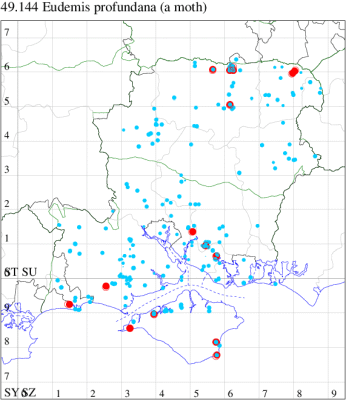
Records by year
Records by week (adult)
Records by week (larval)
Record Details
VC10: West High Down Quarry, one, 07 Aug (IOu); Cranmore, present, to actinic, 01 Aug (CHic); Bonchurch, one, 25 Jun (JHa); Shanklin, one, 26 Jul (IOu);
VC11: Botley Wood, one, ♀, gen det, 18 Sep (F.M.G. det. RJD); Fareham, one, to actinic, gen det, 17 Jul (MLO det. RJD); Botley, one, to actinic, 23 Aug (SLB); Tuckton, Bournemouth, one, 30 Jul (APar); Sway, one, 22 Jun (S&SL);
VC12: Axmansford, one, 04 Jul; one, 05 Aug (ACB det. GJD); Basingstoke, one, 06 Aug (RHil); Pamber Forest, three, 02 Sep; one, 13 Jul; one, 31 Jul; two, 07 Sep (GJD); Castle Bottom NNR, one, 25 Jun (JHH, AMD); Yateley*, one, 12 Aug (JHH)
49.145 [B&F: 1088] Pseudosciaphila branderiana (Linnaeus, 1758) - Nationally Scarce B
Nationally scarce (Nb) wherever there are stands of aspen, in woodland, gardens and parkland across much of southern England, occasionally north to Yorkshire. In Hampshire very local on a few sites, particularly Botley Wood and Pamber Forest, and seldom straying far. Not recorded from the Isle of Wight since 1900. Wingspan 21-27 mm. One of the largest of the British Olethreutines, this species is further characterised by the general forewing coloration and the obsolete or obsolescent markings; the typical almost unicolorous form and the fasciate f. wahlbomiana appear to be equally frequent in occurrence [Bradley]. Larva feeds on Aspen, living within a spun or rolled leaf.
Records prior to 2020
| Vice County | #Records | #Individuals | First Record | Last Record |
|---|---|---|---|---|
| 10 | 1 | 0 | 1900 | 1900 |
| 11 | 15 | 13 | 1900 | 2019 |
| 12 | 14 | 29 | 1959 | 2018 |
2020 records
| Vice County | #Records | #Individuals | Max Quantity |
|---|---|---|---|
| 12 | 1 | 1 | 1 |

Records by year
Records by week (adult)
Records by week (larval)
Record Details
VC12: Pamber Forest, one, 14 Jun (GJD)
49.146 [B&F: 1089] Apotomis semifasciana (Haworth, 1811) - Nationally Scarce B
Nationally scarce (Nb) in woodland and along freshwater margins throughout the British Isles, except in northern Scotland. In Hampshire virtually unknown away from Botley Wood, with just a handful of records elsewhere in the county and on the Isle of Wight. Wingspan 17-21 mm. Black and white forms may be confused with A. lineana, but A. semifasciana has broader forewing and lacks the greyish suffusion along the dorsum; another possible confusion species is A. infida but generally darker, with a less outwardly oblique inner edge of the median fascia, and more weakly angulate outer edge of the subbasal fascia [Bradley]. Larva feeds on catkins of Sallow, subsequently living within a leaf-fold.
Records prior to 2020
| Vice County | #Records | #Individuals | First Record | Last Record |
|---|---|---|---|---|
| 10 | 11 | 7 | 1893 | 2008 |
| 11 | 21 | 21 | 1980 | 2018 |
2020 records
| Vice County | #Records | #Individuals | Max Quantity |
|---|---|---|---|
| 11 | 1 | 1 | 1 |
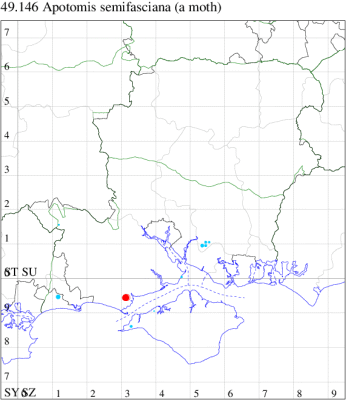
Records by year
Records by week (adult)
Records by week (larval)
Record Details
VC11: Pennington, one, 02 Jun (RFC)
49.149 [B&F: 1092] Apotomis turbidana Hübner, [1825] - Common
Common in woodland, especially of birch, and heathland throughout the British Isles. Common in Hampshire and on the Isle of Wight wherever there are birch trees. Wingspan 19-23 mm. The forewing pattern and contrasting comparatively clear white ground colour are characteristic [Bradley]. Larva feeds on Silver and Downy Birch, living between leaves spun together with silk.
Records prior to 2020
| Vice County | #Records | #Individuals | First Record | Last Record |
|---|---|---|---|---|
| 10 | 49 | 135 | 1929 | 2016 |
| 11 | 280 | 397 | 1971 | 2019 |
| 12 | 135 | 268 | 1976 | 2019 |
2020 records
| Vice County | #Records | #Individuals | Max Quantity |
|---|---|---|---|
| 11 | 10 | 13 | 2 |
| 12 | 12 | 22 | 4 |

Records by year
Records by week (adult)
Records by week (larval)
Record Details
VC11: Totton, one, 23 Jun (LH); Romsey, one, 09 Jun (NRJ); Kings Somborne, one, to actinic, 09 Jul; one, to actinic, 11 Jun; two, to actinic, 31 Jul; two, to actinic, 15 Jun (GCE); Wickham, one, 07 Aug (F.M.G. det. RJD); one, 09 Jun; one, 14 Jun; two, 15 Jun; one, 30 Jun; one, 07 Jul; one, 05 Aug (JRDS); West Meon, two, 31 Jul (F.M.G.); Burton, nr Christchurch, one, 09 Jun (JSw);
VC12: Barton Stacey, one, to actinic, 08 Jun (GCE); Pamber Forest, one, 30 May; three, 14 Jun; two, 06 Aug; two, 04 Jun; four, 08 Jun; two, 15 Jun; three, 17 Jun; one, 08 Jul; one, 06 Aug; one, 26 Aug (GJD); Warren Hill, Liss Forest*, one, 20 Jun (RJM)
49.150 [B&F: 1093] Apotomis betuletana (Haworth, 1811) - Common
Common in heathland, woodland edges and birch woodland throughout the British Isles. In Hampshire widespread and fairly common, but rather scarce on the Isle of Wight where there are just two records in 1974 and 1997. Wingspan 18-22 mm. Distinguished from A. capreana by having the outer edge of the coalescent median fascia and pre-tornal marking comparatively straight, the dark-coloured basal two-thirds of the wing more heavily marked with black, and the subterminal fascia usually lacking black dots [Bradley]. Larva feeds on Birch, living between leaves spun together with silk.
Records prior to 2020
| Vice County | #Records | #Individuals | First Record | Last Record |
|---|---|---|---|---|
| 10 | 19 | 19 | 1974 | 2019 |
| 11 | 538 | 891 | 1969 | 2019 |
| 12 | 279 | 732 | 1976 | 2019 |
2020 records
| Vice County | #Records | #Individuals | Max Quantity |
|---|---|---|---|
| 10 | 2 | 2 | 1 |
| 11 | 12 | 16 | 3 |
| 12 | 12 | 26 | 10 |
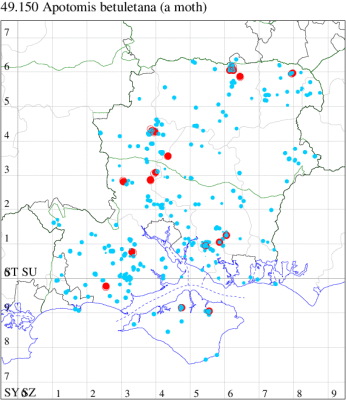
Records by year
Records by week (adult)
Records by week (larval)
Record Details
VC10: Parkhurst Forest, one, gen det, 05 Sep; Firestone Copse, one, gen det, 21 Jul (IOu);
VC11: Matley Wood, NF, present, 05 Aug (RBW, MWa); East Tytherley, one, to actinic, 14 Sep; one, to actinic, 10 Aug; Kings Somborne, one, to actinic, 09 Jul; two, to actinic, 31 Jul; one, to actinic, 09 Jul; one, to actinic, 03 Sep; one, to actinic, 07 Aug (GCE); Botley Wood, one, 18 Sep; Wickham Common, three, 11 Sep; West Walk, three, 14 Aug (F.M.G.); Sway, one, 08 Jun (S&SL);
VC12: Cholderton, one, field observation, 12 Sep (TJN, LF); Harewood Forest, one, to actinic, 23 Jul; one, to actinic, 23 Jul; one, to actinic, 23 Jul; Crawley, one, to actinic, 07 Sep (GCE); Bramley, one, 16 Aug (REA); Pamber Forest, two, 02 Sep; one, 14 Sep; three, 07 Aug; 10, 10 Aug; three, 15 Aug; one, 26 Aug; one, 07 Sep (GJD); Castle Bottom NNR, 11, 16 Aug; four, to actinic, 16 Aug (JHH)
49.151 [B&F: 1094] Apotomis capreana (Hübner, [1817]) - Local
Local in woodland, marshes, river-banks and by ditches in the southern half of England and Wales. Fairly widely distributed in Hampshire, but recorded only once on the Isle of Wight. Wingspan 18-22 mm. Differs from A. betuletana by its somewhat broader forewing, the costa being more strongly arched; further distinguished by the slightly concave outer edge of the median fascia and its hook-like indentation at the middle and the generally more strongly dilated and black-dotted subterminal fascia [Bradley]. Larva feeds on Goat Willow, living between leaves spun together with silk.
Records prior to 2020
| Vice County | #Records | #Individuals | First Record | Last Record |
|---|---|---|---|---|
| 10 | 36 | 57 | 1900 | 2018 |
| 11 | 164 | 188 | 1973 | 2019 |
| 12 | 95 | 144 | 1971 | 2019 |
2020 records
| Vice County | #Records | #Individuals | Max Quantity |
|---|---|---|---|
| 10 | 1 | 2 | 2 |
| 11 | 5 | 4 | 1 |
| 12 | 1 | 1 | 1 |

Records by year
Records by week (adult)
Records by week (larval)
Record Details
VC10: Firestone Copse, two, 21 Jul (IOu);
VC11: Kings Somborne, one, to actinic, 09 Jul (GCE); Southampton, one, to actinic, 24 Jun (MGP det. MJW); Kings Somborne*, one, to actinic, 15 Jun; one, to actinic, 15 Jul (GCE); Norleywood, NF, present, 09 Aug (RBW, MWa);
VC12: Pamber Forest, one, 23 Jun (GJD)
49.152 [B&F: 1095] Apotomis sororculana (Zetterstedt, 1839) - Nationally Scarce B
Nationally scarce (Nb) in woodland and heathland throughout much of the British Isles, less numerous in the south. In Hampshire there have been very few records of this species, reported from Romsey, Roydon Woods, Pennington and Merritown Heath in the current decade. Not recorded from the Isle of Wight to date. Wingspan 14-20 mm. Similar to A. turbidana but slightly smaller and with a narrower forewing; it differs further by the straighter and less strongly indented outer edge of the median fascia, the darker apex and cilia and by the lighter hindwing [Bradley]. Larva feeds on Birch, living between leaves spun together with silk, over-wintering as a pupa.
Records prior to 2020
| Vice County | #Records | #Individuals | First Record | Last Record |
|---|---|---|---|---|
| 11 | 11 | 14 | 1984 | 2018 |
2020 records
| Vice County | #Records | #Individuals | Max Quantity |
|---|---|---|---|
| 11 | 1 | 1 | 1 |

Records by year
Records by week (adult)
Records by week (larval)
Record Details
VC11: Pennington, one, 21 May (RFC)
49.153 [B&F: 1096] Apotomis sauciana (Frölich, 1828) - Local
Local in woodland and on moorland throughout much of England and Wales, and on moorland between 650 m and 950 m in northern Scotland. In Hampshire it is recorded occasionally in the New Forest and from one or two places in north Hampshire. On the Isle of Wight, there is one record at Newtown in 1975. Wingspan 15-18 mm. In size and general appearance this species is reminiscent of Endothenia gentianaeana, but differs in the generally darker blue-black coloration of the forewing and the smaller and comparatively inconspicuous marking on the submedian fold [Bradley]. Larva feeds on Bilberry, living between shoots spun together with silk.
Records prior to 2020
| Vice County | #Records | #Individuals | First Record | Last Record |
|---|---|---|---|---|
| 10 | 1 | 0 | 1975 | 1975 |
| 11 | 7 | 1 | 1982 | 2012 |
| 12 | 2 | 3 | 1994 | 2017 |
2020 records
| Vice County | #Records | #Individuals | Max Quantity |
|---|---|---|---|
| 12 | 1 | 5 | 5 |

Records by year
Records by week (adult)
Records by week (larval)
Record Details
VC12: Pamber Forest, five, 25 Jun (GJD)
49.154 [B&F: 1087] Orthotaenia undulana ([Denis & Schiffermüller], 1775) - Common
Common in woodland edges, hedgerows, dry pastures and scrub throughout much of the British Isles, less numerous in the north. In Hampshire and on the Isle of Wight widespread and reasonably common, but probably overlooked in some areas. Wingspan 15-20 mm. Some forms are reminiscent of C. lacunana but are distinguished by the inner margin of the median fascia not being incised or interrupted by a streak or lacuna [Bradley]. Larva feeds on deciduous trees and shrubs, living between leaves spun together with silk.
Records prior to 2020
| Vice County | #Records | #Individuals | First Record | Last Record |
|---|---|---|---|---|
| 10 | 34 | 36 | 1893 | 2017 |
| 11 | 109 | 117 | 1972 | 2019 |
| 12 | 37 | 39 | 1971 | 2018 |
2020 records
| Vice County | #Records | #Individuals | Max Quantity |
|---|---|---|---|
| 11 | 1 | 1 | 1 |
| 12 | 3 | 4 | 2 |

Records by year
Records by week (adult)
Records by week (larval)
Record Details
VC11: Marchwood, one, 26 May (CTh);
VC12: Pamber Forest, two, 14 Jun; one, 15 Jun; one, 17 Jun (GJD)
49.155 [B&F: 1086] Hedya salicella (Linnaeus, 1758) - Common
Common in woodland, gardens, orchards, parks and marshes throughout England and Wales. In Hampshire and on the Isle of Wight widely distributed, but not particularly common. Wingspan 18-24 mm. The distinctive forewing pattern readily distinguishes this moderately large and robust species [Bradley]. Larva feeds on White and Goat Willow, Black Poplar and Aspen, living between shoots spun together with silk.
Records prior to 2020
| Vice County | #Records | #Individuals | First Record | Last Record |
|---|---|---|---|---|
| 10 | 21 | 32 | 1951 | 2019 |
| 11 | 228 | 280 | 1983 | 2019 |
| 12 | 118 | 158 | 1993 | 2019 |
2020 records
| Vice County | #Records | #Individuals | Max Quantity |
|---|---|---|---|
| 11 | 2 | 2 | 1 |
| 12 | 1 | 1 | 1 |
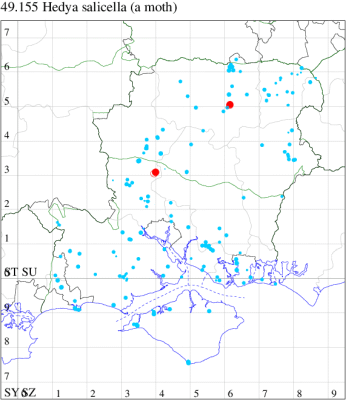
Records by year
Records by week (adult)
Records by week (larval)
Record Details
VC11: Kings Somborne, one, to actinic, 15 Jul; one, to actinic, 15 Jun (GCE);
VC12: Basingstoke, one, 24 Jun (RHil)
49.156 [B&F: 1083] Marbled Orchard Tortrix Hedya nubiferana (Haworth, 1811) - Common
Common in hedgerows, gardens and orchards throughout the British Isles. In Hampshire and on the Isle of Wight widespread and common throughout. Wingspan 15-21 mm. Very similar to Plum Tortrix H. pruniana, which differs in having the two black postmedian dots more prominent and situated costad of the projection of the outer edge of the median fascia [Bradley]. Larva feeds on many different deciduous trees and shrubs, including Hawthorn, Blackthorn and Wild Cherry, over-wintering in a cocoon.
Records prior to 2020
| Vice County | #Records | #Individuals | First Record | Last Record |
|---|---|---|---|---|
| 10 | 98 | 118 | 1900 | 2019 |
| 11 | 1072 | 1510 | 1971 | 2019 |
| 12 | 538 | 802 | 1971 | 2019 |
2020 records
| Vice County | #Records | #Individuals | Max Quantity |
|---|---|---|---|
| 10 | 3 | 4 | 2 |
| 11 | 23 | 33 | 4 |
| 12 | 32 | 44 | 4 |
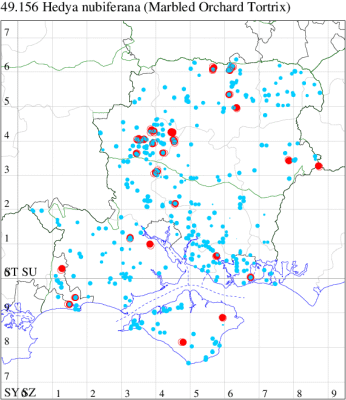
Records by year
Records by week (adult)
Records by week (larval)
Record Details
VC10: Kingston, one, 01 Jul; one, 02 Jul (ENes); Broadley Copse, two, to actinic, 25 Jun (JBa);
VC11: Brockwood, one, 13 Jun (SDut); Marchwood, one, 26 May (CTh); Woodlands, New Forest, present, 09 Jun (RBW); Kings Somborne, three, to actinic, 15 Jun; four, to actinic, 15 Jun; three, to actinic, 15 Jun; two, to actinic, 15 Jun (GCE); Southampton, one, to actinic, 22 Jun (MEdg); Allbrook, one, 02 Jun (SI); Kings Somborne, two, to actinic, 15 Jun; one, to actinic, 15 Jul (GCE); Fareham, one, to actinic, 01 Jun (MLO); Portsmouth, one, 24 May; one, 01 Jun; two, 20 Jun (IRT); Tuckton, Bournemouth, two, 22 Jun; one, 23 Jun; one, 25 Jun (APar); Burton, nr Christchurch, one, 26 May; one, 29 May; one, 02 Jun; one, 19 Jun; one, 23 Jun (JSw); Sway, one, 08 Jun (SKe);
VC12: Longstock, one, to actinic, 29 May; Chilbolton, one, to actinic, 07 Jun (GCE); Anna Valley, Andover, one, 20 May; one, 21 May (TJN); Goodworth Clatford, one, to actinic, 30 May; one, 30 May; Wherwell, one, to actinic, 13 Jun; two, to actinic, 13 Jun; Harewood Forest, one, to actinic, 24 Jun; one, to actinic, 24 Jun; one, to actinic, 24 Jun; Chilbolton, one, to actinic, 16 Jun; Barton Stacey, one, to actinic, 22 Jun; one, to actinic, 25 Jun; two, to actinic, 25 Jun; one, to actinic, 08 Jun; two, to actinic, 25 Jun; one, to actinic, 25 Jun; one, to actinic, 25 Jun; one, to actinic, 22 Jun; one, to actinic, 22 Jun (GCE); Axmansford, one, 02 Jun; one, 13 Jul (ACB); Cliddesden, one, 30 May; Basingstoke, two, 23 Jun (MJW); Pamber Forest, one, 30 May; three, 14 Jun; one, 25 May; two, 08 Jun; four, 15 Jun; three, 23 Jun (GJD); Whitehill, one, to actinic, 04 Jun; one, 20 Jun (ASto); Hammer Vale, Woolmer, one, 23 Jun (ASw)
49.157 [B&F: 1082] Plum Tortrix Hedya pruniana (Hübner, [1799]) - Common
Common in woodland, hedgerows and gardens throughout much of the British Isles. In Hampshire and on the Isle of Wight widespread and common throughout. Wingspan 15-18 mm. Similar to H. nubiferana but generally smaller, H. pruniana may be distinguished by the two blackish postmedian dots being situated distad of the medial angulation of the median fascia; in H. nubiferana these are situated costad of the projection [Bradley]. Larva feeds on Blackthorn, Plum and Wild Cherry.
Records prior to 2020
| Vice County | #Records | #Individuals | First Record | Last Record |
|---|---|---|---|---|
| 10 | 236 | 606 | 1900 | 2019 |
| 11 | 966 | 1428 | 1971 | 2019 |
| 12 | 364 | 576 | 1976 | 2019 |
2020 records
| Vice County | #Records | #Individuals | Max Quantity |
|---|---|---|---|
| 10 | 35 | 49 | 5 |
| 11 | 47 | 60 | 5 |
| 12 | 31 | 49 | 5 |

Records by year
Records by week (adult)
Records by week (larval)
Record Summary
VC10: Earliest: Shanklin, 12 May, 1 (IOu) Latest: Rookley, 15 Jul, 1 (JBa) Max count: Shanklin, 15 Jun, 5 (IOu)
VC11: Earliest: Portsmouth, 16 May, 1 (IRT) Latest: Bitterne, 08 Aug, 2 (PAB) Max count: Kings Somborne, 26 May, 5 (GCE)
VC12: Earliest: Barton Stacey, 19 May, 2 (GCE) Latest: Pamber Forest, 23 Jun, 1 (GJD) Max count: Pamber Forest, 17 Jun, 5 (GJD)
49.158 [B&F: 1084] Hedya ochroleucana (Frölich, 1828) - Common
Common in gardens, orchards and hedgerows throughout much of England and Wales, more numerous in the south. In Hampshire widespread and common throughout, but there have been no recent records from the Isle of Wight. Wingspan 16-21 mm. The comparatively lightly marked, ochreous-cream coloration in the distal part of the forewing is characteristic of this species [Bradley]. Larva feeds on Dog-rose, living between shoots spun together with silk.
Records prior to 2020
| Vice County | #Records | #Individuals | First Record | Last Record |
|---|---|---|---|---|
| 10 | 10 | 12 | 1850 | 2019 |
| 11 | 98 | 109 | 1980 | 2019 |
| 12 | 74 | 84 | 1971 | 2019 |
2020 records
| Vice County | #Records | #Individuals | Max Quantity |
|---|---|---|---|
| 11 | 2 | 2 | 1 |
| 12 | 3 | 3 | 1 |

Records by year
Records by week (adult)
Records by week (larval)
Record Details
VC11: Romsey, one, 17 Jun (NRJ); Sway, one, 25 Jun (SKe);
VC12: Cholderton*, one, 08 Aug (TJN, HE); Ecchinswell, one, field observation, 08 Jun; one, field observation, 13 Jun (MJN); Axmansford, one, 16 Aug (ACB)
49.161 [B&F: 1063] Celypha striana ([Denis & Schiffermüller], 1775) - Common
Common on dry pastures and downland throughout England and Wales. Widespread and common in Hampshire and on the Isle of Wight. Wingspan 15-20 mm. Distinguished from C. rosaceana and C. rufana by the strongly developed median fascia in the forewing [Bradley]. Larva feeds within roots of Dandelion.
Records prior to 2020
| Vice County | #Records | #Individuals | First Record | Last Record |
|---|---|---|---|---|
| 10 | 243 | 363 | 1880 | 2019 |
| 11 | 3797 | 6780 | 1970 | 2019 |
| 12 | 1539 | 2857 | 1971 | 2019 |
2020 records
| Vice County | #Records | #Individuals | Max Quantity |
|---|---|---|---|
| 10 | 36 | 69 | 4 |
| 11 | 231 | 311 | 4 |
| 12 | 71 | 92 | 3 |

Records by year
Records by week (adult)
Records by week (larval)
Record Summary
VC10: Earliest: Bonchurch, 26 May, 1 (JHa) Latest: Shanklin, 07 Aug, 1 (IOu) Max count: Bonchurch, 08 Jun, 4 (JHa)
VC11: Earliest: Dibden Purlieu, 09 May, 2 (RAC) Latest: Portsmouth, 07 Sep, 2 (IRT) Max count: Sway, 01 Jun, 10 (SKe)
VC12: Earliest: Farnborough, 18 May, 1 (KBW) Latest: Alton, 08 Sep, 1 (DBO) Max count: Cholderton, 17 Jul, 6 (TJN, HE)
49.162 [B&F: 1064] Celypha rosaceana Schläger, 1847 - Local
Local in rough pastures and grassland in parts of southern England, southern Wales and southern Ireland. In Hampshire and on the Isle of Wight records are widely, but very sparsely, distributed throughout. Wingspan 15-19 mm. The overall pink or pinkish buff general coloration of the forewing distinguishes this species from C. striana and C. rufana; furthermore, in C. striana the median fascia is strongly developed while in C. rufana the forewing is comparatively broad and the general coloration is darker, varying from dull olive-brown to ferruginous-brown [Bradley]. Larva feeds within roots of Sow-thistle and Dandelion.
Records prior to 2020
| Vice County | #Records | #Individuals | First Record | Last Record |
|---|---|---|---|---|
| 10 | 13 | 10 | 1880 | 2018 |
| 11 | 73 | 81 | 1972 | 2019 |
| 12 | 26 | 26 | 1993 | 2018 |
2020 records
| Vice County | #Records | #Individuals | Max Quantity |
|---|---|---|---|
| 10 | 3 | 4 | 2 |
| 11 | 6 | 6 | 2 |
| 12 | 2 | 2 | 1 |
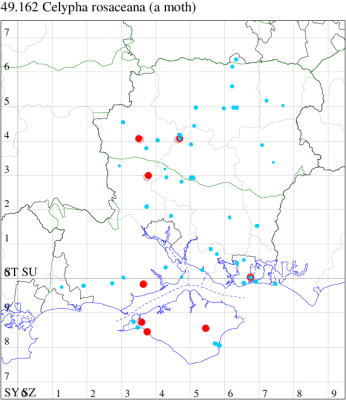
Records by year
Records by week (adult)
Records by week (larval)
Record Details
VC10: Freshwater, one, to actinic, 16 Sep (PBa); Shippards Chine, Compton Bay, one, 16 Jul; Haseley Manor, two, 11 Aug (IOu);
VC11: Ashley, one, to actinic, 23 Jun (GCE); Portsmouth, one, 24 Jun; one, 31 Jul; two, 10 Aug; one, 13 Aug (IRT); Norleywood, NF*, present, 09 Aug (RBW, MWa);
VC12: Goodworth Clatford, one, 30 May; Wonston, one, to actinic, 17 Jul (GCE)
49.164 [B&F: 1067] Celypha cespitana (Hübner, [1817]) - Local
Local on chalk downland, dry pastures, sand-hills and sea-cliffs throughout the British Isles, predominantly coastal in the north of its range. Widespread but distinctly uncommon in Hampshire and on the Isle of Wight. Wingspan 12-16 mm. Similar in forewing markings and coloration to the rare and local C. doubledayana, but usually larger and differs in the shape of the forewing, the costa being more gently arched and the apex more angular and prominent [Bradley]. Day-flying, occasionally comes to light. Larva feeds on Wild Thyme, Common Sea-lavender and Thrift.
Records prior to 2020
| Vice County | #Records | #Individuals | First Record | Last Record |
|---|---|---|---|---|
| 10 | 6 | 3 | 1900 | 2017 |
| 11 | 23 | 20 | 1975 | 2018 |
| 12 | 33 | 46 | 1971 | 2019 |
2020 records
| Vice County | #Records | #Individuals | Max Quantity |
|---|---|---|---|
| 12 | 2 | 2 | 1 |

Records by year
Records by week (adult)
Records by week (larval)
Record Details
VC12: Chilbolton*, one, to actinic, 16 Jun; Barton Stacey, one, to actinic, photograph taken., 08 Jun (GCE)
49.166 [B&F: 1076] Celypha lacunana ([Denis & Schiffermüller], 1775) - Common
Common on woodland edges and roadside verges and in rough grassland, hedgerows and gardens throughout the British Isles. Widespread and common in Hampshire and on the Isle of Wight. Wingspan 14-18 mm. Although extremely variable, this species can usually be distinguished from its near relatives by the strong indentation or lacuna in the median fascia above the middle, and in dark forms this indentation tends to become obscure but is seldom totally obliterated [Bradley]. Larva polyphagous on numerous herbaceous, and some woody, plants, living within a spun or rolled leaf.
Records prior to 2020
| Vice County | #Records | #Individuals | First Record | Last Record |
|---|---|---|---|---|
| 10 | 772 | 1889 | 1880 | 2019 |
| 11 | 7097 | 14872 | 1971 | 2019 |
| 12 | 3550 | 9574 | 1971 | 2019 |
2020 records
| Vice County | #Records | #Individuals | Max Quantity |
|---|---|---|---|
| 10 | 73 | 212 | 10 |
| 11 | 308 | 499 | 9 |
| 12 | 195 | 461 | 22 |
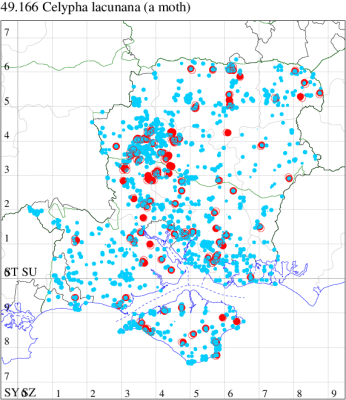
Records by year
Records by week (adult)
Records by week (larval)
Record Summary
VC10: Earliest: Newtown Meadows, 17 May, 1 (IOu) Latest: Shanklin, 20 Oct, 1 (IOu) Max count: Shanklin, 15 Jun, 10 (IOu)
VC11: Earliest: Southampton, 03 May, 1 (MEdg) Latest: Portsmouth, 22 Sep, 1 (IRT) Max count: Botley, 22 Aug, 9 (SLB)
VC12: Earliest: Pamber Forest, 27 Apr, 1 (GJD) Latest: Chilbolton, 15 Sep, 1 (GCE) Max count: Ropley, 26 May, 25 (TJN, LF)
49.169 [B&F: 1069] Celypha aurofasciana (Haworth, 1811) - Nationally Scarce A
Nationally scarce (Na) in woodland in parts of southern England and western Ireland. In Hampshire and on the Isle of Wight there are three old records, at Bembridge in 1875, Emery Down in 1900 and Baddesley Great Covert in 1929, but nothing was heard of it since until 2012, when it was found to be common in a Ventnor, Isle of Wight garden. Subsequently scattered reports have come in from a number of localities in mainland Hampshire, so it would appear to be increasing in range. Wingspan 12-14 mm. The narrow and apically rather rounded forewing and the typically conspicuous, broad, yellow fasciate area between the basal patch and median fascia distinguish this species; the specialised lobe at the base of the hindwing of the male is also characteristic [Bradley]. Larva feeds on various mosses and various liverworts, often on tree trunks, living within a silken tube or tent.
Records prior to 2020
| Vice County | #Records | #Individuals | First Record | Last Record |
|---|---|---|---|---|
| 10 | 29 | 47 | 1875 | 2015 |
| 11 | 6 | 4 | 1900 | 2019 |
2020 records
| Vice County | #Records | #Individuals | Max Quantity |
|---|---|---|---|
| 10 | 4 | 5 | 2 |
| 11 | 2 | 2 | 1 |
| 12 | 1 | 1 | 1 |
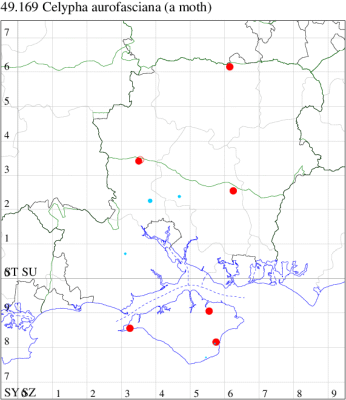
Records by year
Records by week (adult)
Records by week (larval)
Record Details
VC10: West High Down Quarry*, one, 07 Aug; Shanklin, one, 30 Jul; one, 08 Aug; Firestone Copse*, two, ♂ and ♀, gen det, 21 Jul (IOu);
VC11: Stockbridge Down NT*, one, to actinic, 24 Jul (GCE det. MJW); West Meon*, one, ♀, gen det, 31 Jul (F.M.G. det. IRT);
VC12: New Vice-county Record: Pamber Forest*, one, 25 Jun (GJD)
49.180 [B&F: 1079] Piniphila bifasciana (Haworth, 1811) - Local
Local, in pine woodland, throughout much of Britain and southern Ireland. In Hampshire, locally common in pinewoods, especially on Scots Pine in the south of the county; also on Maritime Pine, a species that is locally common along the coast. Very few records from the Isle of Wight to date. Wingspan 12-16mm. The comparatively rounded forewing, relatively straight-edged basal patch and well-defined, broad, almost parallel-sided median fascia, together with the pale ochreous general coloration, often tinged with pinkish, are characteristic [Bradley]. Larva feeds on Scots Pine and Maritime Pine, living within a silken gallery amongst the young shoots and male plants.
Records prior to 2020
| Vice County | #Records | #Individuals | First Record | Last Record |
|---|---|---|---|---|
| 10 | 24 | 27 | 1900 | 2019 |
| 11 | 176 | 177 | 1972 | 2019 |
| 12 | 51 | 62 | 1980 | 2018 |
2020 records
| Vice County | #Records | #Individuals | Max Quantity |
|---|---|---|---|
| 10 | 6 | 10 | 3 |
| 11 | 6 | 9 | 4 |
| 12 | 1 | 1 | 1 |
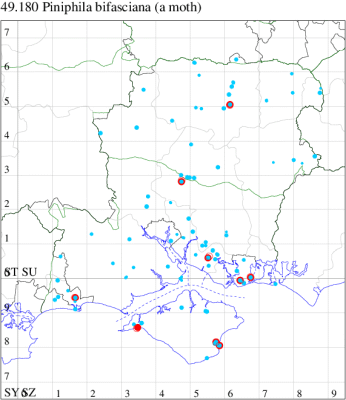
Records by year
Records by week (adult)
Records by week (larval)
Record Details
VC10: Freshwater Bay, one, 20 Sep (SDa); Shanklin, two, 15 Jun; three, 24 Jun; two, gen det, 25 Jun; one, 12 Jul; Shanklin Upper Chine, one, 31 Jul (IOu);
VC11: Winchester, one, 07 Jul (THW); Catisfield, one, 23 Jun; four, to actinic, 25 Jun (ALR); Portsmouth, one, 20 Jun (IRT); Burton, nr Christchurch, one, 30 Jun (JSw); Southsea, one, 24 Jun (JGe);
VC12: Anna Valley, Andover, one, 04 Aug (TJN); Basingstoke, one, 23 Jun (RHil)
49.183 [B&F: 1108] Lobesia abscisana (Doubleday, [1849]) - Common
Common on waste ground and in flower meadows in southern England, north to Yorkshire and west to Devon. Relatively common in Hampshire, but less so than the superficially similar Celypha lacunana, and very infrequently recorded on the Isle of Wight. Wingspan 12-14 mm. Larva feeds within stems of Creeping Thistle.
Records prior to 2020
| Vice County | #Records | #Individuals | First Record | Last Record |
|---|---|---|---|---|
| 10 | 55 | 54 | 1954 | 2019 |
| 11 | 414 | 652 | 1972 | 2019 |
| 12 | 129 | 181 | 1976 | 2019 |
2020 records
| Vice County | #Records | #Individuals | Max Quantity |
|---|---|---|---|
| 10 | 3 | 5 | 3 |
| 11 | 4 | 5 | 2 |
| 12 | 1 | 1 | 1 |

Records by year
Records by week (adult)
Records by week (larval)
Record Details
VC10: Freshwater Cliffs, one, 09 Jul (SDa); Shippards Chine, Compton Bay, three, ♂, gen det, 16 Jul; Shanklin, one, gen det, 10 Oct (IOu);
VC11: East Tytherley, two, to actinic, 10 Aug; Stockbridge Down NT, one, to actinic, 24 Jul; one, to actinic, 24 Jul; one, to actinic, 24 Jul (GCE); Sway, one, 25 Jun (SKe);
VC12: Alton, one, to actinic, 15 Aug (BCA)
49.184 [B&F: 1106] Lobesia reliquana (Hübner, [1825]) - Local
Local in woodland, gardens, orchards and parks throughout the British Isles. In Hampshire and Wight widespread and locally common. Wingspan 12-14 mm. Crepuscular. The narrow, sharply angled fore- and hindwings and the ferruginous general coloration of the forewing and its triangular, plumbeous and black dorsal patch are characteristic; the male is further distinguished by its white, apically infuscate hindwing [Bradley]. Larva feeds on shoots and leaves of Oak, Blackthorn and Birch.
Records prior to 2020
| Vice County | #Records | #Individuals | First Record | Last Record |
|---|---|---|---|---|
| 10 | 28 | 33 | 2009 | 2019 |
| 11 | 84 | 78 | 1972 | 2019 |
| 12 | 31 | 34 | 1971 | 2019 |
2020 records
| Vice County | #Records | #Individuals | Max Quantity |
|---|---|---|---|
| 10 | 1 | 1 | 1 |
| 11 | 2 | 2 | 1 |

Records by year
Records by week (adult)
Records by week (larval)
Record Details
VC10: Sandpit Copse, one, 20 May (IOu);
VC11: Kings Somborne, one, to actinic, 21 May; one, to actinic, 26 May (GCE);
VC12: Liss Common*, one, netted, 16 Jun (JHH, AMD)
49.185 [B&F: 1109] Lobesia littoralis (Westwood & Humphreys, 1845) - Local
Local on sea cliffs, saltmarshes, shingle beaches and gardens throughout much of the British Isles, predominantly coastal. In Hampshire common on the coast amongst sea-thrift, but has also become well-established in gardens where this plant is grown. On the Isle of Wight, largely restricted to the extreme south-western corner of the Island. Wingspan 12-15 mm. The largest of the British Lobesia species, it is distinguished by its comparatively narrow forewing with a normally well-defined median fascia and with the subbasal fascia forming a strong subquadrate blotch on the dorsum [Bradley]. Larva feeds on flowers and seedheads of Thrift.
Records prior to 2020
| Vice County | #Records | #Individuals | First Record | Last Record |
|---|---|---|---|---|
| 10 | 25 | 77 | 1880 | 2019 |
| 11 | 150 | 202 | 1973 | 2019 |
| 12 | 21 | 29 | 1993 | 2018 |
2020 records
| Vice County | #Records | #Individuals | Max Quantity |
|---|---|---|---|
| 10 | 3 | 7 | 5 |
| 11 | 4 | 4 | 1 |

Records by year
Records by week (adult)
Records by week (larval)
Record Details
VC10: Freshwater Cliffs, one, 11 May; five, 20 May; one, 09 Jul (SDa);
VC11: Romsey, one, 14 Aug; one, 16 Aug (MB); Portsmouth, one, gen det, 18 Aug (IRT); Pennington, one, 17 Aug (RFC)
49.186 [B&F: 1097] Endothenia gentianaeana (Hübner, [1799]) - Common
Common on rough ground and dry pastures throughout much of England and Wales, less numerous in the north. In Hampshire and on the Isle of Wight this species probably occurs wherever Teasel is established - even a few plants seems to suffice. Wingspan 15-19 mm. Generally larger than other species of Endothenia, it has the forewing ground colour more extensively tinged with ochreous distally and a usually distinct pale grey or pale violaceous grey patch from the tornus reaching half way across the wing to near the middle [Bradley]. Larva feeds within seedheads of Wild Teasel: opening old heads in winter seldom fails to produce evidence of the larva in the central pith; the larva itself may either be found in the head or inside the stalk.
Records prior to 2020
| Vice County | #Records | #Individuals | First Record | Last Record |
|---|---|---|---|---|
| 10 | 57 | 99 | 1880 | 2019 |
| 11 | 72 | 76 | 1971 | 2019 |
| 12 | 58 | 107 | 1985 | 2019 |
2020 records
| Vice County | #Records | #Individuals | Max Quantity |
|---|---|---|---|
| 10 | 11 | 9 | 1 |
| 11 | 7 | 9 | 3 |
| 12 | 2 | 2 | 1 |
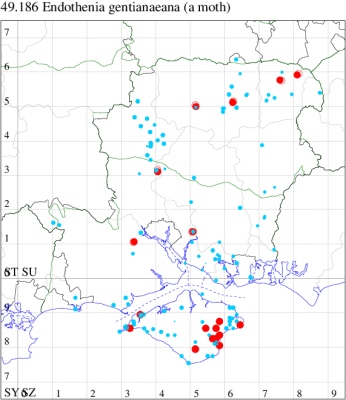
Records by year
Records by week (adult)
Records by week (larval)
Record Details
VC10: Tennyson Down, larva, one, field observation, incore of Dipsacus fullonum head, 25 Sep (PBa); Yarmouth, larva, present, field observation, in Teasel heads, 01 Jan; Southford, Whitwell, larva, one, field observation, single larva found in teasel heads, 02 Mar; Haseley Manor, one, gen det, 11 Aug; America Wood, larva, one, field observation, in teasel head, 16 Jan; Ninham, larva, one, field observation, larva in stem below teasel head, 20 Feb; Alverstone Mead, larva, present, field observation, larva in Teasel head, 18 Jan; Haddon's Pits, larva, one, field observation, 06 Jan; Lake, larva, one, field observation, found inside Teasel head, no comb, 03 Jan; Eaglehead Copse, Alverstone, larva, one, field observation, single teasel head examined, 29 Feb; Whitecliff Bay, larva, one, field observation, one teasel head examined, 18 Feb (IOu);
VC11: Ashurst, NF, one, 08 Aug (SAB); Kings Somborne, one, to actinic, 08 Sep (GCE); Botley, one, to actinic, 24 Jul; one, to actinic, 27 Jul; one, to actinic, 23 Jul; three, to actinic, 24 Jul; one, to actinic, 31 Jul (SLB); Bishop's Waltham, one, field observation, 03 Jul (DTr);
VC12: Overton Lagoons*, one, field observation, 17 May (PEH); Basingstoke, larva, one, field observation, in teasel head, 04 Feb (GSD); Hazeley Heath, larva, one, field observation, larva within seedhead of Wild Teasel; no anal comb present - checked with hand lens, 16 Nov; Yateley Common, larva, one, field observation, larva within seedhead of Wild Teasel; no anal comb present - checked with microscope, 12 Nov (JHH)
49.187 [B&F: 1098] Endothenia oblongana (Haworth, 1811) - Local
Local on field edges, chalk downland and flower meadows throughout much of England and Wales. In Hampshire recorded increasingly, mainly in the south-east of the county, and remaining rare away from the chalk; first reported from Wight in 2015. Wingspan 13-15 mm. Resembles a medium-sized E. gentianaeana but distinguished by the more broadly suffused apical area, which reduces or narrows the band of whitish ground colour beyond the median fascia, the more strongly dilated subterminal fascia, the pale patch from the tornus lacking a violaceous tinge, and by the paler hindwing [Bradley]. Despite what some publications say, the larva does not feed on Common Knapweed, but in the rootstock of Plantago lanceolata (Entomologist's Gazette (2010) Vol. 61).
Records prior to 2020
| Vice County | #Records | #Individuals | First Record | Last Record |
|---|---|---|---|---|
| 10 | 1 | 1 | 2015 | 2015 |
| 11 | 40 | 43 | 1971 | 2016 |
| 12 | 16 | 21 | 1981 | 2019 |
2020 records
| Vice County | #Records | #Individuals | Max Quantity |
|---|---|---|---|
| 12 | 1 | 1 | 1 |

Records by year
Records by week (adult)
Records by week (larval)
Record Details
VC12: Headley Gravel Pit*, one, field observation, 06 May (GJD)
49.188 [B&F: 1099] Endothenia marginana (Haworth, 1811) - Common
Common in rough ground, damp meadows, heathland and fens throughout the British Isles. In Hampshire only regular in the south-east; extremely scarce on the Isle of Wight. Wingspan 11-16 mm. The male of E. marginana can be distinguished from both sexes of E. gentianaeana and E. oblongana by its conspicuously white hindwings; the female is not so readily distinguished, having only the basal area of the hindwing paler. Both sexes can be usually separated from small specimens of E. gentianaeana by the narrow band of whitish ground colour beyond the median fascia of the forewing [Bradley]. Larva feeds within seedheads of Betony, Common Hemp-nettle, Lousewort and Yellow-rattle.
Records prior to 2020
| Vice County | #Records | #Individuals | First Record | Last Record |
|---|---|---|---|---|
| 10 | 15 | 24 | 1969 | 2018 |
| 11 | 314 | 440 | 1971 | 2019 |
| 12 | 45 | 53 | 1992 | 2018 |
2020 records
| Vice County | #Records | #Individuals | Max Quantity |
|---|---|---|---|
| 10 | 3 | 3 | 1 |
| 11 | 2 | 2 | 1 |
| 12 | 2 | 1 | 1 |

Records by year
Records by week (adult)
Records by week (larval)
Record Details
VC10: Freshwater Bay, one, to actinic, gen det, 15 Sep (PBa); Windy Corner, one, gen det, 14 Sep; Shanklin*, one, gen det, 22 Jun (IOu);
VC11: Ashley, one, to actinic, 07 Aug (GCE); Portsmouth, one, 12 Aug (IRT);
VC12: Chilbolton, one, to actinic, 15 Sep (GCE); Basingstoke, present, 23 Jun (MJW); Castle Bottom NNR, one, ♂, gen det, 25 Jun (JHH, AMD det. AMD); Yateley Common, larva, one, field observation, larva within seedhead of Wild Teasel; anal comb present - checked with microscope, 12 Nov (JHH)
49.190 [B&F: 1101] Endothenia ustulana (Haworth, 1811) - Nationally Scarce B
Nationally scarce (Nb) in woodland and waste ground in parts of England and Wales, mainly in the south and south-east. In Hampshire recorded very rarely away from Botley Wood, and there have been no recent records from the Isle of Wight. Wingspan 9-13 mm. The general coloration of the forewing is darker than in E. pullana, with which it has been thoroughly confused in the past; further distinguished by the darker hindwing and cilia [Bradley]. Larva feeds on Bugle.
Records prior to 2020
| Vice County | #Records | #Individuals | First Record | Last Record |
|---|---|---|---|---|
| 10 | 2 | 1 | 1900 | 2017 |
| 11 | 31 | 32 | 1976 | 2019 |
| 12 | 7 | 7 | 2002 | 2016 |
2020 records
| Vice County | #Records | #Individuals | Max Quantity |
|---|---|---|---|
| 11 | 8 | 11 | 3 |

Records by year
Records by week (adult)
Records by week (larval)
Record Details
VC11: Totton, one, 26 May; one, 02 Jun; one, 15 Jun; two, field observation, 15 Jun (LH); Romsey, one, field observation, 16 May; three, field observation, 23 May; one, field observation, seen on Mullein plants mid afternoon, 03 Jun (MB); Fareham, one, to actinic, gen det, 24 Jun (MLO det. RJD)
49.191 [B&F: 1102] Endothenia nigricostana (Haworth, 1811) - Local
Local in woodland and dry pastures throughout much of England and Wales. In Hampshire mainly restricted to the south-east and M3 corridor, but perhaps under-recorded; there are no recent records from the Isle of Wight. Wingspan 11-15 mm. The obscure fasciate markings of the forewing and the large, diffuse, yellow-ochreous dorsal blotch obliterating the median fascia except for a narrow bar at the costa are characteristic, but an inconspicuous and sluggish species, whose presence is sometimes only revealed by collecting dry old stems of hedge woundwort during the winter [Bradley]. Larva feeds within stems and roots of Hedge Woundwort.
Records prior to 2020
| Vice County | #Records | #Individuals | First Record | Last Record |
|---|---|---|---|---|
| 10 | 7 | 10 | 1900 | 2018 |
| 11 | 33 | 25 | 1974 | 2019 |
| 12 | 27 | 28 | 1971 | 2019 |
2020 records
| Vice County | #Records | #Individuals | Max Quantity |
|---|---|---|---|
| 11 | 1 | 1 | 1 |
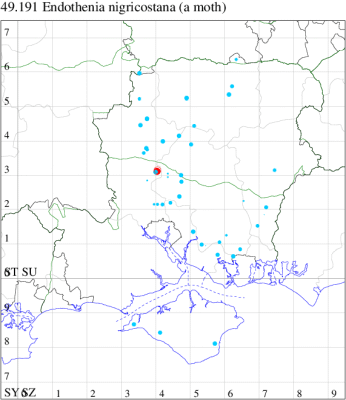
Records by year
Records by week (adult)
Records by week (larval)
Record Details
VC11: Kings Somborne, one, to actinic, 15 Jun (GCE)
49.193 [B&F: 1104] Endothenia quadrimaculana (Haworth, 1811) - Local
Local in water meadows, marshes and on river-banks throughout much of the British Isles. In Hampshire rather uncommon and sparsely distributed, mainly along the south coast, but also inland at Leckford, Selborne and around Basingstoke. On the Isle of Wight, confined to the extreme west of the Island. Wingspan 18-22 mm. Larger than E. ericetana and has the apex of the forewing more sharply angulate and retuse; differs further by the normally paler ground colour and the more contrasting markings, and by the blackish and more obtusely angled, central, blotch-like median fascia [Bradley]. Larva feeds within roots and lower stems of Marsh Woundwort and Spear Mint.
Records prior to 2020
| Vice County | #Records | #Individuals | First Record | Last Record |
|---|---|---|---|---|
| 10 | 9 | 4 | 1900 | 2015 |
| 11 | 52 | 54 | 1982 | 2019 |
| 12 | 21 | 22 | 1989 | 2019 |
2020 records
| Vice County | #Records | #Individuals | Max Quantity |
|---|---|---|---|
| 11 | 2 | 1 | 1 |
| 12 | 2 | 2 | 1 |
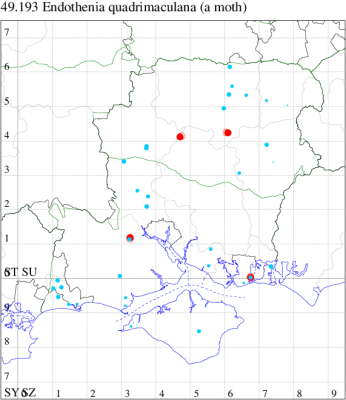
Records by year
Records by week (adult)
Records by week (larval)
Record Details
VC11: Woodlands, New Forest, present, 12 Aug (RBW); Portsmouth, one, 16 Jul (IRT);
VC12: Wonston*, one, to actinic, 17 Jul (GCE); Preston Candover*, one, 07 Aug (MJW)
49.194 [B&F: 1111] Bactra lancealana (Hübner, [1799]) - Common
Common in damp heathland, mosses, marshes, river-banks and moorland throughout the British Isles. Widespread and common in Hampshire and on the Isle of Wight. Wingspan 10-17 mm. Distinguished from B. furfurana by the crescent-shaped discocellular mark and the absence of a basal patch on the forewing; unicolorous specimens can only be separated by examination of the genitalia. Small specimens of B. robustana often resemble B. lancealana superficially and dissection of the genitalia may be necessary [Bradley]. Larva feeds within stems of Compact Rush, Common Club-rush and Deergrass.
Records prior to 2020
| Vice County | #Records | #Individuals | First Record | Last Record |
|---|---|---|---|---|
| 10 | 70 | 96 | 1900 | 2019 |
| 11 | 768 | 1300 | 1971 | 2019 |
| 12 | 181 | 516 | 1975 | 2019 |
2020 records
| Vice County | #Records | #Individuals | Max Quantity |
|---|---|---|---|
| 10 | 6 | 8 | 2 |
| 11 | 4 | 4 | 1 |
| 12 | 2 | 2 | 1 |

Records by year
Records by week (adult)
Records by week (larval)
Record Details
VC10: Newtown Meadows, two, gen det, 11 Jul; Haseley Manor, two, ♂s, gen det, 28 May; one, 11 Aug; Shanklin, one, gen det, 08 Aug; one, 16 Aug; one, 03 Sep (IOu);
VC11: Beaulieu Road, NF, one, field observation, 15 May (NRJ); Southampton, one, 30 May (MEdg); Wildern LNR, one, field observation, 21 Jul; one, field observation, 22 Sep (TCr det. GJD); Wickham, one, 07 Aug (F.M.G. det. RJD); Pennington, one, 29 Aug (MHay);
VC12: Barton Stacey, one, to actinic, 14 Aug (GCE); Pamber Forest, one, 06 Aug (GJD); Yateley*, one, 31 Jul (JHH)
49.195 [B&F: 1110] Bactra furfurana (Haworth, 1811) - Local
Local in marshes, river-banks and ditches throughout much of the British Isles. In Hampshire the majority of records are from the south-east corner of the county and from Christchurch, and although there are only a few inland records, it has been recorded in the northern half of the county on a number of occasions. Recorded on the Isle of Wight for the first time since 1900 at Cranmore in 2011. Wingspan 11-18 mm. The weakly reticulate ground colour, the presence of a dark basal patch and a comparatively well-developed median fascia distinguish this species from B. lancealana and small examples of B. robustana; weakly marked and unicolorous specimens can only be separated by examination of the genitalia [Bradley]. Larva feeds within stems of Common Club-rush and Compact Rush.
Records prior to 2020
| Vice County | #Records | #Individuals | First Record | Last Record |
|---|---|---|---|---|
| 10 | 4 | 3 | 1900 | 2018 |
| 11 | 55 | 115 | 1985 | 2019 |
| 12 | 6 | 6 | 1994 | 2015 |
2020 records
| Vice County | #Records | #Individuals | Max Quantity |
|---|---|---|---|
| 11 | 1 | 1 | 1 |

Records by year
Records by week (adult)
Records by week (larval)
Record Details
VC11: Portsmouth, one, 30 Jul (IRT)
49.197 [B&F: 1112] Bactra robustana (Christoph, 1872) - Nationally Scarce B
Nationally scarce (Nb) in saltmarshes on the south and east coasts of England, with records west to Devon and north to Yorkshire. In Hampshire and on the Isle of Wight locally common along the coast, especially around Langstone Harbour. Wingspan 16-23 mm. Larva feeds within stems of Sea Club-rush.
Records prior to 2020
| Vice County | #Records | #Individuals | First Record | Last Record |
|---|---|---|---|---|
| 10 | 6 | 4 | 1951 | 2012 |
| 11 | 128 | 157 | 1972 | 2019 |
| 12 | 1 | 1 | 2008 | 2008 |
2020 records
| Vice County | #Records | #Individuals | Max Quantity |
|---|---|---|---|
| 11 | 5 | 5 | 1 |
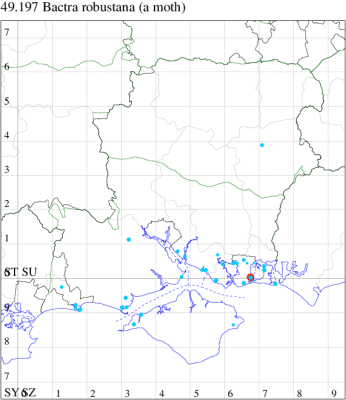
Records by year
Records by week (adult)
Records by week (larval)
Record Details
VC11: Chandlers Ford*, one, 12 Jul; one, 12 Jul (BE); Portsmouth, one, 30 Jul; one, 31 Jul; one, 07 Aug; one, 12 Aug; one, 13 Aug (IRT)
49.199 [B&F: 1217] Eucosmomorpha albersana (Hübner, [1813]) - Local
Local in open woodland and glades in parts of England and Wales. In Hampshire a local and rather rare species, chiefly confined to large woodlands such as the New Forest, Botley Wood and Pamber Forest. There have been no recent records from the Isle of Wight. Wingspan 13-17 mm. Distinguished by the sharply demarcated dark brown basal two-thirds of the forewing which contrasts with the orange-ochreous distal part of the wing [Bradley]. Larva feeds on Honeysuckle, living within a spun or rolled leaf.
Records prior to 2020
| Vice County | #Records | #Individuals | First Record | Last Record |
|---|---|---|---|---|
| 10 | 5 | 4 | 1900 | 2019 |
| 11 | 38 | 35 | 1976 | 2019 |
| 12 | 9 | 19 | 1976 | 2018 |
2020 records
| Vice County | #Records | #Individuals | Max Quantity |
|---|---|---|---|
| 11 | 3 | 3 | 1 |
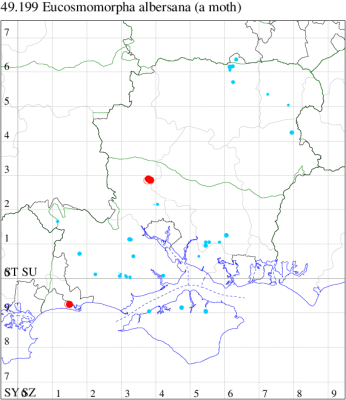
Records by year
Records by week (adult)
Records by week (larval)
Record Details
VC11: Kings Somborne, one, to actinic, 21 May; one, to actinic, 21 May (GCE); Tuckton, Bournemouth*, one, 23 Jun (APar)
49.200 [B&F: 1216] Cherry Bark Tortrix Enarmonia formosana (Scopoli, 1763) - Local
Local in gardens, parks and orchards throughout much of Britain, but not in northern Scotland. In Hampshire generally widespread, but perhaps over-looked in some areas. There have been no recent records from the Isle of Wight. Wingspan 15-19 mm. The distinctive coloration and pattern of the forewing, especially the well-developed ocellus and the sharply defined costal strigulae in the apical half which are bordered dorsad by ferruginous-orange, are characteristic [Bradley]. Larva feeds within bark of fruit trees.
Records prior to 2020
| Vice County | #Records | #Individuals | First Record | Last Record |
|---|---|---|---|---|
| 10 | 9 | 7 | 1856 | 2015 |
| 11 | 220 | 222 | 1972 | 2019 |
| 12 | 33 | 49 | 1995 | 2019 |
2020 records
| Vice County | #Records | #Individuals | Max Quantity |
|---|---|---|---|
| 10 | 2 | 2 | 1 |
| 11 | 10 | 11 | 2 |
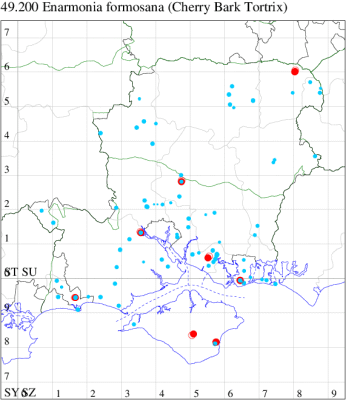
Records by year
Records by week (adult)
Records by week (larval)
Record Details
VC10: Rookley, one, 21 Jul (JBa); Shanklin, one, 24 Jun (IOu);
VC11: Totton, one, 21 May; one, 22 Jun (LH); Winchester, one, 07 Aug (THW); Catisfield, two, 24 Jun; one, to actinic, 25 Jun; one, 06 Jul (ALR); Burton, nr Christchurch, one, 02 Jun; one, 30 Jun; one, 15 Sep (JSw); Southsea, one, 05 Aug (JGe);
VC12: Yateley*, one, netted, 21 Jun; one, 26 May (JHH)
49.203 [B&F: 1123] Ancylis laetana (Fabricius, 1775) - Local
Local in woodland, gardens, orchards and parks throughout much of Britain. In Hampshire local in scattered locations, in the south from Mottisfont to Emer Bog, Botley Wood and Wickham Common in the north in Harewood Forest, Pamber Forest, Bartley Heath, Eelmoor Marsh and Fleet Pond. Two records in 2022 were the first for many decades from the Isle of Wight. Wingspan 13-18 mm. The contrasting white costal and grey-black dorsal areas of the forewing, together with the ferruginous apical area and the submetallic blue-grey ocellar area, are characteristic [Bradley]. Larva feeds on Aspen, living within a spun or rolled leaf.
Records prior to 2020
| Vice County | #Records | #Individuals | First Record | Last Record |
|---|---|---|---|---|
| 10 | 1 | 0 | 1900 | 1900 |
| 11 | 46 | 50 | 1976 | 2018 |
| 12 | 22 | 40 | 1974 | 2018 |
2020 records
| Vice County | #Records | #Individuals | Max Quantity |
|---|---|---|---|
| 11 | 1 | 1 | 1 |
| 12 | 2 | 2 | 1 |

Records by year
Records by week (adult)
Records by week (larval)
Record Details
VC11: Kings Somborne*, one, to actinic, 26 May (GCE);
VC12: Pamber Forest, one, 15 Jun; one, 24 Jul (GJD); Yateley, one, 26 May; one, 08 Aug (JHH)
49.205 [B&F: 1116] Ancylis comptana (Frölich, 1828) - Local
Local on chalk downland and limestone cliffs throughout much of England. In Hampshire and on the Isle of Wight locally common on chalk downland throughout, most notable on Broughton Down, Silchester Common and Old Winchester Hill. Wingspan 11-14 mm. Similar in size to A. obtusana, but differs in the dull brown general coloration of the forewing and the acutely angled apex [Bradley]. Larva feeds on Salad Burnet, Wild Strawberry, Cinquefoil and Wild Thyme, living within a spun or rolled leaf, and over-wintering either as a pupa or full-grown larva.
Records prior to 2020
| Vice County | #Records | #Individuals | First Record | Last Record |
|---|---|---|---|---|
| 10 | 37 | 77 | 1856 | 2018 |
| 11 | 39 | 97 | 1971 | 2019 |
| 12 | 40 | 197 | 1971 | 2014 |
2020 records
| Vice County | #Records | #Individuals | Max Quantity |
|---|---|---|---|
| 10 | 1 | 5 | 5 |
| 11 | 3 | 3 | 1 |
| 12 | 1 | 1 | 1 |

Records by year
Records by week (adult)
Records by week (larval)
Record Details
VC10: Mottistone Down, five, 20 Jun (IOu);
VC11: Kings Somborne, one, to actinic, 15 Jul (GCE); Eastleigh, one, to actinic, 18 Jul (KArb); Portsmouth, one, 16 Jul (IRT); Old Winchester Hill, one, field observation, 01 Aug (JHH, AMD); Southsea, one, 18 Jul (JGe);
VC12: Cholderton*, one, field observation, 22 Aug (TJN, LF); Anna Valley, Andover*, one, 20 Jul (TJN); Ecchinswell*, one, 22 Aug (MJN)
49.206 [B&F: 1121] Ancylis upupana (Treitschke, 1835) - Nationally Scarce B
Nationally scarce (Nb) in woodland and heathland in parts of southern England. In Hampshire rare, but also probably overlooked on account of its secretive habits; there are recent records from Chandlers Ford, Botley Wood, Southsea, Emer Bog, Havant Thicket and West Park, Damerham. Not recorded from the Isle of Wight to date. Wingspan 13-20 mm. A distinctive species in general appearance, characterised by the almost uniform dark brown or fuscous coloration of the forewing, with the exception of the apical and terminal areas which are ferruginous-orange [Bradley]. Larva feeds on Elm and Birch, living between leaves spun together with silk.
Records prior to 2020
| Vice County | #Records | #Individuals | First Record | Last Record |
|---|---|---|---|---|
| 11 | 20 | 23 | 1980 | 2018 |
| 12 | 2 | 2 | 1996 | 2018 |
2020 records
| Vice County | #Records | #Individuals | Max Quantity |
|---|---|---|---|
| 12 | 1 | 1 | 1 |

Records by year
Records by week (adult)
Records by week (larval)
Record Details
VC12: Harewood Forest*, one, to actinic, 23 May (GCE)
49.210 [B&F: 1125] Ancylis unculana (Haworth, 1811) - Nationally Scarce B
Nationally scarce (Nb) in woodland, downland and scrubland throughout much of southern England. In Hampshire locally common and exclusively on downland along the border between north and south Hampshire, on sites such as Stockbridge Down, Leckford, Porton Down, Magdalen Hill Down, Broughton Down and Micheldever Spoil Heaps. There have been no recent records from the Isle of Wight. Wingspan 13-18 mm. Readily distinguished from other species of Ancylis by the characteristic chestnut-brown forewing markings [Bradley]. Larva feeds on Buckthorn and Alder Buckthorn, living between leaves spun together with silk, over-wintering in a cocoon.
Records prior to 2020
| Vice County | #Records | #Individuals | First Record | Last Record |
|---|---|---|---|---|
| 10 | 1 | 1 | 2015 | 2015 |
| 11 | 29 | 24 | 1974 | 2019 |
| 12 | 148 | 191 | 1976 | 2019 |
2020 records
| Vice County | #Records | #Individuals | Max Quantity |
|---|---|---|---|
| 11 | 1 | 1 | 1 |
| 12 | 14 | 25 | 7 |
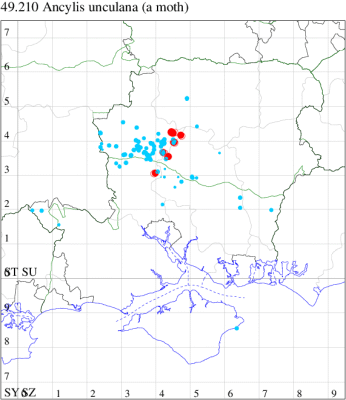
Records by year
Records by week (adult)
Records by week (larval)
Record Details
VC11: Kings Somborne, one, to actinic, 07 Aug (GCE);
VC12: Cholderton, three, 08 Aug (TJN, HE); one, field observation, 22 Aug (TJN, LF); Anna Valley, Andover, one, 02 Jun (TJN); Chilbolton, one, to actinic, 15 Sep; Crawley, one, to actinic, 12 Aug; Barton Stacey, two, to actinic, 14 Aug; one, to actinic, 14 Aug (GCE); Harestock, one, to actinic, 09 Jun; one, to actinic, 03 Sep (GRog); Barton Stacey, one, to actinic, 16 Jul; one, to actinic, 11 Aug; three, to actinic, 08 Jun; one, to actinic, 16 Jul; seven, to actinic, 11 Aug; two, to actinic, 16 Jul; one, to actinic, 08 Jun; one, to actinic, 16 Jul; one, to actinic, 11 Aug; Wonston , two, to actinic, 17 Jul (GCE)
49.212 [B&F: 1129] Ancylis apicella ([Denis & Schiffermüller], 1775) - Nationally Scarce B
Nationally scarce (Nb) in woodland and fens throughout much of southern England and southern Wales; rare in northern England. In Hampshire principally restricted to heathland in the New Forest and in the north-east of the county, and sites such as Emer Bog, Botley Wood, Wickham Common Havant Thicket and Pamber Forest. Recorded once on the Isle of Wight, at Cranmore SSSI in June 2003. Wingspan 13-17 mm. Characterised by the acutely angled median fascia of the forewing, which is very slender costally and forms a dark triangular patch medially [Bradley]. Larva feeds on Buckthorn and Alder Buckthorn, living between leaves spun together with silk, over-wintering in a cocoon.
Records prior to 2020
| Vice County | #Records | #Individuals | First Record | Last Record |
|---|---|---|---|---|
| 10 | 4 | 4 | 2003 | 2003 |
| 11 | 61 | 54 | 1971 | 2019 |
| 12 | 7 | 7 | 1995 | 2009 |
2020 records
| Vice County | #Records | #Individuals | Max Quantity |
|---|---|---|---|
| 11 | 1 | 2 | 2 |

Records by year
Records by week (adult)
Records by week (larval)
Record Details
VC11: Acres Down, two, 08 Aug (CWlk)
49.214 [B&F: 1126] Ancylis badiana ([Denis & Schiffermüller], 1775) - Common
Common in woodland, and on moorland, downland and waste ground throughout the British Isles. In Hampshire reasonably widespread and common, but distinctly uncommon on the Isle of Wight. Wingspan 12-17 mm. Flies in late afternoon. Differs from A. paludana by the darker general coloration of the forewing and the presence of never more than a single black dot at the base of the cilia below the subapical dash [Bradley]. Larva feeds on various species of Vetch, Vetchling and Clover, living between leaves spun together with silk, and over-wintering in a cocoon.
Records prior to 2020
| Vice County | #Records | #Individuals | First Record | Last Record |
|---|---|---|---|---|
| 10 | 8 | 8 | 1952 | 2018 |
| 11 | 281 | 350 | 1972 | 2019 |
| 12 | 150 | 232 | 1971 | 2019 |
2020 records
| Vice County | #Records | #Individuals | Max Quantity |
|---|---|---|---|
| 11 | 10 | 10 | 1 |
| 12 | 4 | 4 | 1 |

Records by year
Records by week (adult)
Records by week (larval)
Record Details
VC11: Kings Somborne, one, to actinic, 31 Jul (GCE); Romsey, one, 16 Jul (NRJ); Stockbridge Down NT, one, to actinic, 24 Jul; one, to actinic, 24 Jul; one, to actinic, 24 Jul (GCE); Allbrook, one, 23 Apr (SI); Winchester, one, 07 Aug (THW); West Meon, one, ♀, gen det, 31 Jul (F.M.G.);
VC12: Goodworth Clatford, one, to actinic, 23 Jul; Crawley, one, to actinic, 26 Aug; one, to actinic, 26 Aug (GCE); Old Burghclere, one, field observation, 24 May (GJD)
49.215 [B&F: 1115] Ancylis achatana ([Denis & Schiffermüller], 1775) - Common
Common in hedgerows, thickets and copses throughout much of southern England, with records north to Yorkshire. In Hampshire widespread and fairly common, but on the Isle of Wight only two recent records at Freshwater in 1993 and 1999. Wingspan 14-18 mm. Differs from other British Ancylis species by its obtusely falcate, broad forewing and comparatively well-defined fasciate markings which in the tornal area are developed into a prominent quadrate or triangular blotch [Bradley]. Larva feeds on Hawthorn and Blackthorn, living within a spun or rolled leaf.
Records prior to 2020
| Vice County | #Records | #Individuals | First Record | Last Record |
|---|---|---|---|---|
| 10 | 38 | 52 | 1900 | 2019 |
| 11 | 995 | 1395 | 1975 | 2019 |
| 12 | 421 | 643 | 1992 | 2019 |
2020 records
| Vice County | #Records | #Individuals | Max Quantity |
|---|---|---|---|
| 10 | 1 | 1 | 1 |
| 11 | 45 | 51 | 3 |
| 12 | 31 | 56 | 12 |

Records by year
Records by week (adult)
Records by week (larval)
Record Details
VC10: Parkhurst Forest, one, gen det, 29 Jun (IOu);
VC11: Woodlands, New Forest, present, 13 Jun (RBW); Totton, one, 02 Jun; one, 08 Jun; two, 21 Jun; one, 22 Jun; one, 24 Jun; one, 29 Jun; one, 30 Jun; one, 02 Jul (LH); Lee, one, 23 May (CTh); Romsey, two, 01 Jun; one, 13 Jun; three, 15 Jun; one, 23 Jun; one, 02 Jul; one, 06 Jul (MB); Southampton, one, 10 Jul (MEdg); one, to actinic, 02 Jul (MGP); Eastleigh, one, to actinic, 16 Jun; one, to actinic, 17 Jun (KArb); Allbrook, one, 30 May; one, 07 Jun; one, 15 Jun; one, 07 Jul (SI); Winchester, one, 29 May; two, 23 Jun; two, 07 Jul (THW); Fareham, one, 08 Jun; one, 09 Jun; one, 14 Jun; one, 23 Jun; one, 25 Jun; one, 06 Jul (ADT); two, 16 Jun; one, 24 Jun (IMcP); one, to actinic, 08 Jun; one, to actinic, 19 Jun; one, to actinic, 22 Jun (MLO); Bishop's Waltham, one, field observation, 01 Jul (DTr); Portsmouth, one, 19 Jun; one, 23 Jun; one, 24 Jun; one, 30 Jun; one, 15 Jul (IRT); Sway, one, 15 Jun; one, 17 Jun; two, 25 Jun; two, 01 Jul; one, 02 Jul (SKe);
VC12: Anna Valley, Andover, one, 23 Jun (TJN); Wherwell, one, to actinic, 29 Jun; one, to actinic, 29 Jun; one, to actinic, 13 Jun; Chilbolton, one, to actinic, 16 Jun; one, to actinic, 16 Jun; Crawley, one, to actinic, 09 Jun (GCE); Harestock, one, 12 Jun (GRog); Barton Stacey, two, to actinic, 08 Jun; three, to actinic, 08 Jun; one, to actinic, 25 Jun; one, to actinic, 16 Jul; one, to actinic, 08 Jun; one, to actinic, 25 Jun; one, to actinic, 16 Jul; one, to actinic, 25 Jun; one, to actinic, 08 Jun; one, to actinic, 25 Jun; one, to actinic, 16 Jul; one, to actinic, 25 Jun; one, to actinic, photograph taken., 08 Jun; one, to actinic, 25 Jun (GCE); Basingstoke, three, 24 Jun; two, 26 Jun (MJW); one, 01 Jun; eight, 23 Jun; 12, 24 Jun; one, 12 Jul; one, 23 Jul (RHil); Castle Bottom NNR, present, 25 Jun (JHH, AMD); Farnborough, one, 29 May; one, 16 Jun; one, 23 Jun; two, 25 Jun (KBW); Yateley, two, 08 Jun; four, 16 Jun; one, 09 Jun (JHH)
49.216 [B&F: 1120] Ancylis mitterbacheriana ([Denis & Schiffermüller], 1775) - Common
Common in deciduous woodland throughout the British Isles. Present in most if not all of the ancient woodland sites in Hampshire and the Isle of Wight. Wingspan 11-14 mm. In general, coloration similar to A. obtusana, but larger and differs in having a subquadrate basal patch which in A. obtusana is shallowly convex [Bradley]. Larva feeds on Oak and Beech, living within a spun or rolled leaf.
Records prior to 2020
| Vice County | #Records | #Individuals | First Record | Last Record |
|---|---|---|---|---|
| 10 | 18 | 25 | 1900 | 2017 |
| 11 | 179 | 215 | 1972 | 2019 |
| 12 | 63 | 81 | 1974 | 2018 |
2020 records
| Vice County | #Records | #Individuals | Max Quantity |
|---|---|---|---|
| 10 | 1 | 1 | 1 |
| 11 | 1 | 1 | 1 |
| 12 | 1 | 1 | 1 |
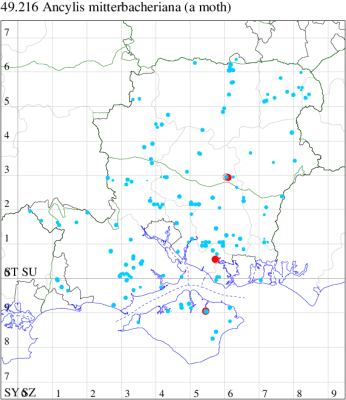
Records by year
Records by week (adult)
Records by week (larval)
Record Details
VC10: Sandpit Copse, one, 20 May (IOu);
VC11: Fareham, one, 02 Jun (IMcP);
VC12: Cheriton Wood, one, 08 Jun (DAS)
49.219 [B&F: 1204] Thiodia citrana (Hübner, [1799]) - Nationally Scarce B
Nationally scarce (Nb) in dry pastures and waste ground throughout much of England and Wales. In southern Hampshire and on the Isle of Wight, mainly coastal, but recorded once in northern Hampshire, in the Itchen Valley in 1968. There have been no recent records from the Isle of Wight. Wingspan 16-21 mm. Readily distinguished by the distinctive lemon-yellow general coloration of the forewing and the strong apical streak [Bradley]. Larva feeds within flowerheads of Yarrow, Field Wormwood and Stinking Chamomile, over-wintering in a cocoon.
Records prior to 2020
| Vice County | #Records | #Individuals | First Record | Last Record |
|---|---|---|---|---|
| 10 | 4 | 0 | 1900 | 1959 |
| 11 | 55 | 52 | 1974 | 2018 |
2020 records
| Vice County | #Records | #Individuals | Max Quantity |
|---|---|---|---|
| 11 | 1 | 1 | 1 |
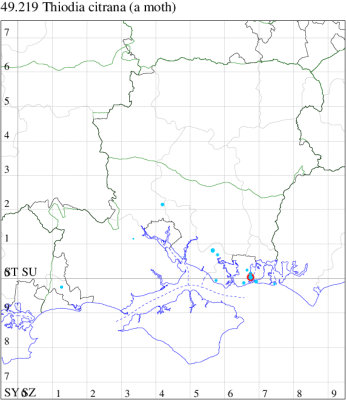
Records by year
Records by week (adult)
Records by week (larval)
Record Details
VC11: Portsmouth, one, 25 Jun (IRT)
49.221 [B&F: 1161] Rhopobota stagnana ([Denis & Schiffermüller], 1775) - Nationally Scarce B
Nationally scarce (Nb) in damp woodland and pastures (on Devil's-bit Scabious) and downland (on Small Scabious) throughout much of the British Isles. In Hampshire and on the Isle of Wight mainly confined to chalk downland sites such as Martin Down and Portsdown, and somewhat erratic in appearance. Wingspan 12-18 mm. The male differs from R. myrtillana by its larger size and the more uniform pale grey general coloration of the forewing; the female is often similar in size but can be distinguished by its relatively narrow and pointed forewing and the diffuse and obtusely angulated basal patch [Bradley]. Larva feeds on Small Scabious and Devil's-bit Scabious.
Records prior to 2020
| Vice County | #Records | #Individuals | First Record | Last Record |
|---|---|---|---|---|
| 10 | 19 | 22 | 1856 | 2018 |
| 11 | 20 | 21 | 1986 | 2015 |
| 12 | 5 | 7 | 1976 | 2015 |
2020 records
| Vice County | #Records | #Individuals | Max Quantity |
|---|---|---|---|
| 11 | 1 | 1 | 1 |

Records by year
Records by week (adult)
Records by week (larval)
Record Details
VC11: Winchester, one, 23 Jun (THW)
49.223 [B&F: 1159] Holly Tortrix Rhopobota naevana (Hübner, [1817]) - Common
Common in woodland, heathland and gardens throughout much of the British Isles. In Hampshire widespread and common, but there are only a few recent reports from the Isle of Wight. Wingspan 12-16 mm. The sinuate notch below the apex of the forewing in both sexes and the patches of specialised scales on the hindwing in the male are diagnostic characters of this species [Bradley]. Larva feeds on Holly, Apple, Hawthorn, Blackthorn, Buckthorn, Rowan and similar, living between leaves spun together with silk, over-wintering as an egg.
Records prior to 2020
| Vice County | #Records | #Individuals | First Record | Last Record |
|---|---|---|---|---|
| 10 | 73 | 91 | 1934 | 2019 |
| 11 | 363 | 438 | 1972 | 2019 |
| 12 | 97 | 221 | 1976 | 2019 |
2020 records
| Vice County | #Records | #Individuals | Max Quantity |
|---|---|---|---|
| 10 | 3 | 4 | 2 |
| 11 | 5 | 5 | 2 |
| 12 | 2 | 2 | 1 |

Records by year
Records by week (adult)
Records by week (larval)
Record Details
VC10: Parkhurst Forest, one, 29 Jun; two, 28 Jul; Shanklin, one, 09 Aug (IOu);
VC11: Woodlands, New Forest, present, 28 Jun (RBW); Winchester, one, 23 Jun (THW); Fareham, one, to actinic, 15 Jul (MLO); West Walk, two, 14 Aug (F.M.G. det. RJD); Sway, one, 24 Jun (SKe); Pilley Bailey, NF, one, 07 Jul (RBW, MWa);
VC12: Crawley, one, to actinic, 09 Jun (GCE); Pamber Forest, one, 13 Jul (GJD); Castle Bottom NNR, two, to actinic, 16 Aug; Yateley, one, 31 Jul; six, 08 Aug (JHH)
49.224 [B&F: 1205] Bud Moth Spilonota ocellana ([Denis & Schiffermüller], 1775) - Common
Common in orchards, woodland, gardens and parks throughout the British Isles, more numerous in the south. Widespread and common in Hampshire and on the Isle of Wight. Wingspan 12-16 mm. Characterised by the dense and well-defined basal patch, the usually prominent pre-tornal marking and the elongate ocellus of the forewing; the male is further distinguished by the antennal notch [Bradley]. The larva is polyphagous, showing a preference for woody Rosaceae such as apple, pear and hawthorn.
Records prior to 2020
| Vice County | #Records | #Individuals | First Record | Last Record |
|---|---|---|---|---|
| 10 | 105 | 162 | 1856 | 2019 |
| 11 | 1910 | 2579 | 1971 | 2019 |
| 12 | 376 | 533 | 1975 | 2019 |
2020 records
| Vice County | #Records | #Individuals | Max Quantity |
|---|---|---|---|
| 10 | 11 | 28 | 10 |
| 11 | 59 | 69 | 4 |
| 12 | 23 | 37 | 3 |
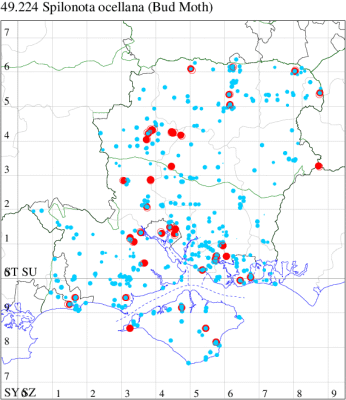
Records by year
Records by week (adult)
Records by week (larval)
Record Summary
VC10: Earliest: Shanklin, 17 Jun, 1 (IOu) Latest: Shanklin, 18 Aug, 1 (IOu) Max count: Shanklin, 24 Jun, 10 (IOu)
VC11: Earliest: Kings Somborne, 11 Jun, 1 (GCE) Latest: Pennington, 22 Sep, 1 (RFC) Max count: Wickham, 07 Aug, 4 (F.M.G.)
VC12: Earliest: Basingstoke, 10 Jun, 1 (MJW) Latest: Barton Stacey, 11 Aug, 1 (GCE) Max count: Harewood Forest, 24 Jun, 3 (GCE)
49.225 [B&F: 1205a] Spilonota laricana (Heinemann, 1863) - Local
Local in woodland with larch throughout England, Wales and southern Ireland. An uncommon and local species in Hampshire and Isle of Wight, and specimens away from extensive larch plantations need critical examination to separate from melanic ocellana. Wingspan 12-16 mm. Formerly regarded as a dark form of Bud Moth S. ocellana, from which distinguished by the comparatively narrow forewings and the nearly pure white ground colour coarsely strigulate with blackish grey [Bradley]. Larva feeds within bark of European Larch, living between needles spun together with silk, and over-wintering in a silken chamber.
Records prior to 2020
| Vice County | #Records | #Individuals | First Record | Last Record |
|---|---|---|---|---|
| 11 | 35 | 41 | 1975 | 2019 |
| 12 | 11 | 12 | 2005 | 2019 |
2020 records
| Vice County | #Records | #Individuals | Max Quantity |
|---|---|---|---|
| 12 | 1 | 1 | 1 |
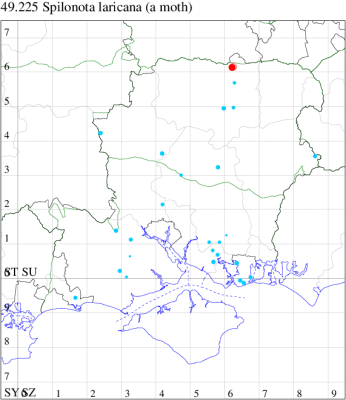
Records by year
Records by week (adult)
Records by week (larval)
Record Details
VC12: Pamber Forest*, one, 06 Aug (GJD)
49.231 [B&F: 1155] Epinotia brunnichana (Linnaeus, 1767) - Common
Common in birch woodland and on heathland throughout much of Britain, more frequently in the north. In Hampshire and on the Isle of Wight widespread and common. Wingspan 18-23 mm. The nominate and other fasciate forms of E. brunnichana may be confused with some forms of E. solandriana but can be distinguished by the shape of the dorsal blotch of ground colour which is subquadrate in E. brunnichana and not triangular as in E. solandriana; in E. brunnichana the outer edge of the subbasal fascia is less oblique dorsally [Bradley]. Larva feeds on Birch, Hazel and Sallow, living within a spun or rolled leaf.
Records prior to 2020
| Vice County | #Records | #Individuals | First Record | Last Record |
|---|---|---|---|---|
| 10 | 22 | 27 | 1934 | 2017 |
| 11 | 254 | 327 | 1971 | 2019 |
| 12 | 159 | 324 | 1980 | 2019 |
2020 records
| Vice County | #Records | #Individuals | Max Quantity |
|---|---|---|---|
| 10 | 1 | 1 | 1 |
| 11 | 5 | 10 | 6 |
| 12 | 3 | 4 | 2 |
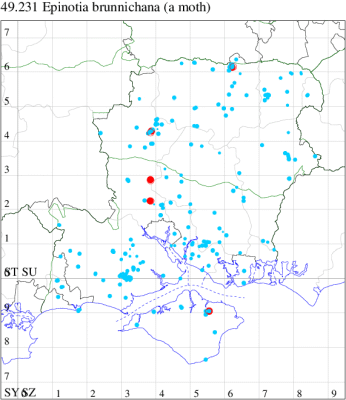
Records by year
Records by week (adult)
Records by week (larval)
Record Details
VC10: Firestone Copse, one, 21 Jul (IOu);
VC11: Romsey, one, 27 Jun; one, 07 Jul (NRJ); Kings Somborne, six, to actinic, 09 Jul (GCE);
VC12: Harewood Forest, one, to actinic, 23 Jul (GCE); Pamber Forest, one, 31 Jul; two, 10 Aug (GJD)
49.233 [B&F: 1156] Epinotia solandriana (Linnaeus, 1758) - Common
Common in woodland and scrubland throughout much of the British Isles. In Hampshire widespread and common, but with only scattered records from the Isle of Wight. Wingspan 15-21 mm. The nominate form of E. solandriana with the elongate-semiovate dorsal blotch on the forewing is distinctive, but forms with fasciate markings or with a white triangular blotch of ground colour dorsally can be confused with similar forms of E. brunnichana; in E. solandriana the dorsal blotch is triangular instead of subquadrate [Bradley]. Larva feeds on Birch, Hazel and Goat Willow, living within a spun or rolled leaf.
Records prior to 2020
| Vice County | #Records | #Individuals | First Record | Last Record |
|---|---|---|---|---|
| 10 | 9 | 5 | 1909 | 2018 |
| 11 | 91 | 103 | 1972 | 2018 |
| 12 | 35 | 47 | 1976 | 2018 |
2020 records
| Vice County | #Records | #Individuals | Max Quantity |
|---|---|---|---|
| 12 | 3 | 3 | 1 |

Records by year
Records by week (adult)
Records by week (larval)
Record Details
VC12: Preston Candover, one, 12 Jul; one, 12 Jul (MJW); Pamber Forest, one, 13 Jul (GJD)
49.234 [B&F: 1150] Epinotia abbreviana (Fabricius, 1794) - Common
Common in hedgerows and woodland throughout much of the British Isles, favouring low-lying areas. In Hampshire still fairly common, especially in the south-east, with scattered records in the north, but largely absent from the New Forest and on the Isle of Wight, where there are only two recent records. Wingspan 12-16 mm. Well-marked specimens are characterised by the well-defined basal patch, which is angular medially and broadly edged throughout with the light ground colour, and the median fascia being more or less edged throughout distally with plumbeous strigulation; in dark or almost unicolorous specimens this plumbeous strigulation is still evident [Bradley]. Larva feeds on buds of Elm, revealing a highly distinctive arc of holes, subsequently living within a spun leaf.
Records prior to 2020
| Vice County | #Records | #Individuals | First Record | Last Record |
|---|---|---|---|---|
| 10 | 9 | 3 | 1900 | 2010 |
| 11 | 97 | 181 | 1975 | 2019 |
| 12 | 8 | 9 | 1996 | 2017 |
2020 records
| Vice County | #Records | #Individuals | Max Quantity |
|---|---|---|---|
| 11 | 7 | 7 | 1 |
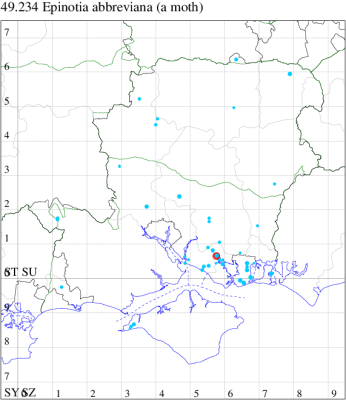
Records by year
Records by week (adult)
Records by week (larval)
Record Details
VC11: Fareham, one, to actinic, 07 Jun; one, to actinic, 19 Jun; one, to actinic, 23 Jun; one, to actinic, 01 Jul; one, to actinic, 06 Jul; one, to actinic, 16 Jul; one, to actinic, 23 Jul (MLO)
49.237 [B&F: 1144] Epinotia signatana (Douglas, 1845) - Local
Local in woodland, hedgerows and scrub in England and Wales, mostly in the south and east. In Hampshire local and uncommon, largely restricted to the south-east, where there is a notable population in Botley Wood; very rare in the New Forest and north of the county, and not recorded from the Isle of Wight until 2014. Wingspan 14-16 mm. Characterised by its rather nondescript general appearance and the comparatively prominent black discal streak [Bradley]. Larva feeds on Blackthorn, Wild Cherry and Bird Cherry, living between leaves and shoots spun together with silk.
Records prior to 2020
| Vice County | #Records | #Individuals | First Record | Last Record |
|---|---|---|---|---|
| 10 | 14 | 17 | 2014 | 2019 |
| 11 | 41 | 40 | 1973 | 2019 |
| 12 | 5 | 5 | 1987 | 2019 |
2020 records
| Vice County | #Records | #Individuals | Max Quantity |
|---|---|---|---|
| 10 | 4 | 4 | 1 |
| 11 | 1 | 1 | 1 |

Records by year
Records by week (adult)
Records by week (larval)
Record Details
VC10: Shanklin, one, gen det, 02 Jun; one, 12 Jun; one, gen det, 01 Jul; one, gen det, 08 Jul (IOu);
VC11: Totton, one, 24 Jun (LH)
49.238 [B&F: 1147] Willow Tortrix Epinotia cruciana (Linnaeus, 1761) - Local
Local in a wide range of habitats throughout much of the British Isles. In Hampshire almost exclusively confined to the south-east corner, especially Botley Wood, but also Havant Thicket, Swanwick, Titchfield Haven, Wickham Common and a few other sites. Elsewhere, there are a few records from the north-east of the county, and on the Isle of Wight the species was last recorded at Priory Bay in 1979. Wingspan 12-15 mm. The very oblique median fascia and the subterminal fascia, with which it is confluent, enclose a triangular patch of ground colour on the costa, forming a distinctive forewing pattern characteristic of this species [Bradley]. Larva feeds on terminal shoots of Creeping Willow, Eared Willow and Sallow, living between leaves spun together with silk.
Records prior to 2020
| Vice County | #Records | #Individuals | First Record | Last Record |
|---|---|---|---|---|
| 10 | 12 | 46 | 1979 | 2018 |
| 11 | 74 | 97 | 1972 | 2019 |
| 12 | 5 | 6 | 1993 | 2011 |
2020 records
| Vice County | #Records | #Individuals | Max Quantity |
|---|---|---|---|
| 12 | 1 | 1 | 1 |

Records by year
Records by week (adult)
Records by week (larval)
Record Details
VC11: Sway, one, 25 Jun (SKe);
VC12: Pamber Forest, one, 25 Jun (GJD)
49.240 [B&F: 1136] Epinotia immundana (Fischer von Röslerstamm, 1839) - Common
Common in woodland, heathland, marshes and river-banks throughout the British Isles. Widespread and common in Hampshire and on the Isle of Wight. Wingspan 12-15 mm. Similar to E. tetraquetrana but generally smaller and with darker coloration, and in E. immundana the basal patch of the forewing is acutely angulated medially, whereas in E. tetraquetrana the angle is obtuse [Bradley]. Larva feeds within catkins of Alder and Birch.
Records prior to 2020
| Vice County | #Records | #Individuals | First Record | Last Record |
|---|---|---|---|---|
| 10 | 30 | 30 | 1900 | 2019 |
| 11 | 637 | 898 | 1971 | 2019 |
| 12 | 215 | 427 | 1976 | 2019 |
2020 records
| Vice County | #Records | #Individuals | Max Quantity |
|---|---|---|---|
| 10 | 4 | 5 | 2 |
| 11 | 10 | 10 | 1 |
| 12 | 8 | 17 | 8 |
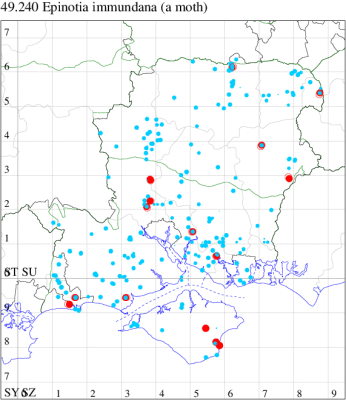
Records by year
Records by week (adult)
Records by week (larval)
Record Details
VC10: Haseley Manor, one, 28 May; Shanklin, two, ♂ and ♀, gen det, 20 Apr; one, 21 Apr; Shanklin Upper Chine, one, 20 Aug (IOu);
VC11: Romsey, one, 20 May (MB); one, 03 May (NRJ); Kings Somborne, one, to actinic, 21 May; one, to actinic, 03 Sep (GCE); Fareham, one, to actinic, 27 May (MLO); Botley, one, to actinic, 20 Sep (SLB); Wickham, one, 16 May; one, 17 May; one, 07 Jun (JRDS); Tuckton, Bournemouth, one, 09 May (APar); Burton, nr Christchurch, one, 21 May (JSw); Pennington, one, 08 Aug (RFC);
VC12: Pamber Forest, two, 05 Apr; two, 10 Apr; eight, 12 Apr; one, 16 Apr; one, 27 Apr (GJD); Liss Forest*, one, 10 Apr (RJM); Alton, one, to actinic, 21 May (BCA); Farnborough, one, 06 Aug (KBW)
49.242 [B&F: 1145] Epinotia nanana (Treitschke, 1835) - Nationally Scarce B
Nationally scarce (Nb) in coniferous woodland and plantations throughout much of the British Isles, but not in northern Scotland. In Hampshire local and uncommon, perhaps under-recorded due to its nondescript appearance. Not recorded from the Isle of Wight until 2020, when two specimens were taken in Shanklin. Wingspan 9-11 mm. The smallest of the British Epinotia species, characterised by its general dark coloration and obscure markings [Bradley]. Larva mines leaves of Norway Spruce, living between needles spun together with silk.
Records prior to 2020
| Vice County | #Records | #Individuals | First Record | Last Record |
|---|---|---|---|---|
| 11 | 17 | 19 | 1983 | 2019 |
| 12 | 5 | 5 | 2002 | 2017 |
2020 records
| Vice County | #Records | #Individuals | Max Quantity |
|---|---|---|---|
| 10 | 2 | 2 | 1 |
| 11 | 2 | 2 | 1 |

Records by year
Records by week (adult)
Records by week (larval)
Record Details
VC10: New Vice-county Record: Shanklin*, one, gen det, 24 Jun; one, gen det, 25 Jun (IOu);
VC11: Totton, one, 16 Jul; one, 06 Aug (LH)
49.243 [B&F: 1135] Epinotia demarniana (Fischer von Röslerstamm, 1840) - Local
Local in woodland, heathland, fens and bogs in parts of England and Wales. In Hampshire widespread but rather uncommon in birch woodland. Not recorded from the Isle of Wight to date. Wingspan 12-17 mm. Reminiscent of Epinotia trigonella and Epiblema scutulana but usually smaller and distinguished by its ochreous-white head and palpi [Bradley]. Larva feeds within catkins of Birch, Alder and Goat Willow.
Records prior to 2020
| Vice County | #Records | #Individuals | First Record | Last Record |
|---|---|---|---|---|
| 11 | 72 | 81 | 1973 | 2018 |
| 12 | 56 | 73 | 1971 | 2019 |
2020 records
| Vice County | #Records | #Individuals | Max Quantity |
|---|---|---|---|
| 12 | 2 | 2 | 1 |
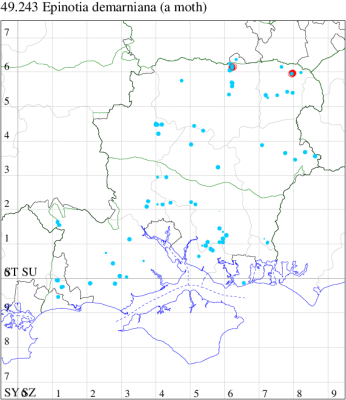
Records by year
Records by week (adult)
Records by week (larval)
Record Details
VC12: Pamber Forest, one, 18 May; one, 08 Jun (GJD); Castle Bottom NNR, one, 25 Jun (JHH, AMD)
49.244 [B&F: 1132] Epinotia subocellana (Donovan, 1806) - Common
Common in deciduous woodland and damp areas throughout much of the British Isles. In Hampshire formerly widespread and common, but in recent years barely annual, most frequently recorded in the south-east of the county and very erratic in appearance in the north and on the Isle of Wight. Wingspan 10-14 mm. Characterised by the comparatively clear cream-white antemedian band of ground colour which contrasts with the large metallic blue-grey ocellar patch and ferruginous apical area [Bradley]. Larva feeds on Sallow, living between leaves spun together with silk, over-wintering in a cocoon.
Records prior to 2020
| Vice County | #Records | #Individuals | First Record | Last Record |
|---|---|---|---|---|
| 10 | 7 | 6 | 1900 | 2018 |
| 11 | 60 | 68 | 1973 | 2019 |
| 12 | 20 | 20 | 1984 | 2018 |
2020 records
| Vice County | #Records | #Individuals | Max Quantity |
|---|---|---|---|
| 11 | 3 | 3 | 1 |

Records by year
Records by week (adult)
Records by week (larval)
Record Details
VC11: Kings Somborne, one, to actinic, 21 May (GCE); Dibden Purlieu, one, to actinic, 24 Jun (RAC); Kings Somborne*, one, to actinic, 26 May (GCE)
49.245 [B&F: 1137] Epinotia tetraquetrana (Haworth, 1811) - Common
Common in a wide range of habitats throughout much of the British Isles. In Hampshire confined to sites such as Chandlers Ford, Botley Wood, Emer Bog, Havant Thicket and Wickham Common in the south, and Winnall Moors, Harewood Forest, Pamber Forest, Odiham Common and Yately Common in the north. Not recorded from the Isle of Wight to date. Wingspan 12-16 mm. A slightly larger species than E. immundana and with generally lighter coloration; in E. tetraquetrana the medial angulation of the outer edge of the basal patch is obtuse, whereas in E. immundana it is acute [Bradley]. Larva feeds within bark of Birch and Alder, forming galls, over-wintering as a pupa in a cocoon.
Records prior to 2020
| Vice County | #Records | #Individuals | First Record | Last Record |
|---|---|---|---|---|
| 11 | 43 | 37 | 1975 | 2018 |
| 12 | 19 | 43 | 1976 | 2018 |
2020 records
| Vice County | #Records | #Individuals | Max Quantity |
|---|---|---|---|
| 12 | 1 | 1 | 1 |

Records by year
Records by week (adult)
Records by week (larval)
Record Details
VC12: Pamber Forest, one, 07 May (GJD)
49.248 [B&F: 1139] Nut Bud Moth Epinotia tenerana ([Denis & Schiffermüller], 1775) - Common
Common in woodland and freshwater margins throughout much of the British Isles. In Hampshire widespread and not uncommon, although there are few recent records from the New Forest, or from the Isle of Wight. Wingspan 12-16 mm. The predominantly ferruginous general coloration of the forewing is characteristic of this species; well-marked forms are somewhat reminiscent of A. mitterbacheriana, but the latter is distinguished by the falcate apex of the forewing [Bradley]. Larva feeds within catkins of Hazel and Alder, subsequently burrowing into and feeding on leaf buds.
Records prior to 2020
| Vice County | #Records | #Individuals | First Record | Last Record |
|---|---|---|---|---|
| 10 | 44 | 67 | 1926 | 2019 |
| 11 | 95 | 89 | 1980 | 2019 |
| 12 | 46 | 40 | 1980 | 2019 |
2020 records
| Vice County | #Records | #Individuals | Max Quantity |
|---|---|---|---|
| 10 | 13 | 19 | 4 |
| 11 | 6 | 6 | 1 |
| 12 | 4 | 5 | 2 |

Records by year
Records by week (adult)
Records by week (larval)
Record Details
VC10: Parkhurst Forest, one, to light, 05 Sep; Shanklin, one, 01 Jul; one, 05 Jul; one, 07 Jul; four, 09 Aug; one, 14 Aug; one, 16 Sep; four, 19 Sep; one, 28 Sep; one, 07 Oct; one, 14 Oct; one, 18 Oct; one, 19 Oct (IOu);
VC11: Kings Somborne, one, to actinic, 28 Sep; one, to actinic, 28 Sep (GCE); Botley Wood, one, ♀, gen det, 18 Sep; Wickham, one, ♀, gen det, 07 Aug; Hen Wood, one, ♀, gen det, 04 Sep (F.M.G. det. RJD); Sway*, one, 25 Jun (SKe);
VC12: Cholderton, one, 24 Jul (TJN, HE); Pamber Forest, one, 01 Jul; one, 08 Jul; one, 13 Aug; two, 28 Sep (GJD); Finchampstead*, two, field observation, 07 Jul (JHH)
49.249 [B&F: 1134] Epinotia ramella (Linnaeus, 1758) - Common
Common in birch woodland throughout much of the British Isles. In Hampshire widespread and common throughout. On the Isle of Wight, the only recent record is of one in Combley Great Wood in October 2005. Wingspan 13-16 mm. Distinguished from E. bilunana by the grey general appearance of the forewing and particularly the comparatively solid and sharply defined triangular patch on the dorsum; the male of E. ramella lacks the costal fold on the forewing [Bradley]. E. ramella flies later in the year than the similar E. bilunana and, like that species, comes freely to light. Larva feeds within catkins of Birch.
Records prior to 2020
| Vice County | #Records | #Individuals | First Record | Last Record |
|---|---|---|---|---|
| 10 | 11 | 9 | 1900 | 2017 |
| 11 | 312 | 502 | 1969 | 2019 |
| 12 | 121 | 163 | 1974 | 2019 |
2020 records
| Vice County | #Records | #Individuals | Max Quantity |
|---|---|---|---|
| 10 | 2 | 2 | 1 |
| 11 | 7 | 13 | 4 |
| 12 | 4 | 5 | 2 |
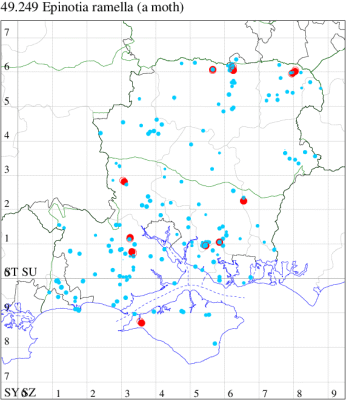
Records by year
Records by week (adult)
Records by week (larval)
Record Details
VC10: Freshwater, one, to actinic, 14 Sep; one, to actinic, 15 Sep (PBa);
VC11: Matley Wood, NF, present, 05 Aug (RBW, MWa); Woodlands, New Forest, present, 05 Aug (RBW); East Tytherley, one, to actinic, 14 Sep (GCE); Botley Wood, three, 18 Sep; four, 18 Sep; Wickham Common, four, 11 Sep; Hen Wood, one, 04 Sep (F.M.G.);
VC12: Cholderton, one, field observation, 05 Sep (TJN, LF); Axmansford, one, 03 Sep (ACB); Pamber Forest, one, 06 Aug; one, 15 Aug; two, 07 Sep (GJD); Castle Bottom NNR, two, 16 Aug; Yateley*, one, 31 Jul; two, 08 Aug; one, 17 Aug; four, 08 Sep (JHH)
49.252 [B&F: 1142] Epinotia tedella (Clerck, 1759) - Common
Common in coniferous woodland throughout much of the British Isles. In Hampshire and on the Isle of Wight XXXX. Wingspan 10-13 mm. In this species the fore- and hindwing coloration is brown compared with the grey-brown appearance of E. nemorivaga; E. tedella may be further distinguished by the cream-white labial palpus and head and the distinct basal and subbasal fasciae which do not form a basal patch as in E. nemorivaga [Bradley]. Larva mines needles of Norway Spruce, subsequently living within a spinning.
Records prior to 2020
| Vice County | #Records | #Individuals | First Record | Last Record |
|---|---|---|---|---|
| 10 | 2 | 2 | 1930 | 1978 |
| 11 | 82 | 120 | 1972 | 2018 |
| 12 | 9 | 9 | 1976 | 2016 |
2020 records
| Vice County | #Records | #Individuals | Max Quantity |
|---|---|---|---|
| 12 | 1 | 1 | 1 |
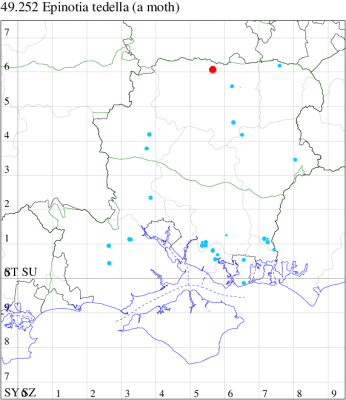
Records by year
Records by week (adult)
Records by week (larval)
Record Details
VC11: Sway*, one, photo?, 30 May (SKe);
VC12: Axmansford*, one, 09 May (ACB det. GJD)
49.254 [B&F: 1133] Epinotia bilunana (Haworth, 1811) - Common
Common in birch woodland, heathland and gardens throughout much of the British Isles. In Hampshire a common and widespread species of birch woodland. On the Isle of Wight, only recorded in the extreme west of the Island. Wingspan 13-17 mm. This species is characterised by the general cream-white appearance of the forewing, with contrasting blackish but somewhat diffuse markings on the dorsum [Bradley]. It flies earlier in the year than the similar E. ramella and comes freely to light. Larva feeds within catkins of Birch.
Records prior to 2020
| Vice County | #Records | #Individuals | First Record | Last Record |
|---|---|---|---|---|
| 10 | 30 | 72 | 1996 | 2019 |
| 11 | 650 | 898 | 1971 | 2019 |
| 12 | 257 | 447 | 1974 | 2019 |
2020 records
| Vice County | #Records | #Individuals | Max Quantity |
|---|---|---|---|
| 10 | 1 | 1 | 1 |
| 11 | 21 | 27 | 3 |
| 12 | 18 | 25 | 4 |

Records by year
Records by week (adult)
Records by week (larval)
Record Details
VC10: Shanklin, one, 07 Jun (IOu);
VC11: Marchwood, one, 26 May (CTh); Ashurst, NF, one, 27 May (SAB); Totton, one, 21 May (LH); Romsey, one, 26 May (SLay); Southampton, one, 26 May; one, 08 Jun (MEdg); Eastleigh, one, to actinic, 17 May; one, to actinic, 19 May; one, to actinic, 24 May (KArb); Allbrook, one, 02 Jun; one, 23 Jun (SI); Catisfield, one, 23 Jun (ALR); Fareham, one, 08 Jun (ADT); one, to actinic, 24 May (MLO); Botley, one, to actinic, 11 Jun (SLB); Wickham, one, 25 May (JRDS); Burton, nr Christchurch, three, 21 May; two, 29 May; one, 02 Jun; one, 06 Jun; three, 09 Jun; one, 19 Jun (JSw); Sway, one, 26 May (SKe); Pennington, one, 21 May; one, 27 May; two, 02 Jun (RFC);
VC12: Harewood Forest, one, to actinic, 24 Jun; one, to actinic, 24 Jun; one, to actinic, 24 Jun; Crawley, one, to actinic, 09 Jun (GCE); Harestock, one, to actinic, 26 May; one, to actinic, 09 Jun (GRog); Ropley*, one, 26 May (TJN, LF); Basingstoke, one, 26 May; one, 27 May (MJW); one, to actinic, 26 Jun (JHu); one, 26 May (RHil); Pamber Forest, one, 18 May; four, 04 Jun; four, 08 Jun; two, 10 Jun; one, 15 Jun; one, 23 Jun (GJD); Liss Forest, one, 14 Jun (RJM); Alton, one, to actinic, 15 Jun (BCA); Castle Bottom NNR, present, 25 Jun (JHH, AMD); Farnborough, one, 21 May; one, 23 Jun (KBW)
49.255 [B&F: 1138] Epinotia nisella (Clerck, 1759) - Common
Common in woodland, parks, marshes and freshwater margins throughout the British Isles. Widely distributed across much of Hampshire and the Isle of Wight. Wingspan 12-17 mm. Differs from other Epinotia species of comparable size by its characteristic grey or cinereous coloration which, though often reduced, is present throughout its range of variation. Larva feeds within catkins of Salix and Populus sp. The distribution of f. cinereana, now considered to be a separate species (Epinotia cinereana), appears to be dependent on the presence of Aspen.
Records prior to 2020
| Vice County | #Records | #Individuals | First Record | Last Record |
|---|---|---|---|---|
| 10 | 49 | 54 | 1900 | 2019 |
| 11 | 427 | 513 | 1969 | 2019 |
| 12 | 310 | 684 | 1975 | 2019 |
2020 records
| Vice County | #Records | #Individuals | Max Quantity |
|---|---|---|---|
| 10 | 3 | 5 | 3 |
| 11 | 21 | 39 | 7 |
| 12 | 12 | 22 | 5 |
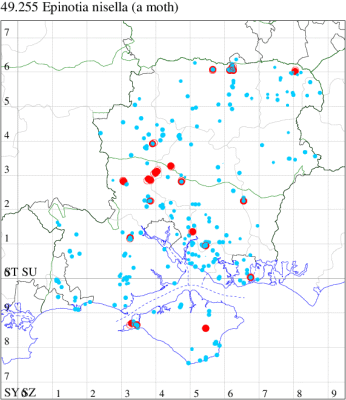
Records by year
Records by week (adult)
Records by week (larval)
Record Details
VC10: Totland, one, 20 Sep (RTe); Afton Marsh, three, to light, 28 Sep; Haseley Manor, one, gen det, 11 Aug (IOu);
VC11: Woodlands, New Forest, present, 11 Sep (RBW); East Tytherley, one, to actinic, 10 Aug; two, to actinic, 10 Aug; seven, to actinic, 10 Aug; three, to actinic, 14 Sep; Kings Somborne, one, to actinic, 28 Sep (GCE); Romsey, one, 07 Jul (NRJ); Kings Somborne, one, to actinic, 03 Sep; one, to actinic, 07 Aug; one, to actinic, 08 Sep; one, to actinic, 07 Aug; two, to actinic, 08 Sep (GCE); Eastleigh, one, to actinic, 30 Jul (KArb); Winchester, one, 07 Aug (THW); Kings Somborne, two, to actinic, 07 Aug (GCE); Botley Wood, five, 18 Sep; five, 18 Sep; one, ♀, gen det, 23 Oct (F.M.G.); Botley, one, to actinic, 16 Aug (SLB); Wickham, one, 16 Sep (JRDS); Portsmouth, one, 09 Aug (IRT); Hen Wood, one, 04 Sep (F.M.G.);
VC12: Chilbolton, two, to actinic, 16 Sep (SLE det. GCE); Anna Valley, Andover, one, field observation, 11 Aug (TJN, LF); Crawley, one, to actinic, 09 Jun (GCE); Axmansford, one, 05 Aug; two, 03 Sep (ACB); Pamber Forest, two, 02 Sep; one, 13 Jul; two, 24 Jul; five, 31 Jul; one, 07 Aug; two, 10 Aug; two, 07 Sep; one, 07 Sep (GJD); Yateley*, one, 31 Jul (JHH)
49.256 [B&F: 1138a] Epinotia cinereana (Haworth, 1811) - Local
Recently separated from Epinotia nisella. Distribution in Hampshire and Isle of Wight unclear - reported from scattered localities in VC11 and VC12 to date.
Although Epinotia cinereana was considered a distinct species and was included in Pierce & Metcalfeis The Genitalia of the British Tortricidae (1914) which documented clear differences in the genitalia, this treatment was not followed by Bradley et al in their 1972 British
checklist; Razowski also omitted the species from his European Tortricidae publications.
Mutanen et al, 2012 (Zootaxa) discussed the two species in their Holarctic study and laid out a clear case for their separation.
Epinotia cinereana has the blackish or reddish blotches in the forewing absent and gives an overall greyish impression showing blackish streaks in the forewing. The larvae are said to feed between spun leaves of Aspen Populus tremula. Epinotia nisella usually shows a more highly patterned forewing with blotches of black or reddish in the forewing or along the dorsum; in rare instances they can appear wholly greyish like E. cinereana. For new localities, and where Aspen is not found, specimens should be retained for examination of the genitalia for separation.
Records of this species would be particularly welcome, especially from localities which are known to be close to Aspen stands.
Records prior to 2020
| Vice County | #Records | #Individuals | First Record | Last Record |
|---|---|---|---|---|
| 11 | 9 | 11 | 1982 | 2018 |
| 12 | 2 | 2 | 2010 | 2016 |
2020 records
| Vice County | #Records | #Individuals | Max Quantity |
|---|---|---|---|
| 11 | 2 | 2 | 1 |
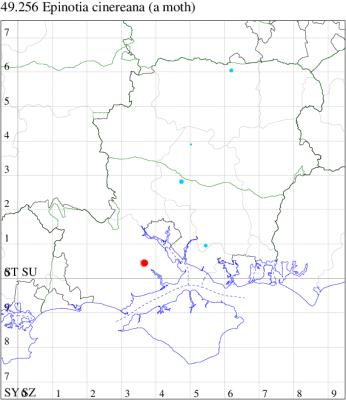
Records by year
Records by week (adult)
Records by week (larval)
Record Details
VC11: Culverley, NF*, one, 19 Jul (CL)
49.260 [B&F: 1165] Zeiraphera isertana (Fabricius, 1794) - Common
Common in oak woodland throughout the British Isles. Widespread and fairly common in Hampshire and on the Isle of Wight. Wingspan 13-18 mm. Similar to, but larger than, Larch Tortrix Z. griseana, and differing in having smaller dorsal patch than griseana. Larva feeds on Oak, living between leaves spun together with silk.
Records prior to 2020
| Vice County | #Records | #Individuals | First Record | Last Record |
|---|---|---|---|---|
| 10 | 109 | 269 | 1856 | 2019 |
| 11 | 468 | 500 | 1972 | 2019 |
| 12 | 127 | 206 | 1976 | 2018 |
2020 records
| Vice County | #Records | #Individuals | Max Quantity |
|---|---|---|---|
| 10 | 8 | 25 | 14 |
| 11 | 17 | 16 | 2 |
| 12 | 4 | 7 | 3 |

Records by year
Records by week (adult)
Records by week (larval)
Record Details
VC10: Shanklin, one, 24 Jun; 14, 25 Jun; one, 08 Jul; two, 17 Jul; two, 26 Jul; one, 30 Jul; one, 06 Aug; Firestone Copse, three, 21 Jul (IOu);
VC11: Woodlands, New Forest, present, 08 Jul (RBW); East Tytherley, one, to actinic, 10 Aug (GCE); Romsey, one, 20 Jun; one, 29 Jun (NRJ); Ashley, one, to actinic, 22 Jul (GCE); Dibden Purlieu, one, to actinic, 26 Jun (RAC); Allbrook, one, 24 Jun (SI); Fareham, one, to actinic, 19 Jun; one, to actinic, 29 Jun (MLO); Wickham, one, ♀, gen det, 07 Aug (F.M.G.); Botley, one, to actinic, 18 Jun (SLB); Portsmouth, two, 25 Jun (IRT); West Walk, one, ♀, gen det, 14 Aug (F.M.G.); Norleywood, NF, present, 09 Aug (RBW, MWa);
VC12: Harewood Forest, one, to actinic, 23 Jul (GCE); Basingstoke, two, 24 Jun; three, 26 Jun (MJW); Warren Hill, Liss Forest*, one, 27 Jun (RJM); Castle Bottom NNR, one, to actinic, 16 Aug; Yateley, one, 07 Aug; three, 31 Jul; six, 08 Aug; one, 17 Aug (JHH)
49.261 [B&F: 1157] Crocidosema plebejana Zeller, 1847 - Local
A migrant species, which may also have been locally introduced with its food plant and now established. In Hampshire since the first record of this species at Martyr Worthy in 1961, it appears to have become resident at low density along the coast, with other records throughout likely relating to dispersal either within the two counties or from Europe. Wingspan 12-16 mm. The overall pale ochreous general coloration and the well-developed and relatively conspicuous, triangular pre-tornal marking are characteristic. Larva feeds on shoots and seed capsules of Tree-mallow.
Records prior to 2020
| Vice County | #Records | #Individuals | First Record | Last Record |
|---|---|---|---|---|
| 10 | 93 | 128 | 1983 | 2019 |
| 11 | 930 | 1924 | 1983 | 2019 |
| 12 | 17 | 17 | 1996 | 2018 |
2020 records
| Vice County | #Records | #Individuals | Max Quantity |
|---|---|---|---|
| 10 | 8 | 8 | 1 |
| 11 | 42 | 115 | 13 |
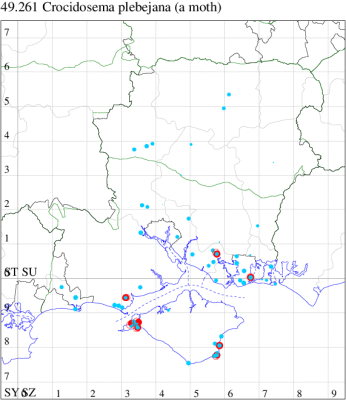
Records by year
Records by week (adult)
Records by week (larval)
Record Details
VC10: Totland, one, 18 Sep (RTe); Freshwater Bay, one, 07 Nov (SDa); Freshwater, larva, one, field observation, in shoot of Malva arborea, 25 Sep (PBa); Bonchurch, one, 17 Jun; one, 19 Jun; one, 20 Jun; one, 22 Oct (JHa); Shanklin Upper Chine, one, 14 Sep (IOu);
VC11: Fareham, one, 17 Nov (KJW); Portsmouth, one, 19 May; one, 24 May; one, 25 May; one, 15 Jul; two, 18 Jul; one, 22 Jul; one, 23 Jul; three, 24 Jul; 10, 29 Jul; one, 30 Jul; four, 31 Jul; three, 05 Aug; two, 06 Aug; two, 07 Aug; one, 09 Aug; one, 13 Aug; one, 18 Aug; one, 23 Aug; one, 24 Aug; two, 25 Aug; four, 26 Aug; five, 01 Sep; five, 02 Sep; one, 06 Sep; three, 07 Sep; 13, 08 Sep; four, 11 Sep; three, 13 Sep; two, 14 Sep; five, 15 Sep; one, 20 Sep; two, 21 Sep; 11, 22 Sep; six, 28 Sep; one, 07 Oct; one, 18 Oct; three, 19 Oct; one, 09 Nov; one, 10 Nov; one, 13 Nov (IRT); Pennington, one, 22 Nov (RFC); Southsea, one, 08 Nov; one, 17 Nov (JRL)
49.263 [B&F: 1188] Pelochrista caecimaculana (Hübner, [1799]) - Nationally Scarce A
Nationally scarce (Na) in dry pastures, downland and waste ground in parts of southern England and southern Wales. In Hampshire apparently always very rare, and the only place where it might be regarded as established is on Portsdown Hill. There is only one recent record from the Isle of Wight, at Shanklin in June 1995. Wingspan 14-20 mm. In general appearance reminiscent of certain Eucosma species, but distinguished by the poorly developed and inconspicuous ocellus which lacks metallic plumbeous edging [Bradley]. Larva feeds within roots of Common Knapweed and Brown Knapweed.
Records prior to 2020
| Vice County | #Records | #Individuals | First Record | Last Record |
|---|---|---|---|---|
| 10 | 1 | 1 | 1995 | 1995 |
| 11 | 17 | 36 | 1986 | 2019 |
2020 records
| Vice County | #Records | #Individuals | Max Quantity |
|---|---|---|---|
| 11 | 2 | 2 | 1 |

Records by year
Records by week (adult)
Records by week (larval)
Record Details
VC11: Catisfield*, one, to actinic, gen det, 25 Jun (ALR det. RJD); Fareham*, one, 25 Jun (ADT det. RJD)
49.264 [B&F: 1202] Eucosma obumbratana (Lienig & Zeller, 1846) - Local
Local on farmland and in rough meadows throughout much of England and Wales. Scattered records in Hampshire and on the Isle of Wight. Wingspan 15-19 mm. The fulvous general coloration and the pale dorsal area of the comparatively narrow forewing are characteristic [Bradley]. Larva feeds within seedheads of Perennial Sow-thistle.
Records prior to 2020
| Vice County | #Records | #Individuals | First Record | Last Record |
|---|---|---|---|---|
| 10 | 15 | 33 | 1880 | 2018 |
| 11 | 54 | 57 | 1975 | 2019 |
| 12 | 86 | 111 | 1996 | 2019 |
2020 records
| Vice County | #Records | #Individuals | Max Quantity |
|---|---|---|---|
| 11 | 4 | 4 | 1 |
| 12 | 7 | 7 | 1 |

Records by year
Records by week (adult)
Records by week (larval)
Record Details
VC11: Ashley, one, to actinic, 23 Jun; one, to actinic, 15 Jun (GCE); Portsmouth, one, 16 Jul; one, 09 Aug (IRT);
VC12: Cholderton, two, 24 Jul (TJN, HE); Goodworth Clatford, one, to actinic, 16 Aug; Wherwell, one, to actinic, 13 Jun; one, to actinic, 13 Jun; Chilbolton, one, to actinic, 14 Jul; Barton Stacey, one, to actinic, 16 Jul (GCE); Basingstoke, one, 06 Aug (MJW); Odiham Common, one, 21 May (DAS)
49.265 [B&F: 1201] Eucosma cana (Haworth, 1811) - Common
Common in rough ground and flower meadows throughout much of the British Isles. In Hampshire and on the Isle of Wight widespread and common, probably under-recorded on the Island. Wingspan 16-22 mm. Differs from E. hohenwartiana by the paler ground colour of the forewing and the distinctive longitudinal striation in the discal area [Bradley]. Larva feeds within flowerheads of Thistle Carduus/Cirsium and Common Knapweed.
Records prior to 2020
| Vice County | #Records | #Individuals | First Record | Last Record |
|---|---|---|---|---|
| 10 | 179 | 351 | 1972 | 2019 |
| 11 | 947 | 1375 | 1971 | 2019 |
| 12 | 766 | 1444 | 1971 | 2019 |
2020 records
| Vice County | #Records | #Individuals | Max Quantity |
|---|---|---|---|
| 10 | 21 | 47 | 13 |
| 11 | 27 | 31 | 3 |
| 12 | 25 | 35 | 4 |

Records by year
Records by week (adult)
Records by week (larval)
Record Details
VC10: West High Down Quarry, one, 07 Aug; Shippards Chine, Compton Bay, six, 16 Jul; Parkhurst Forest, one, 29 Jun; one, 28 Jul; Haseley Manor, one, 09 Jun; 13, 06 Jul; Borthwood Copse, Winford, three, 23 Jun; Shanklin, three, 25 Jun; one, 01 Jul; three, 06 Jul; one, 12 Jul; two, 16 Jul; one, 29 Jul; one, 30 Jul; one, 01 Aug; one, 06 Aug; Borthwood Copse, Winford, two, 23 Jun; Shanklin Upper Chine, one, 08 Aug; Firestone Copse, one, 21 Jul; Brading, one, 18 Jul; Bembridge Fort, two, 06 Aug (IOu);
VC11: Woodlands, New Forest, present, 17 Jun (RBW); Ashley, one, to actinic, 23 Jun; Kings Somborne, two, to actinic, 22 Jul; one, to actinic, 24 Jul; Stockbridge Down NT, two, to actinic, 24 Jul; Ashley, one, to actinic, 23 Jun; one, to actinic, 22 Jul; Kings Somborne, one, to actinic, 15 Jun (GCE); Dibden Purlieu, one, to actinic, 24 Jul; one, to actinic, 31 Jul (RAC); Eastleigh, one, to actinic, 04 Jul (KArb); Ashley, two, to actinic, 15 Jun; Kings Somborne, one, to actinic, 15 Jul; one, to actinic, 15 Jun (GCE); Botley, one, to actinic, 31 May; one, to actinic, 21 May; one, to actinic, 02 Jun; one, to actinic, 17 Jun; one, to actinic, 25 Jun; one, to actinic, 28 Jun; one, to actinic, 02 Jul; one, to actinic, 07 Jul; one, to actinic, 09 Jul; one, to actinic, 15 Jul; one, to actinic, 20 Jul; one, to actinic, 21 Jul (SLB); Portsmouth, three, 08 Jun; one, 25 Jun (IRT);
VC12: Cholderton, one, 17 Jul (TJN, HE); Chilbolton, one, to actinic, 02 Jul (GCE); Anna Valley, Andover, one, 23 Jun; one, 25 Jun (TJN); Wherwell, one, to actinic, 13 Jun; two, to actinic, 29 Jun; Chilbolton, one, to actinic, 16 Jun; one, to actinic, 14 Jul; one, to actinic, 14 Jul; Crawley, one, to actinic, 30 Jun; one, to actinic, 09 Jun; one, to actinic, 30 Jun; Barton Stacey, two, to actinic, 22 Jun; one, to actinic, 25 Jun; two, to actinic, 16 Jul; one, to actinic, 16 Jul; Wonston, one, to actinic, 17 Jul (GCE); Ropley, three, 14 Jun (TJN, LF); Basingstoke, one, 24 Jun (MJW); one, 31 Jul (RHil); Pamber Forest, two, 15 Jun; one, 17 Jun; three, 23 Jun; one, 01 Jul; one, 03 Jul; three, 08 Jul; four, 13 Jul (GJD); Odiham Common, present, 21 May (DAS); Farnborough, one, 20 Jul (KBW)
49.266 [B&F: 1200] Eucosma hohenwartiana ([Denis & Schiffermüller], 1775) - Common
Common in dry open areas and grassland throughout much of the British Isles; rare in Scotland. In Hampshire and on the Isle of Wight widespread and common. Wingspan 15-22 mm. Large specimens of this species may be confused with E. cana but can be distinguished by the darker ground colour of the forewing which lacks longitudinal striations [Bradley]. Formerly conspecific with E. parvulana and E. fulvana, which see. Larva feeds within flowerheads of Common Knapweed.
Records prior to 2020
| Vice County | #Records | #Individuals | First Record | Last Record |
|---|---|---|---|---|
| 10 | 52 | 70 | 1880 | 2019 |
| 11 | 1 | 2 | 2015 | 2015 |
| 12 | 3 | 19 | 2013 | 2015 |
2020 records
| Vice County | #Records | #Individuals | Max Quantity |
|---|---|---|---|
| 10 | 1 | 1 | 1 |
| 11 | 10 | 18 | 8 |
| 12 | 16 | 47 | 16 |
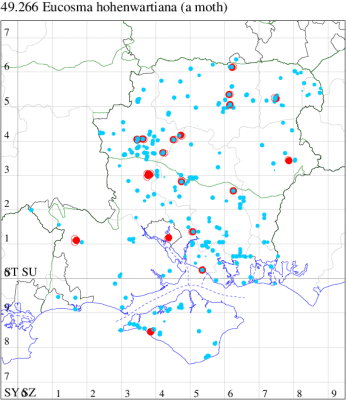
Records by year
Records by week (adult)
Records by week (larval)
Record Details
VC10: Brook, one, 16 Jul (IOu);
VC11: Furze Hill, NF, present, 19 Jul (RBW, MWa); one, 20 Jul (RBW); Ashley, one, to actinic, 23 Jun; eight, to actinic, 23 Jun; two, to actinic, 23 Jun (GCE); Itchen: Peartree Green, present, 21 Jul (PAB); Winchester, one, 07 Aug (THW); Titchfield Haven NNR, one, 17 Jul (F.M.G. det. RJD); Botley, one, to actinic, 31 Jul (SLB); West Meon, three, ♂, gen det, 31 Jul (F.M.G.);
VC12: Cholderton, five, 24 Jul; one, 31 Jul (TJN, HE); Goodworth Clatford, two, to actinic, 19 Jul; one, to actinic, 19 Jul; Wherwell, three, to actinic, 29 Jun; 16, to actinic, 19 Jul; Chilbolton, five, to actinic, 14 Jul; five, to actinic, 14 Jul; Barton Stacey, six, to actinic, 12 Jul; Wonston , one, to actinic, 17 Jul (GCE); Basingstoke, one, 24 Jun (MJW); one, 16 Jul; one, 06 Aug (RHil); Pamber Forest, one, 15 Jun; one, 17 Jun; one, 13 Jul; one, 06 Aug (GJD); Whitehill, one, 12 Jun (ASto); Odiham Common, one, netted, 19 May; one, field observation, 04 Jun (JHH, AMD det. JHH)
49.269 [B&F: 1197] Eucosma campoliliana ([Denis & Schiffermüller], 1775) - Common
Common in dry pastures, sand-dunes and waste ground throughout the British Isles, most numerous in coastal districts. Fairly well distributed in Hampshire, particularly on chalk downland and near the coast, but very rarely recorded on the Isle of Wight. Wingspan 13-18 mm. A distinctive species, characterised by the white ground colour of the forewing and the contrasting, fragmented, ferruginous-ochreous and black markings [Bradley]. Larva feeds within flowerheads of Common Ragwort, over-wintering in a cocoon.
Records prior to 2020
| Vice County | #Records | #Individuals | First Record | Last Record |
|---|---|---|---|---|
| 10 | 96 | 157 | 1900 | 2019 |
| 11 | 479 | 579 | 1975 | 2019 |
| 12 | 118 | 145 | 1971 | 2019 |
2020 records
| Vice County | #Records | #Individuals | Max Quantity |
|---|---|---|---|
| 10 | 7 | 10 | 3 |
| 11 | 12 | 12 | 1 |
| 12 | 7 | 8 | 2 |

Records by year
Records by week (adult)
Records by week (larval)
Record Details
VC10: Cranmore, present, to actinic, 09 Aug (CHic); Kingston, three, 01 Jul (ENes); Haseley Manor, one, 06 Jul; one, 11 Aug; Shanklin, two, 24 Jun; two, 25 Jun; one, 26 Jul (IOu);
VC11: Kings Somborne, one, to actinic, 07 Aug; one, to actinic, 07 Aug (GCE); Dibden Purlieu, one, to actinic, 23 Jun (RAC); Winchester, one, 27 Jun (THW); Catisfield, one, 22 Jun (ALR); Fareham, one, 07 Aug (ADT); Botley, one, to actinic, 17 Jun; one, to actinic, 06 Jul; one, to actinic, 21 Jun; one, to actinic, 25 Jun (SLB); West Meon, one, 31 Jul (F.M.G.); Burton, nr Christchurch, one, 23 Jul (JSw);
VC12: Cholderton, one, 24 Jul (TJN, HE); Chilbolton, one, to actinic, 20 May; Crawley, one, to actinic, 30 Jun; Barton Stacey, one, to actinic, 08 Jun; one, to actinic, 25 Jun; one, to actinic, photograph taken., 08 Jun (GCE); Pamber Forest, two, 13 Jul (GJD); Fleet, one, 06 Aug (AGi); Long Valley, Fleet, one, netted, 20 Jun (JHH, AMD)
49.275 [B&F: 1192] Eucosma conterminana (Guenée, 1845) - Local
Local in dry open areas in parts of southern England. In Hampshire first recorded in the Itchen Valley in 1976, and increasing in the south, where associated with an increase in the foodplant, Prickly Lettuce, and now well-established in the Portsmouth and Southsea area. Has recently started to appear elsewhere in the county (1999 in vice-county 12) and on the Isle of Wight (2004). Wingspan 15-19 mm. The pale yellowish brown general coloration of the forewing and the relatively conspicuous medio-dorsal blotch of light ground colour are characteristic [Bradley]. Larva feeds on flowerheads of Prickly Lettuce, Garden Lettuce and Great Lettuce, over-wintering in a cocoon.
Records prior to 2020
| Vice County | #Records | #Individuals | First Record | Last Record |
|---|---|---|---|---|
| 10 | 8 | 15 | 2004 | 2016 |
| 11 | 65 | 84 | 1995 | 2019 |
| 12 | 9 | 8 | 1994 | 2018 |
2020 records
| Vice County | #Records | #Individuals | Max Quantity |
|---|---|---|---|
| 11 | 3 | 3 | 2 |
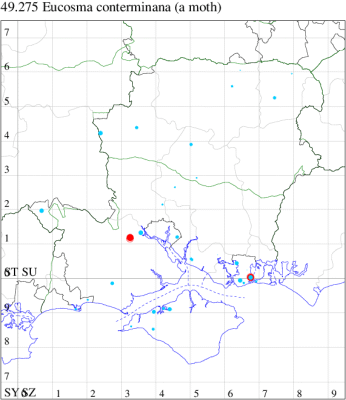
Records by year
Records by week (adult)
Records by week (larval)
Record Details
VC11: Woodlands, New Forest, present, 17 Jun (RBW); Portsmouth, one, 08 Aug; two, 09 Aug (IRT);
VC12: Cholderton, one, 17 Jul (TJN, HE); Ropley*, one, 26 May (TJN, LF)
49.279 [B&F: 1169] Gypsonoma dealbana (Frölich, 1828) - Common
Common in woodland throughout much of the British Isles, but not in northern Scotland. In Hampshire and on the Isle of Wight widespread and common. Wingspan 11-15 mm. The nominate form, in which the forewing markings contrast with the ground colour, is reminiscent of G. sociana but can be distinguished by the cream-white frons and vertex of the head, which in G. sociana are clear white; the coloration of the head also distinguishes G. dealbana from other British Gypsonoma species [Bradley]. Larva feeds within buds and young shoots of Hazel, Hawthorn, Poplar and Sallow, subsequently living within a leaf-fold.
Records prior to 2020
| Vice County | #Records | #Individuals | First Record | Last Record |
|---|---|---|---|---|
| 10 | 102 | 201 | 1900 | 2019 |
| 11 | 683 | 715 | 1958 | 2019 |
| 12 | 284 | 410 | 1976 | 2019 |
2020 records
| Vice County | #Records | #Individuals | Max Quantity |
|---|---|---|---|
| 10 | 4 | 6 | 2 |
| 11 | 26 | 32 | 3 |
| 12 | 4 | 4 | 1 |

Records by year
Records by week (adult)
Records by week (larval)
Record Details
VC10: Brook, one, 16 Jul; Parkhurst Forest, one, gen det, 29 Jun; Shanklin, two, 24 Jun; two, 25 Jun (IOu);
VC11: Totton, one, 23 May; one, 01 Jun; one, 02 Jun; one, 09 Jun (LH); Romsey, one, 30 May (MB); Kings Somborne, one, to actinic, 09 Jul (GCE); Dibden Purlieu, one, to actinic, 25 Jun; one, to actinic, 31 Jul (RAC); Allbrook, one, 02 Jun; one, 15 Jun (SI); Winchester, one, 29 May (THW); Catisfield, two, 23 Jun; three, to actinic, gen det, 25 Jun (ALR det. RJD); Fareham, one, 25 Jun (ADT); one, to actinic, 24 Jun; two, to actinic, 16 Jul; one, to actinic, 17 Jul (MLO); Wickham, three, 07 Aug (F.M.G.); Portsmouth, larval feeding signs, present, field observation, a few, Salix cinerea, 23 Oct (JRL, IRT); one, 17 Jul; one, 31 Jul; one, 01 Aug (IRT); Hen Wood, one, ♂, gen det, 24 Jul (F.M.G.); Sway, two, 24 Jun (SKe); Pennington, one, 02 Jun (RFC);
VC12: Anna Valley, Andover, one, 25 Jun (TJN); Harewood Forest, one, to actinic, 24 Jun; Barton Stacey, one, to actinic, 25 Jun (GCE); Axmansford, one, 23 Jul (ACB); Basingstoke, one, 26 Jun (MJW); Castle Bottom NNR, present, 25 Jun (JHH, AMD); Finchampstead*, one, field observation, 07 Jul; Yateley, one, ♂, gen det, 23 Jun; one, 31 Jul (JHH)
49.280 [B&F: 1170] Gypsonoma oppressana (Treitschke, 1835) - Nationally Scarce B
Nationally scarce (Nb) in woodland edges, parks and gardens throughout England and Wales. Occurs very irregularly in Hampshire: the first Isle of Wight record was in 2015. Wingspan 12-15 mm. The diffuse, coarsely irrorate and farinose appearance of the forewing markings and ground colour are characteristic; and the termen is not sinuate as in other Gypsonoma species [Bradley]. Larva feeds on buds of Black and White Poplar.
Records prior to 2020
| Vice County | #Records | #Individuals | First Record | Last Record |
|---|---|---|---|---|
| 10 | 5 | 5 | 2015 | 2019 |
| 11 | 39 | 38 | 1987 | 2019 |
| 12 | 18 | 17 | 1984 | 2018 |
2020 records
| Vice County | #Records | #Individuals | Max Quantity |
|---|---|---|---|
| 11 | 3 | 3 | 1 |
| 12 | 1 | 1 | 1 |

Records by year
Records by week (adult)
Records by week (larval)
Record Details
VC11: Fareham, one, to actinic, gen det, 02 Jun (MLO det. RJD); Botley, one, to actinic, 25 Jun; one, to actinic, 25 Jun (SLB);
VC12: Basingstoke, one, 24 Jun (RHil)
49.281 [B&F: 1168] Gypsonoma sociana (Haworth, 1811) - Common
Common in woodland, gardens, orchards, parks and on freshwater margins throughout much of Britain. In Hampshire widespread but rather local in all but the east central area, where apparently absent. On the Isle of Wight, there are recent records only from Shanklin and Totland. Wingspan 12-15 mm. Distinguished from other Gypsonoma species by the clear white frons and vertex of the head; the strongly contrasting, plumbeous strigulate with black forewing markings and the white ground colour are also characteristic [Bradley]. Larva feeds within catkins of Black Poplar, Aspen and Sallow, subsequently burrowing into and feeding on leaf buds.
Records prior to 2020
| Vice County | #Records | #Individuals | First Record | Last Record |
|---|---|---|---|---|
| 10 | 15 | 16 | 1900 | 2018 |
| 11 | 138 | 208 | 1977 | 2019 |
| 12 | 130 | 312 | 1984 | 2019 |
2020 records
| Vice County | #Records | #Individuals | Max Quantity |
|---|---|---|---|
| 11 | 5 | 5 | 1 |
| 12 | 10 | 13 | 4 |

Records by year
Records by week (adult)
Records by week (larval)
Record Details
VC11: Timsbury, one, 08 Jun (TRa); Kings Somborne, one, to actinic, 09 Jul; one, to actinic, 15 Jul; one, to actinic, 15 Jul (GCE); Fareham, one, to actinic, gen det, 24 Jun (MLO det. RJD);
VC12: Harewood Forest, one, to actinic, 24 Jun; four, to actinic, 24 Jun; Barton Stacey, one, to actinic, 25 Jun; one, to actinic, 08 Jun; Wonston , one, to actinic, 17 Jul (GCE); Axmansford, one, 13 Jul (ACB det. GJD); Basingstoke, one, 26 Jun (MJW); one, 01 Jun (RHil); Pamber Forest, one, 23 Jun; one, 08 Jul (GJD); Castle Bottom NNR, one, ♂, gen det, 25 Jun (JHH, AMD det. AMD)
49.283 [B&F: 1167] Gypsonoma aceriana (Duponchel, [1843]) - Local
Local in woodland, gardens, orchards and parks throughout much of southern Britain. In Hampshire locally common amongst large poplars, mostly in the south-east, with only occasional scattered records elsewhere, and none on the Isle of Wight in recent years. Wingspan 13-15 mm. Distinguished from G. dealbana by the stronger and more extensive ochreous suffusion of the ground colour, the less angulated, straighter-edged basal patch and the black-centred ochreous apical spot of the forewing [Bradley]. Larva mines leaves and petioles of Poplar, living between leaves and petioles spun together with silk, subsequently burrowing into and feeding on stems.
Records prior to 2020
| Vice County | #Records | #Individuals | First Record | Last Record |
|---|---|---|---|---|
| 10 | 5 | 0 | 1900 | 1997 |
| 11 | 65 | 71 | 1976 | 2019 |
| 12 | 6 | 4 | 1984 | 2018 |
2020 records
| Vice County | #Records | #Individuals | Max Quantity |
|---|---|---|---|
| 11 | 2 | 2 | 1 |

Records by year
Records by week (adult)
Records by week (larval)
Record Details
VC11: Portsmouth, one, 25 Jun; one, 13 Jul (IRT)
49.285 [B&F: 1184] Epiblema scutulana ([Denis & Schiffermüller], 1775) - Common
Common in waste ground and rough meadows throughout much of the British Isles. In Hampshire and on the Isle of Wight widespread and reasonably common, although true status remains uncertain owing to confusion with E. cirsiana, with which formerly treated as conspecific. Wingspan 18-23 mm. The male is very distinctive, but the female may be confused with E. cnicicolana; larger than E. cirsiana with the male characteristically larger and lighter in coloration than the female [Bradley]. Larva feeds within roots and lower stems of Musk Thistle and Spear Thistle.
Records prior to 2020
| Vice County | #Records | #Individuals | First Record | Last Record |
|---|---|---|---|---|
| 10 | 48 | 92 | 1880 | 2017 |
| 11 | 103 | 175 | 1972 | 2018 |
| 12 | 14 | 13 | 1994 | 2017 |
2020 records
| Vice County | #Records | #Individuals | Max Quantity |
|---|---|---|---|
| 10 | 2 | 2 | 1 |
| 12 | 1 | 1 | 1 |
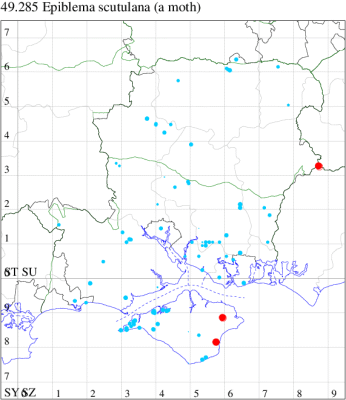
Records by year
Records by week (adult)
Records by week (larval)
Record Details
VC10: Shanklin, one, 06 Jul (IOu); Broadley Copse, one, to actinic, 25 Jun (JBa);
VC12: Alton*, one, 18 Aug (EFig); Hammer Vale, Woolmer*, one, 04 May (ASw det. MJW)
49.286 [B&F: 1184a] Epiblema cirsiana (Zeller, 1843) - Common
Common in a wide range of habitats throughout much of the British Isles. In Hampshire and on the Isle of Wight widespread and fairly common, although true status remains uncertain owing to confusion with E. scutulana, with which formerly treated as conspecific. Wingspan 12-20 mm. This species was until recently considered to be just a small form of E. scutulana, which see. Larva feeds within stems of Marsh Thistle and Common Knapweed.
Records prior to 2020
| Vice County | #Records | #Individuals | First Record | Last Record |
|---|---|---|---|---|
| 10 | 9 | 10 | 1969 | 2015 |
| 11 | 32 | 25 | 1975 | 2015 |
| 12 | 25 | 29 | 1976 | 2019 |
2020 records
| Vice County | #Records | #Individuals | Max Quantity |
|---|---|---|---|
| 11 | 2 | 1 | 1 |
| 12 | 2 | 3 | 2 |

Records by year
Records by week (adult)
Records by week (larval)
Record Details
VC11: Netley Marsh, present, 01 May (PAB); Wildern LNR*, one, field observation, 25 May (TCr det. MJW);
VC12: Chilbolton, two, field observation, freshly emerged mating pair next to knapweed, 15 May (GCE); Old Burghclere, one, field observation, 06 May (GJD)
49.288 [B&F: 1183] Epiblema foenella (Linnaeus, 1758) - Common
Common in rough and waste ground throughout England and Wales. Locally frequent in Hampshire and on the Isle of Wight on waste ground amongst its foodplant, with a marked increase in the number of records in recent years. Wingspan 17-26 mm. The shining white, falcate medio-dorsal blotch on the forewing is characteristic [Bradley]. Larva feeds within stems and roots of Mugwort.
Records prior to 2020
| Vice County | #Records | #Individuals | First Record | Last Record |
|---|---|---|---|---|
| 10 | 13 | 20 | 1900 | 2019 |
| 11 | 237 | 251 | 1971 | 2019 |
| 12 | 154 | 193 | 1990 | 2019 |
2020 records
| Vice County | #Records | #Individuals | Max Quantity |
|---|---|---|---|
| 10 | 2 | 2 | 1 |
| 11 | 9 | 10 | 3 |
| 12 | 1 | 1 | 1 |

Records by year
Records by week (adult)
Records by week (larval)
Record Details
VC10: Shippards Chine, Compton Bay, one, 16 Jul (IOu); Kingston*, one, 16 Jul (ENes);
VC11: Woodlands, New Forest, present, 29 Jul (RBW); Kings Somborne, one, to actinic, 15 Jul (GCE); Bitterne, one, 08 Aug (PAB); Botley, one, to actinic, 06 Aug (SLB); Portsmouth, one, 17 Jun; one, 18 Jul; three, 06 Aug; one, 13 Aug (IRT); Burton, nr Christchurch, one, 23 Jul (JSw);
VC12: Pamber Forest, one, 25 Jun (GJD)
49.289 [B&F: 1187] Epiblema costipunctana (Haworth, 1811) - Common
Common in rough meadows and on waste ground throughout the British Isles. In Hampshire locally frequent, mainly on chalk downland and coastal sandhills; very rare on the Isle of Wight, where recorded at Cranmore in July 1997. Wingspan 13-18 mm. Similar in size and general appearance to E. cnicicolana but distinguished by the better-defined and ferruginous-brown fasciate markings of the forewing, the more sharply defined costal strigulae and the subquadrate medio-dorsal blotch which is weakly strigulate and sometimes connected to the costa by whitish striae [Bradley]. Larva feeds within lower stems and roots of Common Ragwort, over-wintering in a cocoon.
Records prior to 2020
| Vice County | #Records | #Individuals | First Record | Last Record |
|---|---|---|---|---|
| 10 | 15 | 10 | 1856 | 2013 |
| 11 | 81 | 96 | 1971 | 2019 |
| 12 | 31 | 44 | 1971 | 2018 |
2020 records
| Vice County | #Records | #Individuals | Max Quantity |
|---|---|---|---|
| 11 | 2 | 6 | 5 |
| 12 | 2 | 2 | 1 |

Records by year
Records by week (adult)
Records by week (larval)
Record Details
VC11: Romsey, one, 17 Aug (NRJ); Pilley Bailey, NF, five, 03 Aug (RBW, MWa);
VC12: Barton Stacey, one, to actinic, 16 Jul; one, to actinic, 16 Jul (GCE); Odiham Common*, one, netted, ♂ gen det, 19 May (JHH, AMD det. AMD)
49.292 [B&F: 1174] Notocelia cynosbatella (Linnaeus, 1758) - Common
Common in gardens and hedgerows throughout the British Isles. Widespread and common in Hampshire and on the Isle of Wight. Wingspan 16-22 mm. Readily distinguished from other Epiblema species by its yellow labial palpus and characteristic forewing pattern [Bradley]. Larva feeds on various wild and cultivated species of rose, living within a spun or rolled leaf.
Records prior to 2020
| Vice County | #Records | #Individuals | First Record | Last Record |
|---|---|---|---|---|
| 10 | 182 | 274 | 1900 | 2019 |
| 11 | 1384 | 1821 | 1972 | 2019 |
| 12 | 522 | 738 | 1976 | 2019 |
2020 records
| Vice County | #Records | #Individuals | Max Quantity |
|---|---|---|---|
| 10 | 30 | 37 | 3 |
| 11 | 71 | 82 | 4 |
| 12 | 32 | 38 | 3 |

Records by year
Records by week (adult)
Records by week (larval)
Record Summary
VC10: Earliest: Bonchurch, 03 May, 1 (JHa) Latest: Parkhurst Forest, 28 Jul, 1 (IOu) Max count: Shanklin, 26 May, 3 (IOu)
VC11: Earliest: Totton, 01 May, 1 (LH) Latest: Southampton, 12 Jun, 1 (MEdg) Max count: Romsey, 19 May, 4 (SLay)
VC12: Earliest: Pamber Forest, 07 May, 1 (GJD) Latest: Farnborough, 24 Jun, 1 (KBW) Max count: Pamber Forest, 20 May, 3 (GJD)
49.294 [B&F: 1175] Bramble Shoot Moth Notocelia uddmanniana (Linnaeus, 1758) - Common
Common in hedgerows, gardens and woodland throughout the British Isles. Widespread and often fairly common throughout Hampshire and on the Isle of Wight. Wingspan 15-20 mm. Distinguished by the large and conspicuous red-brown or chocolate-brown pre-tornal marking [Bradley]. Larva makes a ragged spinning in shoots of Bramble, Dewberry and Raspberry, living within a spun or rolled leaf.
Records prior to 2020
| Vice County | #Records | #Individuals | First Record | Last Record |
|---|---|---|---|---|
| 10 | 312 | 520 | 1880 | 2019 |
| 11 | 2895 | 3916 | 1972 | 2019 |
| 12 | 637 | 866 | 1971 | 2019 |
2020 records
| Vice County | #Records | #Individuals | Max Quantity |
|---|---|---|---|
| 10 | 33 | 63 | 13 |
| 11 | 88 | 118 | 10 |
| 12 | 42 | 55 | 4 |

Records by year
Records by week (adult)
Records by week (larval)
Record Summary
VC10: Earliest: Sandpit Copse, 20 May, 1 (IOu) Latest: West High Down Quarry, 08 Sep, 1 (IOu) Max count: Borthwood Copse, Winford, 23 Jun, 13 (IOu)
VC11: Earliest: Totton, 20 May, 1 (LH) Latest: Portchester, 08 Sep, 1 (JGe) Max count: Portsmouth, 17 Jun, 10 (IRT)
VC12: Earliest: Yateley, 26 May, 1 (JHH) Latest: Yateley, 17 Aug, 1 (JHH) Max count: Pamber Forest, 17 Jun, 4 (GJD)
49.295 [B&F: 1178] Notocelia roborana ([Denis & Schiffermüller], 1775) - Common
Common in gardens and hedgerows throughout much of the British Isles. In Hampshire widespread and fairly common. There have been no recent records from the Isle of Wight. Wingspan 16-22 mm. This is one of three closely related and difficult to separate species (see E. trimaculana and E. rosaecolana). Differs from E. rosaecolana by the heavier basal patch which is darker and has the outer edge sharply defined and parallel with the termen [Bradley]. Larva feeds on Wild Rose and Cultivated Rose, living within a spun or rolled leaf, over-wintering as an egg.
Records prior to 2020
| Vice County | #Records | #Individuals | First Record | Last Record |
|---|---|---|---|---|
| 10 | 9 | 8 | 1893 | 2018 |
| 11 | 175 | 201 | 1973 | 2019 |
| 12 | 46 | 47 | 1971 | 2015 |
2020 records
| Vice County | #Records | #Individuals | Max Quantity |
|---|---|---|---|
| 11 | 1 | 1 | 1 |

Records by year
Records by week (adult)
Records by week (larval)
Record Details
VC11: Romsey, one, 20 May (MB)
49.297 [B&F: 1177] Notocelia rosaecolana (Doubleday, 1850) - Common
Common in gardens and hedgerows throughout much of Britain and western Ireland. In Hampshire widespread and fairly common. There have been very few recent records from the Isle of Wight. Wingspan 16-20 mm. This is one of three closely related and difficult to separate species (see E. trimaculana and E. roborana). A generally larger species than E. trimaculana with the forewing somewhat broader and the costa more strongly curved; the general coloration of the forewing is lighter while the costal strigulae are finer and more oblique [Bradley]. Larva feeds on Wild Rose and Cultivated Rose, living within a spun or rolled leaf, over-wintering as an egg.
Records prior to 2020
| Vice County | #Records | #Individuals | First Record | Last Record |
|---|---|---|---|---|
| 10 | 42 | 46 | 1900 | 2017 |
| 11 | 389 | 418 | 1971 | 2019 |
| 12 | 82 | 119 | 1971 | 2019 |
2020 records
| Vice County | #Records | #Individuals | Max Quantity |
|---|---|---|---|
| 11 | 12 | 12 | 2 |
| 12 | 3 | 4 | 2 |

Records by year
Records by week (adult)
Records by week (larval)
Record Details
VC11: Marchwood, one, 22 May (CTh); Woodlands, New Forest, present, 02 Jun (RBW); Ashurst, NF, one, 17 May; two, 19 May; one, 31 May; one, 02 Jun; one, 11 Jun (SAB); Totton, one, 16 May; one, 20 May; one, 24 May (LH); Blackfied, one, to lighted window, 15 Jun (PGS); Eastleigh, one, to actinic, 20 May; one, to actinic, 09 Jun; one, to actinic, 17 Jun (KArb); Pennington, one, 08 Aug (RFC);
VC12: Pamber Forest, one, 15 Jun; two, 17 Jun (GJD); Warren Hill, Liss Forest*, one, 14 Jun (RJM)
49.298 [B&F: 1176] Notocelia trimaculana (Haworth, 1811) - Common
Common in hedgerows, gardens and woodland throughout much of the British Isles. In Hampshire widespread but nowhere common, although the larva feeds on hawthorn, most records are at light. There have been no recent records from the Isle of Wight. Wingspan 15-18 mm. This is one of three closely related and difficult to separate species (see E. rosaecolana and E. roborana). Differs from E. rosaecolana by its generally smaller size and comparatively narrow forewing which is somewhat darker in general coloration and has thicker, less oblique costal strigulae [Bradley]. Larva feeds on Hawthorn, living between leaves and shoots spun together with silk, over-wintering as an egg.
Records prior to 2020
| Vice County | #Records | #Individuals | First Record | Last Record |
|---|---|---|---|---|
| 10 | 113 | 195 | 1900 | 2019 |
| 11 | 506 | 742 | 1964 | 2019 |
| 12 | 167 | 252 | 1987 | 2019 |
2020 records
| Vice County | #Records | #Individuals | Max Quantity |
|---|---|---|---|
| 10 | 18 | 29 | 6 |
| 11 | 32 | 32 | 2 |
| 12 | 13 | 14 | 2 |
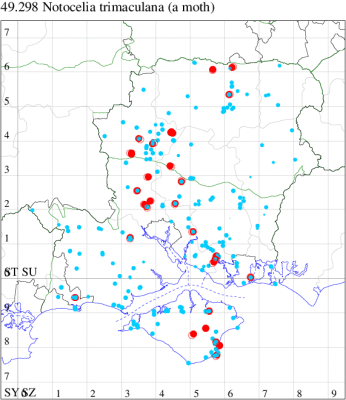
Records by year
Records by week (adult)
Records by week (larval)
Record Details
VC10: Bonchurch, one, 29 May; two, 30 May; one, 19 Jun (JHa); Rookley, one, to actinic, 01 Jul (JBa); Haseley Manor, one, 09 Jun; one, 06 Jul; Shanklin, one, 30 May; one, 02 Jun; one, gen det, 07 Jun; one, 13 Jun; two, 14 Jun; four, 15 Jun; six, 17 Jun; one, 24 Jun; one, 01 Jul; one, 07 Jul; Shanklin Upper Chine, two, 02 Jun; Firestone Copse, one, 21 Jul (IOu);
VC11: Woodlands, New Forest, present, 27 May (RBW); Timsbury, one, 12 Jul (TRa); Romsey, one, 02 Jun; one, 07 Jun (SLay); one, 26 May; one, 07 Jun; one, 09 Jun (MB); Kings Somborne, one, to actinic, 23 Jun (GCE); Romsey, one, 07 Jul (NRJ); Eastleigh, one, to actinic, 12 Jun (KArb); Allbrook, one, 07 Jun (SI); Winchester, two, 29 May; one, 02 Jun (THW); Fareham, one, 15 May; one, 27 May; one, 01 Jun (ADT); one, 16 Jun (IMcP); one, to actinic, 30 May; one, to actinic, 08 Jun (MLO); Botley, one, to actinic, 08 Jun (SLB); Wickham, one, 30 May; one, 31 May (JRDS); Portsmouth, one, 24 May; one, 25 May; one, 26 May; one, 05 Jun; one, 08 Jun; one, 15 Jun (IRT); Burton, nr Christchurch, one, 26 May; one, 02 Jun; one, 09 Jun; one, 12 Jun; one, 23 Jun (JSw); Sway, three, 27 May; one, 29 May; one, 01 Jun; one, 02 Jun; one, 04 Jun; one, 08 Jun; one, 09 Jun; two, 25 Jun (SKe);
VC12: Broughton, one, to actinic, 29 May; two, to actinic, 29 May; Nether Wallop, one, to actinic, 29 May; Chilbolton, one, to actinic, 01 Jun; Goodworth Clatford, one, 30 May; Crawley, one, to actinic, 09 Jun (GCE); Harestock, one, 15 Jun; one, to actinic, 21 Jun (GRog); Barton Stacey, one, to actinic, 19 May; one, to actinic, 08 Jun; one, to actinic, 08 Jun; one, to actinic, 08 Jun (GCE); Axmansford, one, 02 Jun (ACB det. GJD); Basingstoke, one, 26 May (MJW); Pamber Forest, one, 08 Jun (GJD)
49.299 [B&F: 1208] Pseudococcyx posticana (Zetterstedt, 1839) - Nationally Scarce B
Nationally scarce (Nb) in pine woodland and on heathland throughout the British Isles. In Hampshire found mainly in the New Forest where, by dint of hard searching, hollowed-out, resinous buds on the lateral shoots of small Scots pine trees, which hold the larva, can be located — there are very few records in Hampshire outside the New Forest, including just one from north Hampshire. Not recorded from the Isle of Wight to date. Wingspan 11-16 mm. Distinguished from Clavigesta sylvestrana by the light tawny-brown coloration of the labial palps, head, thorax and tegulae, which in C. sylvestrana are grey [Bradley]. Larva feeds on buds of Scots Pine.
Records prior to 2020
| Vice County | #Records | #Individuals | First Record | Last Record |
|---|---|---|---|---|
| 11 | 19 | 14 | 1991 | 2019 |
| 12 | 1 | 1 | 1995 | 1995 |
2020 records
| Vice County | #Records | #Individuals | Max Quantity |
|---|---|---|---|
| 12 | 2 | 2 | 1 |
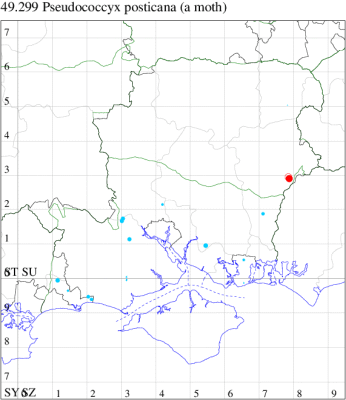
Records by year
Records by week (adult)
Records by week (larval)
Record Details
VC12: Liss Forest*, one, 10 May; one, 10 May (RJM)
49.300 [B&F: 1209] Pine Bud Moth Pseudococcyx turionella (Linnaeus, 1758) - Nationally Scarce B
Nationally scarce (Nb) in pine woodland throughout much of southern England and Scotland. In Hampshire and on the Isle of Wight whilst concentrated in the New Forest, this species has turned up in Scots Pine woodland in other scattered locales. Wingspan 14-21 mm. Reminiscent of Clavigesta purdeyi in general appearance but readily distinguished by its much larger size, the ochreous-orange labial palpi and head and the white, infuscate hindwings [Bradley]. Larva feeds on buds of Scots Pine and Lodgepole Pine, causing some damage by selecting the central bud of a shoot, thereby aborting it.
Records prior to 2020
| Vice County | #Records | #Individuals | First Record | Last Record |
|---|---|---|---|---|
| 10 | 1 | 0 | 1991 | 1991 |
| 11 | 18 | 23 | 1975 | 2016 |
| 12 | 9 | 10 | 1993 | 2012 |
2020 records
| Vice County | #Records | #Individuals | Max Quantity |
|---|---|---|---|
| 12 | 1 | 1 | 1 |
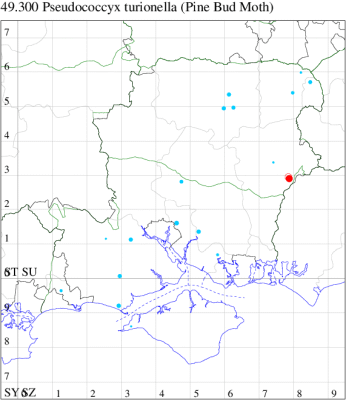
Records by year
Records by week (adult)
Records by week (larval)
Record Details
VC12: Warren Hill, Liss Forest*, one, 08 May (RJM)
49.304 [B&F: 1207] Pine Leaf-mining Moth Clavigesta purdeyi (Durrant, 1911) - Local
Local in pine woodland and plantations throughout much of England and Wales, spreading into southern Scotland. In Hampshire widely distributed, but local and usually uncommon. Not recorded from the Isle of Wight to date. Wingspan 10-12 mm. The smallest of this group of pine-feeding species, C. purdeyi differs from the allied C. sylvestrana by the pronounced ferruginous-ochreous coloration of the forewing [Bradley]. Larva feeds within needles of Scots Pine, Lodgepole Pine and Corsican Pine.
Records prior to 2020
| Vice County | #Records | #Individuals | First Record | Last Record |
|---|---|---|---|---|
| 10 | 10 | 6 | 1900 | 2019 |
| 11 | 182 | 243 | 1972 | 2019 |
| 12 | 26 | 26 | 1983 | 2019 |
2020 records
| Vice County | #Records | #Individuals | Max Quantity |
|---|---|---|---|
| 11 | 5 | 12 | 5 |
| 12 | 3 | 3 | 1 |
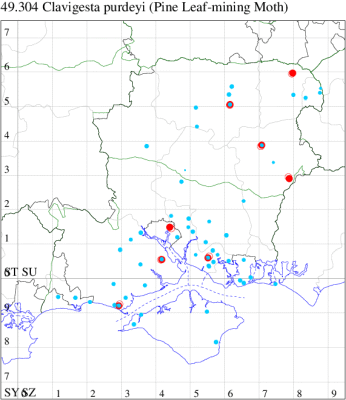
Records by year
Records by week (adult)
Records by week (larval)
Record Details
VC11: Dibden Purlieu, one, to actinic, 09 Aug (RAC); Southampton, two, to actinic, 10 Aug (MGP); Catisfield, one, 07 Aug (ALR); Milford on Sea, three, 22 Aug; five, 26 Aug (MMcM);
VC12: Basingstoke, one, 29 Jul (RHil); Warren Hill, Liss Forest*, one, 18 Jul (RJM); Alton, one, to actinic, 13 Aug (BCA); Castle Bottom NNR, one, to actinic, 16 Aug (JHH)
49.305 [B&F: 1210] Pine Shoot Moth Rhyacionia buoliana ([Denis & Schiffermüller], 1775) - Local
Local in pine woodland, plantations and nurseries throughout much of England and Wales, rare elsewhere. In Hampshire common in Scots Pine woodland, especially in young plantations. Recorded on the Isle of Wight for the first time since 1948 at Cranmore in 2004. Wingspan 16-24 mm. Distinguished from R. pinicolana by the straighter costa, the distinctly orange markings and the triangular pre-tornal marking of the forewing, and the generally darker hindwings [Bradley]. Larva feeds within needles and young shoots of Scots Pine, Lodgepole Pine and Corsican Pine, subsequently burrowing into and feeding on developing buds, causing sufficient damage to be a serious pest in some areas.
Records prior to 2020
| Vice County | #Records | #Individuals | First Record | Last Record |
|---|---|---|---|---|
| 10 | 4 | 3 | 1929 | 2013 |
| 11 | 107 | 123 | 1958 | 2019 |
| 12 | 26 | 24 | 1977 | 2017 |
2020 records
| Vice County | #Records | #Individuals | Max Quantity |
|---|---|---|---|
| 11 | 4 | 4 | 1 |
| 12 | 1 | 1 | 1 |

Records by year
Records by week (adult)
Records by week (larval)
Record Details
VC11: Marchwood, one, 24 Jun (CTh); Ashurst, NF, one, 04 Jul (SAB); Dibden Purlieu, one, to actinic, 11 Aug; one, to actinic, 26 Jun (RAC); Southampton, one, 12 Jul (MEdg);
VC12: Pamber Forest, one, 25 Jun (GJD)
49.306 [B&F: 1211] Rhyacionia pinicolana (Doubleday, 1850) - Common
Common in pine woodland and areas with scattered pine trees throughout England. In Hampshire locally common in woodland of Scots Pine, especially in the New Forest, and on the heaths in the north-east of the county; very rarely recorded on the Isle of Wight. Wingspan 16-23 mm. Differs from Pine Shoot Moth R. buoliana by the more strongly marked costa, the ferruginous-chestnut coloration of the markings and the rounded apex of the pre-tornal marking of the forewing, and the paler hindwing [Bradley]. Larva feeds within needles and young shoots of Scots Pine, but is less likely than R. buoliana to cause the tree serious damage.
Records prior to 2020
| Vice County | #Records | #Individuals | First Record | Last Record |
|---|---|---|---|---|
| 10 | 10 | 8 | 1856 | 2018 |
| 11 | 188 | 191 | 1972 | 2019 |
| 12 | 130 | 175 | 1991 | 2019 |
2020 records
| Vice County | #Records | #Individuals | Max Quantity |
|---|---|---|---|
| 10 | 2 | 2 | 1 |
| 11 | 5 | 9 | 3 |
| 12 | 12 | 24 | 5 |

Records by year
Records by week (adult)
Records by week (larval)
Record Details
VC10: Bonchurch*, one, 25 Jun (JHa); Shanklin*, one, 11 Aug (IOu);
VC11: Brockwood, three, 07 Aug (SDut); Romsey, one, 18 Jul (MB); Allbrook, one, 16 Jul (SI); Sway, one, 25 Jun (SKe);
VC12: Cholderton, one, 17 Jul (TJN, HE); Basingstoke, one, 31 Jul (MJW); Pamber Forest, four, 25 Jun (GJD); Liss Forest, three, 27 Jun; one, 18 Jul; five, 01 Aug (RJM); Whitehill, one, to actinic, 13 Jul; one, to actinic, 16 Jul; one, to actinic, 18 Jul; two, to actinic, 30 Jul (ASto); Castle Bottom NNR, two, 25 Jun (JHH, AMD); Fleet, three, 06 Aug (AGi); Farnborough, one, 27 Jul; one, 10 Aug (KBW)
49.307 [B&F: 1212] Spotted Shoot Moth Rhyacionia pinivorana (Lienig & Zeller, 1846) - Common
Common in pine woodland and areas with scattered pines throughout the British Isles, more numerous in Scotland. Widespread and common in Hampshire. Recorded on the Isle of Wight for the first, and so far only, time at Freshwater in 1985. Wingspan 15-19 mm. The main confusion species is Pine Resin-gall Moth Retinia resinella, which differs in the ferruginous-brown general coloration of the forewing and the lighter hindwings with grey cilia [Bradley], but note that R. resinella is largely absent from southern England. Larva feeds within needles and young shoots of Scots Pine, subsequently burrowing into and feeding on developing buds.
Records prior to 2020
| Vice County | #Records | #Individuals | First Record | Last Record |
|---|---|---|---|---|
| 10 | 7 | 7 | 1985 | 2018 |
| 11 | 217 | 227 | 1975 | 2019 |
| 12 | 111 | 212 | 1980 | 2019 |
2020 records
| Vice County | #Records | #Individuals | Max Quantity |
|---|---|---|---|
| 10 | 2 | 2 | 1 |
| 11 | 5 | 4 | 1 |
| 12 | 15 | 24 | 4 |
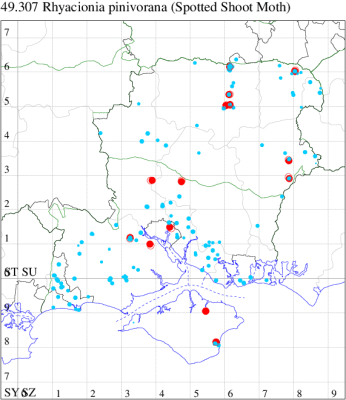
Records by year
Records by week (adult)
Records by week (larval)
Record Details
VC10: Shanklin, one, gen det, 17 Jun; Sandpit Copse, one, gen det, 20 May (IOu);
VC11: Marchwood, one, 26 May (CTh); Woodlands, New Forest, present, 04 Jun (RBW); Kings Somborne, one, to actinic, 21 May (GCE); Southampton, one, to actinic, 27 May (MGP); Winchester, one, 29 May (THW); Sway, one, 17 Jun (SKe);
VC12: Basingstoke, one, 25 May (DLev); one, 24 Jun (MJW); one, 08 May; one, 09 May (RHil); Pamber Forest, three, 25 Jun (GJD); Liss Forest, three, 10 May; three, 21 May; one, 25 May; one, 30 May; one, 06 Jun; four, 14 Jun; one, 27 Jun (RJM); Whitehill, one, to actinic, 08 May; one, to actinic, 27 May (ASto); Yateley, one, 19 May; one, 27 May; one, 21 May (JHH)
49.309 [B&F: 1285] Dichrorampha plumbana (Scopoli, 1763) - Local
Local in rough meadows, dry grassland and waste ground throughout much of the British Isles. In Hampshire widespread, but sparsely recorded away from the extreme south-east, and very infrequent on the Isle of Wight. Wingspan 11-14 mm. Generally smaller than D. sedatana and distinguished by the absence of pale yellow irroration in the basal third of the forewing; D. plumbana is also generally smaller than D. aeratana but is similar in forewing pattern and markings [Bradley]. Larva feeds within roots of Yarrow and Ox-eye Daisy.
Records prior to 2020
| Vice County | #Records | #Individuals | First Record | Last Record |
|---|---|---|---|---|
| 10 | 8 | 4 | 1900 | 2016 |
| 11 | 35 | 38 | 1983 | 2016 |
| 12 | 18 | 15 | 1971 | 2019 |
2020 records
| Vice County | #Records | #Individuals | Max Quantity |
|---|---|---|---|
| 10 | 1 | 4 | 4 |
| 12 | 1 | 1 | 1 |

Records by year
Records by week (adult)
Records by week (larval)
Record Details
VC10: Freshwater Cliffs, four, field observation, 13 May (SDa);
VC12: Basingstoke, one, 24 Jun (MJW)
49.313 [B&F: 1279] Dichrorampha acuminatana (Lienig & Zeller, 1846) - Local
Local on meadows and waste ground throughout much of the British Isles. In Hampshire and on the Isle of Wight widespread but local amongst similar but commoner species which fly with it over the foodplants on sunny afternoons during the summer. Wingspan 10-15 mm. The attenuate shape of the forewing and its dark purplish brown coloration and the sharply demarcated dark grey apices of the cilia are characteristic [Bradley]. Larva feeds within roots of Ox-eye Daisy and Tansy.
Records prior to 2020
| Vice County | #Records | #Individuals | First Record | Last Record |
|---|---|---|---|---|
| 10 | 18 | 32 | 1880 | 2019 |
| 11 | 297 | 328 | 1986 | 2019 |
| 12 | 124 | 166 | 1971 | 2019 |
2020 records
| Vice County | #Records | #Individuals | Max Quantity |
|---|---|---|---|
| 10 | 4 | 6 | 3 |
| 11 | 24 | 28 | 3 |
| 12 | 3 | 6 | 5 |

Records by year
Records by week (adult)
Records by week (larval)
Record Details
VC10: Bonchurch, one, 08 Apr; three, 24 Apr; one, 08 May; one, 25 May (JHa);
VC11: Totton, one, 09 May; one, 24 May; three, 01 Jun; one, 08 Jun; one, 09 Jun; one, 14 Jun; two, 15 Jun; one, 16 Jun; one, 16 Jul; one, 07 Aug; one, 09 Aug; one, 26 Sep (LH); Stanbrige Earls, one, 12 Sep (JRMi); Catisfield, one, 25 May; one, 07 Aug; one, 10 Aug; one, 12 Aug (ALR); Fareham, one, to actinic, 17 Jul; one, to actinic, 06 Aug; two, to actinic, 10 Aug; one, to actinic, 06 Sep (MLO); Botley, one, to actinic, 24 Jul; one, to actinic, 09 May (SLB); Portsmouth, one, 18 Aug (IRT);
VC12: Cholderton, one, 24 Jul (TJN, HE); one, field observation, 22 Aug (TJN, LF); Basingstoke, present, 31 Jul (MJW); Ackender Woods, five, netted, 12 May; Alton, one, to actinic, 07 May (BCA)
49.315 [B&F: 1281] Dichrorampha simpliciana (Haworth, 1811) - Local
Local on waste ground and roadside verges throughout England and Wales, most numerous in the south, and local in Scotland. Probably under-recorded due to its similarity to other related species - and examination of a specimen in new areas is generally required for acceptance - it is known from a number of localities generally on the chalk. One in 2022 on the Island was the first since the 1930s. Wingspan 12-17 mm. One of the largest of the British species of Dichrorampha and distinguished by its comparatively broad wings and grey-brown appearance of the forewing [Bradley]. Larva feeds within roots of Mugwort.
Records prior to 2020
| Vice County | #Records | #Individuals | First Record | Last Record |
|---|---|---|---|---|
| 10 | 2 | 0 | 1880 | 1900 |
| 11 | 93 | 87 | 1980 | 2019 |
| 12 | 42 | 49 | 1988 | 2018 |
2020 records
| Vice County | #Records | #Individuals | Max Quantity |
|---|---|---|---|
| 11 | 1 | 1 | 1 |
| 12 | 3 | 5 | 3 |
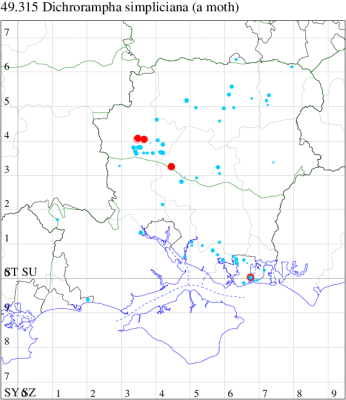
Records by year
Records by week (adult)
Records by week (larval)
Record Details
VC11: Bitterne*, eight, field observation, 08 Aug (PAB); Portsmouth, one, 09 Aug (IRT);
VC12: Anna Valley, Andover*, one, 07 Aug (TJN); Goodworth Clatford*, one, to actinic, 16 Aug; Wherwell*, three, to actinic, 19 Jul; Crawley, one, to actinic, 30 Jul (GCE)
49.316 [B&F: 1278] Dichrorampha sequana (Hübner, [1799]) - Local
Local in dry pastures, gardens, orchards, parks and waste ground throughout southern England and south Wales. In Hampshire fairly widespread, and perhaps under-recorded due to its day-flying habits, but not recorded on the Isle of Wight for many years; apparently readily colonises areas where Yarrow is allowed to thrive. Wingspan 9-11 mm. Day-flying in afternoon sunshine. Recognised by the conspicuous, vertical, cream-white rectangular medio-dorsal blotch of the forewing [Bradley]. Larva feeds within roots of Tansy and Yarrow.
Records prior to 2020
| Vice County | #Records | #Individuals | First Record | Last Record |
|---|---|---|---|---|
| 10 | 4 | 1 | 1880 | 2010 |
| 11 | 43 | 81 | 1975 | 2019 |
| 12 | 33 | 148 | 1971 | 2017 |
2020 records
| Vice County | #Records | #Individuals | Max Quantity |
|---|

Records by year
Records by week (adult)
Records by week (larval)
Record Details
VC12: Up Green Wood, Eversley*, one, netted, ♂, gen det, 07 May; one, at dusk, ♀, gen det, 07 May (JHH det. AMD)
49.318 [B&F: 1284] Dichrorampha vancouverana McDunnough, 1935 - Local
Local in dry grassland, rough meadows, downland and scrub throughout much of Britain, more numerous in the south. In Hampshire and on the Isle of Wight appears to be one of the species which is benefiting from the increase in average summer temperatures in recent years, with a marked increase apparent in the last ten years. Wingspan 10-16 mm. Often found during the afternoon and warm evenings flying around the foodplants. Distinguished from D. alpinana and D. flavidorsana by the sombre general coloration of the forewing, which is suffused with comparatively dull ochreous-orange and has a dull and inconspicuous medio-dorsal blotch [Bradley]. Larva feeds within roots of Yarrow and Tansy.
Records prior to 2020
| Vice County | #Records | #Individuals | First Record | Last Record |
|---|---|---|---|---|
| 10 | 11 | 10 | 1977 | 2013 |
| 11 | 98 | 103 | 1971 | 2019 |
| 12 | 37 | 39 | 1971 | 2017 |
2020 records
| Vice County | #Records | #Individuals | Max Quantity |
|---|---|---|---|
| 11 | 7 | 12 | 6 |
| 12 | 1 | 1 | 1 |

Records by year
Records by week (adult)
Records by week (larval)
Record Details
VC11: Totton, one, 20 Aug (LH); Romsey, one, 26 May (SLay); one, 12 Jul; six, field observation, 13 Jul (MB); Dibden Purlieu, one, to actinic, 24 Jun (RAC); Portsmouth, one, 14 Jul; one, 08 Aug (IRT);
VC12: Farnborough, one, 25 Jun (KBW)
49.320 [B&F: 1274] Dichrorampha alpinana (Treitschke, 1830) - Local
Local in gardens, meadows and rough grassland in southern England and southern Wales. In Hampshire apparently extending its range in recent years, now widespread and generally common, and recorded for the first time on the Isle of Wight at Shanklin in 1996. Wingspan 13-15 mm. The moth flies over the foodplant in late afternoon and evening. Differs from D. flavidorsana by the comparatively broad medio-dorsal blotch of the forewing and the fuscous hindwing which is light basally; in the male the costal fold of the forewing is longer and extends to the median fascia [Bradley]. Larva feeds within roots of Ox-eye Daisy.
Records prior to 2020
| Vice County | #Records | #Individuals | First Record | Last Record |
|---|---|---|---|---|
| 10 | 14 | 14 | 1996 | 2018 |
| 11 | 131 | 142 | 1971 | 2019 |
| 12 | 57 | 75 | 1980 | 2019 |
2020 records
| Vice County | #Records | #Individuals | Max Quantity |
|---|---|---|---|
| 11 | 6 | 9 | 3 |

Records by year
Records by week (adult)
Records by week (larval)
Record Details
VC11: Marchwood, one, 01 Jun; three, 24 Jun (CTh); Totton, one, field observation, 17 Jun (LH); Catisfield, two, gen det, 24 Jun (ALR det. RJD); Fareham, one, to actinic, 01 Jun (MLO); Portsmouth, one, 30 Jul (IRT)
49.321 [B&F: 1273] Dichrorampha petiverella (Linnaeus, 1758) - Common
Common in rough grassland, hedgerows and gardens throughout the British Isles. In Hampshire and on the Isle of Wight locally common, and often found during the late afternoon and evening flying around the foodplants. Wingspan 10-14 mm. The curved, narrow, pale or whitish yellow medio-dorsal blotch of the forewing is characteristic [Bradley]. Larva feeds within roots of Yarrow, Sneezewort and Tansy.
Records prior to 2020
| Vice County | #Records | #Individuals | First Record | Last Record |
|---|---|---|---|---|
| 10 | 42 | 68 | 1856 | 2017 |
| 11 | 79 | 71 | 1974 | 2019 |
| 12 | 60 | 81 | 1971 | 2017 |
2020 records
| Vice County | #Records | #Individuals | Max Quantity |
|---|---|---|---|
| 11 | 5 | 6 | 3 |
| 12 | 5 | 7 | 2 |
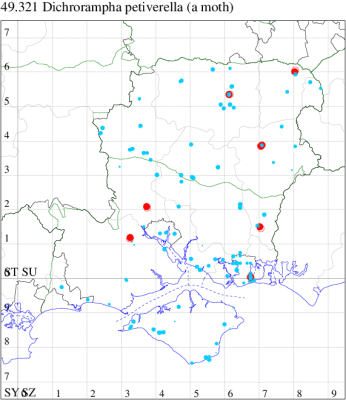
Records by year
Records by week (adult)
Records by week (larval)
Record Details
VC11: Woodlands, New Forest, present, 13 Jun (RBW); Romsey*, three, field observation, 14 Jul (MB); Portsmouth, one, 09 Aug (IRT); Horndean, one, field observation, 22 Jun; one, to actinic, 24 Jun (PHog);
VC12: Cholderton, two, 17 Jul; one, 24 Jul; one, 31 Jul (TJN, HE); Basingstoke, two, field observation, 22 Jun; one, 24 Jun; one, 26 Jun (MJW); Ackender Woods, two, netted, 12 May (BCA); Alton, one, to actinic, 06 Aug (DBO); Yateley*, 20, netted, 21 Jun (JHH)
49.322 [B&F: 1276] Dichrorampha plumbagana (Treitschke, 1830) - Local
Local on dry pastures, downland, waste ground and sand-dunes throughout the British Isles, predominantly coastal in the north of its range. In Hampshire and on the Isle of Wight frequent only in and around Portsea Island. Wingspan 10-15 mm. Flies in afternoon sunshine. The pronounced olive-grey general appearance of the forewing, the dense irroration, the silvery white ground colour, silvery plumbeous striae and obscure fasciate pattern are characteristic [Bradley]. Day-flying habits and preference for Yarrow are shared by the closely related D. sequana, which see. Larva feeds within roots of Yarrow.
Records prior to 2020
| Vice County | #Records | #Individuals | First Record | Last Record |
|---|---|---|---|---|
| 10 | 16 | 11 | 1900 | 2018 |
| 11 | 55 | 90 | 1974 | 2019 |
| 12 | 20 | 17 | 1976 | 2017 |
2020 records
| Vice County | #Records | #Individuals | Max Quantity |
|---|---|---|---|
| 10 | 1 | 1 | 1 |

Records by year
Records by week (adult)
Records by week (larval)
Record Details
VC10: Afton Chalk Pit, one, gen det, 13 May (IOu);
VC12: Odiham Common, one, netted, ♂ gen det, 19 May (JHH, AMD det. AMD)
49.324 [B&F: 1257] Pea Moth Cydia nigricana (Fabricius, 1794) - Common
Common in allotments, market gardens, farmland and rough ground throughout much of Britain, more numerous in the south; rare in Ireland. In Hampshire and on the Isle of Wight until recently a familiar sight in garden peas but now quite rare in some areas. Wingspan 12-16 mm. Distinguished by the overall uniform brown or grey-brown appearance of the forewing, which is finely irrorate with pale ochreous distally and has a poorly developed ocellus and usually conspicuous costal strigulae and interspaces; in the hindwing the white or cream-white cilia are characteristic and contrast strongly with the dark fuscous coloration of the wing; the male is further distinguished by the presence of a dorsal fold along the inner margin [Bradley]. Larva feeds within pods of Pea, Sweet Pea and Common Vetch, causing sufficient damage to be a serious pest in some areas, over-wintering in a silken chamber.
Records prior to 2020
| Vice County | #Records | #Individuals | First Record | Last Record |
|---|---|---|---|---|
| 10 | 8 | 5 | 1856 | 2017 |
| 11 | 64 | 79 | 1975 | 2019 |
| 12 | 27 | 30 | 1990 | 2018 |
2020 records
| Vice County | #Records | #Individuals | Max Quantity |
|---|---|---|---|
| 11 | 2 | 2 | 1 |

Records by year
Records by week (adult)
Records by week (larval)
Record Details
VC11: Totton, one, 23 Jul; one, 24 Jul (LH)
49.325 [B&F: 1255] Cydia ulicetana (Haworth, 1811) - Common
Common on heathland and moorland throughout the British Isles, becoming established even on isolated gorse bushes. Common and widespread in Hampshire and on the Isle of Wight. Wingspan 11-16 mm. Reminiscent of C. splendana in general appearance but differs in its smaller size and the weaker ocellus of the forewing [Bradley]. Larva feeds within seedpods of Gorse and, less frequently, Dyer's Greenweed, Petty Whin, Broom and Bird's-foot Trefoil, over-wintering in a cocoon.
Records prior to 2020
| Vice County | #Records | #Individuals | First Record | Last Record |
|---|---|---|---|---|
| 10 | 109 | 2317 | 1972 | 2019 |
| 11 | 474 | 2080 | 1969 | 2019 |
| 12 | 100 | 862 | 1971 | 2019 |
2020 records
| Vice County | #Records | #Individuals | Max Quantity |
|---|---|---|---|
| 10 | 4 | 11 | 5 |
| 11 | 2 | 4 | 3 |
| 12 | 2 | 2 | 2 |

Records by year
Records by week (adult)
Records by week (larval)
Record Details
VC10: Compton Down, five, 13 May; Bouldnor, four, 25 May; Bouldnor Copse, two, 25 May; Luccombe Down, present, ♂, gen det, 09 May (IOu);
VC11: Portsmouth, three, 12 Aug (IRT); Southsea, one, 29 May (JRL);
VC12: West Down, Chilbolton, present, field observation, 18 May (GCE); Silchester Common, two, 14 Jun (JLe); Liss Common, one, netted, 16 Jun (JHH, AMD); Castle Bottom NNR, present, netted, 18 May; one, to actinic, 16 Aug; Yateley, one, 07 Aug; seven, 12 Aug; one, ♀, gen det, 31 Jul; four, 08 Aug; two, 17 Aug (JHH)
49.330 [B&F: 1269] Cydia conicolana (Heylaerts, 1874) - Nationally Scarce B
Nationally scarce (Nb) in pine woodland and areas with scattered pine trees throughout southern England and southern Wales. There are scattered records from Hampshire with, on average, two records annually in recent years. Not recorded from the Isle of Wight since 1949. Wingspan 10-12 mm. Distinguished from the much rarer C. coniferana by the narrow, transverse, metallic bluish plumbeous antemedian band and the lack of a medio-dorsal blotch [Bradley]. Larva feeds within cones of Scots Pine and Corsican Pine.
Records prior to 2020
| Vice County | #Records | #Individuals | First Record | Last Record |
|---|---|---|---|---|
| 10 | 1 | 1 | 1949 | 1949 |
| 11 | 24 | 37 | 1983 | 2018 |
| 12 | 15 | 11 | 1985 | 2018 |
2020 records
| Vice County | #Records | #Individuals | Max Quantity |
|---|---|---|---|
| 11 | 1 | 1 | 1 |
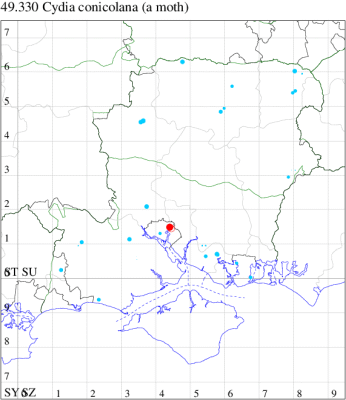
Records by year
Records by week (adult)
Records by week (larval)
Record Details
VC11: Southampton, one, to actinic, 27 May (MGP); Sway, one, photo?, 26 May (SKe)
49.332 [B&F: 1268] Cydia coniferana (Saxesen, 1840) - Nationally Scarce B
Nationally scarce (Nb) in pine woodland in parts of Britain and southern Ireland, where the larva feeds within damaged bark of Scots Pine. In Hampshire widespread in the New Forest and north-eastern heaths, perhaps under-recorded in recent years as there are very few recent records. Not recorded from the Isle of Wight to date. Wingspan 10-14 mm.
Differs from C. conicolana by the presence of a distinct medio-dorsal blotch on the forewing and the better defined black dashes in the ocellus. Similar to C.cognatana (which is confined to Scottish Highlands) from which it cannot be reliably distinguished on external features. C. cosmophorana has solid white marks whereas the white markings of C. coniferana are each more or less divided by a brown line.
Records prior to 2020
| Vice County | #Records | #Individuals | First Record | Last Record |
|---|---|---|---|---|
| 10 | 5 | 5 | 2015 | 2019 |
| 11 | 7 | 5 | 1980 | 2016 |
| 12 | 2 | 2 | 2010 | 2010 |
2020 records
| Vice County | #Records | #Individuals | Max Quantity |
|---|
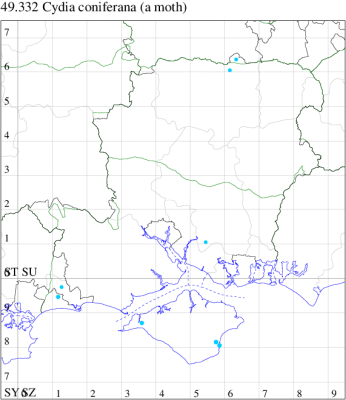
Records by year
Records by week (adult)
Records by week (larval)
Record Details
VC12: Alton*, one, 17 Aug (EFig)
49.338 [B&F: 1261] Codling Moth Cydia pomonella (Linnaeus, 1758) - Common
Common in gardens, orchards and hedgerows throughout the British Isles. Widespread and common in Hampshire and on the Isle of Wight. Wingspan 14-22 mm. Dark specimens of C. splendana are reminiscent of C. pomonella, but the latter is distinguished by the more pronounced, transverse, dark brown strigulation and the large, distinctly coppery ocellus of the forewing [Bradley]. Larva feeds within fruit of Apple, Quince, Pear, Plum, Walnut and Whitebeam, causing sufficient damage to be a serious pest in some areas, over-wintering in a cocoon.
Records prior to 2020
| Vice County | #Records | #Individuals | First Record | Last Record |
|---|---|---|---|---|
| 10 | 226 | 373 | 1856 | 2019 |
| 11 | 3488 | 5729 | 1969 | 2019 |
| 12 | 816 | 1267 | 1988 | 2019 |
2020 records
| Vice County | #Records | #Individuals | Max Quantity |
|---|---|---|---|
| 10 | 10 | 18 | 6 |
| 11 | 120 | 153 | 4 |
| 12 | 32 | 43 | 4 |

Records by year
Records by week (adult)
Records by week (larval)
Record Summary
VC10: Earliest: Rookley, 22 Jun, 1 (JBa) Latest: Kingston, 29 Jul, 1 (ENes) Max count: Shanklin, 24 Jun, 6 (IOu)
VC11: Earliest: Romsey, 08 May, 1 (MB) Latest: Lovedean, 09 Sep, 1 (ARJ) Max count: Romsey, 24 Jun, 4 (SLay)
VC12: Earliest: Basingstoke, 06 May, 1 (DJJ) Latest: Alton, 10 Sep, 1 (DBO) Max count: Basingstoke, 24 Jun, 4 (RHil)
49.341 [B&F: 1260] Cydia splendana (Hübner, [1799]) - Common
Common in oak and other deciduous woodland throughout Britain, most frequent in the south-east. Relatively frequent in Hampshire and the Isle of Wight, wherever there are oak trees. Wingspan 14-22 mm. The well-developed and conspicuous pre-tornal marking and the purplish ocellus distinguish C. splendana from C. fagiglandana. Larva feeds within fruit of Oak and Sweet Chestnut, over-wintering in a cocoon.
Records prior to 2020
| Vice County | #Records | #Individuals | First Record | Last Record |
|---|---|---|---|---|
| 10 | 395 | 2629 | 1893 | 2019 |
| 11 | 2771 | 6782 | 1958 | 2019 |
| 12 | 1075 | 3142 | 1980 | 2019 |
2020 records
| Vice County | #Records | #Individuals | Max Quantity |
|---|---|---|---|
| 10 | 37 | 203 | 28 |
| 11 | 103 | 148 | 10 |
| 12 | 45 | 102 | 10 |

Records by year
Records by week (adult)
Records by week (larval)
Record Summary
VC10: Earliest: Shanklin, 24 Jun, 1 (IOu) Latest: Shanklin, 10 Sep, 2 (IOu) Max count: Shanklin, 09 Aug, 28 (IOu)
VC11: Earliest: Woodlands, New Forest, 07 Jun, 0 (RBW) Latest: Dibden Purlieu, 18 Sep, 1 (RAC) Max count: West Meon, 31 Jul, 10 (F.M.G.)
VC12: Earliest: Farnborough, 23 Jun, 1 (KBW) Latest: Yateley, 08 Sep, 1 (JHH) Max count: Yateley, 08 Aug, 30 (JHH)
49.342 [B&F: 1259] Cydia fagiglandana (Zeller, 1841) - Common
Common in beech and other deciduous woodland throughout much of south-east England. In Hampshire fairly widespread across much of the county, but remains distinctly uncommon on the Isle of Wight. Wingspan 13-19 mm. Similar to C. splendana but differs by the more uniformly grey general appearance of the forewing, the ocellus being comparatively obscure and lacking the dark purplish coloration [Bradley]. Larva feeds within nuts of Beech, over-wintering in a cocoon.
Records prior to 2020
| Vice County | #Records | #Individuals | First Record | Last Record |
|---|---|---|---|---|
| 10 | 38 | 81 | 1975 | 2019 |
| 11 | 442 | 891 | 1975 | 2019 |
| 12 | 277 | 669 | 1980 | 2019 |
2020 records
| Vice County | #Records | #Individuals | Max Quantity |
|---|---|---|---|
| 10 | 4 | 15 | 7 |
| 11 | 50 | 91 | 35 |
| 12 | 31 | 49 | 6 |

Records by year
Records by week (adult)
Records by week (larval)
Record Details
VC10: Parkhurst Forest, seven, 29 Jun; six, 28 Jul; Shanklin, one, 12 Jun; one, 17 Jun (IOu);
VC11: Woodlands, New Forest, present, 20 Jun (RBW); Totton, one, 15 Jun; one, 22 Jun; one, 24 Jun; one, 28 Jun; one, 02 Jul; one, 07 Jul; one, 08 Jul; one, 23 Jul; two, 24 Jul (LH); Romsey, one, 23 Jun; one, 06 Jul; one, 11 Aug (MB); Kings Somborne, one, to actinic, 21 May; one, to actinic, 09 Jul; three, to actinic, 21 May; one, to actinic, 11 Jun; one, to actinic, 09 Jul; one, to actinic, 31 Jul (GCE); Romsey, one, 19 Jun; one, 14 Jul (NRJ); Kings Somborne, one, to actinic, 03 Sep; one, to actinic, 21 May; one, to actinic, 31 Jul; one, to actinic, 21 May; one, to actinic, 21 May; Hursley, one, to actinic, 21 May; Kings Somborne, one, to actinic, 15 Jul (GCE); Southampton, two, to UV, 16 Jul (JVet); Bitterne, present, 10 Jun (PAB); Eastleigh, one, to actinic, 26 May; one, to actinic, 17 Jun; one, to actinic, 23 Jun (KArb); Winchester, one, 26 May; one, 29 May; one, 23 Jun (THW); Catisfield, one, to actinic, 25 Jun (ALR); Fareham, one, to actinic, 01 Jun; one, to actinic, 28 Jun; one, to actinic, 15 Jul; one, to actinic, 23 Jul (MLO); one, 09 May (KJW det. RJD); Hilltop, The Hangers, two, 01 Aug (SI); Portsmouth, one, 17 Jun (IRT); West Meon, two, 31 Jul; Hen Wood, 35, 24 Jul (F.M.G.); Burton, nr Christchurch, one, 29 May; one, 09 Jun; three, 31 Jul (JSw); Sway, one, 17 Jun; one, 24 Jun (SKe); Southsea, one, 02 Jun (JRL);
VC12: Cholderton, five, 17 Jul; present, 24 Jul; present, 31 Jul; one, 08 Aug (TJN, HE); Anna Valley, Andover, one, 20 Jul (TJN); Crawley, one, to actinic, 30 Jun; Barton Stacey, one, to actinic, 12 Jul; two, to actinic, 14 Aug; one, to actinic, 08 Jun; one, to actinic, 16 Jul; one, to actinic, 25 Jun; one, to actinic, 14 Aug; Wonston , one, to actinic, 17 Jul (GCE); Preston Candover*, one, 07 Aug; Basingstoke, two, 27 May; four, 01 Jun; one, 10 Jun; one, 20 Jun; one, 23 Jun; six, 24 Jun; four, 26 Jun; two, 30 Jun; one, to actinic, 27 Jul; one, 31 Jul (MJW); one, 16 Jul; one, 23 Jul; two, 31 Jul; one, 06 Aug (RHil); Alton, three, to actinic, 30 May; one, to actinic, 02 Jun; one, to actinic, 07 Jun; one, to actinic, 31 Jul; one, to actinic, 02 Sep (BCA); two, to actinic, 21 May (DBO); Castle Bottom NNR, present, 25 Jun (JHH, AMD); Farnborough, one, 21 May; one, 04 Jul (KBW); Yateley, four, 09 Jun; 10, 23 Jun; three, 31 Jul; three, 08 Aug (JHH)
49.343 [B&F: 1262] Cydia amplana (Hübner, [1799]) - Migrant
Rare immigrant, appearing in increasing numbers in the West Country, notably at Portland, Dorset. The first authenticated record was from South Devon in 1990. In Hampshire since the first record at Fareham in 1997, recorded increasingly along much of the south coast, appearing in northern Hampshire for the first time in 2008 at Shortheath Common and on the Isle of Wight at Freshwater in 1996. Wingspan 16-20 mm. A highly distinctive and unmistakable species. Larva feeds within nuts of Oak, Hazel, Beech and Walnut.
Records prior to 2020
| Vice County | #Records | #Individuals | First Record | Last Record |
|---|---|---|---|---|
| 10 | 61 | 175 | 1996 | 2019 |
| 11 | 394 | 593 | 1997 | 2019 |
| 12 | 21 | 25 | 2008 | 2019 |
2020 records
| Vice County | #Records | #Individuals | Max Quantity |
|---|---|---|---|
| 10 | 8 | 15 | 3 |
| 11 | 49 | 109 | 13 |
| 12 | 5 | 6 | 2 |

Records by year
Records by week (adult)
Records by week (larval)
Record Details
VC10: Haseley Manor, three, 11 Aug; Shanklin, one, 30 Jul; one, 02 Aug; one, 06 Aug; three, 09 Aug; two, 11 Aug; two, 13 Aug; two, 14 Aug (IOu);
VC11: Marchwood, one, 01 Aug (CTh); Ashurst, NF, one, 08 Aug; one, 10 Aug (SAB); Totton, one, 04 Aug; one, 08 Aug; one, 10 Aug (LH); Romsey, one, 30 Jul; one, 06 Aug; two, 11 Aug; one, 20 Aug (MB); Dibden Purlieu, seven, to actinic, 31 Jul; two, to actinic, 01 Aug; one, to actinic, 02 Aug; one, to actinic, 05 Aug; five, to actinic, 06 Aug; five, to actinic, 07 Aug; six, to actinic, 09 Aug; eight, to actinic, 10 Aug; two, to actinic, 11 Aug; two, to actinic, 12 Aug; one, to actinic, 13 Aug; two, to actinic, 16 Aug; one, to actinic, 17 Aug; one, 21 Aug; one, 23 Aug; one, to actinic, 31 Jul; one, to actinic, 04 Aug; one, to actinic, 05 Aug; two, to actinic, 08 Aug; two, to actinic, 10 Aug; one, to actinic, 16 Aug (RAC); Southampton, one, to actinic, 07 Aug (MGP); Bitterne, two, 08 Aug (PAB); Catisfield, one, 10 Aug (ALR); Fareham, three, 11 Aug (IMcP); one, 10 Aug; one, 11 Aug (KJW); Botley, one, to actinic, 21 Jul; two, to actinic, 09 Aug; two, to actinic, 16 Aug; two, to actinic, 06 Aug (SLB); Portsmouth, one, 24 Jul (IRT); West Walk, one, 14 Aug (F.M.G.); Northney, Hayling Island, present, 07 Aug (JWP); Pennington, two, 30 Jul; two, 07 Aug; seven, 10 Aug; two, 14 Aug; one, 17 Aug (RFC); Norleywood, NF, 13, 09 Aug (RBW, MWa);
VC12: Barton Stacey, one, to actinic, 11 Aug (GCE); Alton, one, to actinic, 15 Aug (BCA); Whitehill, one, to actinic, 18 Jul; two, to actinic, 31 Jul; one, to actinic, 26 Aug (ASto)
49.344 [B&F: 1263] Cydia inquinatana (Hübner, [1799]) - Migrant
Formerly regarded as a very rare immigrant from mainland Europe, this species has been recorded in increasing numbers since the first authenticated British record was made at Minsmere, Suffolk, in 2009 with two further reports from the same county in Bawdsey, June 2010. It has established a breeding population in East Anglia and appears to be spreading. Discovered in the Blackwater area, North Hampshire in 2020 for the first time where it appears to be established. Wingspan 12-16 mm. Larva feeds within fruit of Norway Maple, Field Maple and Sycamore.
Records prior to 2020
| Vice County | #Records | #Individuals | First Record | Last Record |
|---|
2020 records
| Vice County | #Records | #Individuals | Max Quantity |
|---|---|---|---|
| 12 | 1 | 1 | 1 |

Records by year
Records by week (adult)
Records by week (larval)
Record Details
VC12: New Vice-county Record: Blackwater*, one, netted, norway Maple (Primary foodplant) grows at the back of the garden, 11 Jun (BDal)
49.345 [B&F: 1219] Lathronympha strigana (Fabricius, 1775) - Common
Common in open woodland and dry pastures throughout the British Isles, most numerous in southern England. Widespread and common in Hampshire except in the New Forest, where apparently absent. Recorded on the Isle of Wight on only a handful of occasions since the first record in 1977. Wingspan 13-17 mm. A distinctive species, recognised by the orange-ferruginous coloration of the forewing and the absence of fasciate markings [Bradley]. Larva feeds on various species of St John's-wort, living within a spun or rolled leaf.
Records prior to 2020
| Vice County | #Records | #Individuals | First Record | Last Record |
|---|---|---|---|---|
| 10 | 12 | 10 | 1977 | 2019 |
| 11 | 512 | 625 | 1972 | 2019 |
| 12 | 392 | 686 | 1971 | 2019 |
2020 records
| Vice County | #Records | #Individuals | Max Quantity |
|---|---|---|---|
| 11 | 26 | 28 | 3 |
| 12 | 19 | 29 | 6 |

Records by year
Records by week (adult)
Records by week (larval)
Record Details
VC11: Woodlands, New Forest, present, 04 Jun (RBW); Ashurst, NF, one, 10 Aug (SAB); Totton, one, 23 May; one, 29 May; one, 02 Jun; one, 24 Jun; one, 06 Aug; one, 17 Aug (LH); Nursling Old Gravel Pit, one, 11 Jun (PDW); Romsey, one, 18 Aug (MB); Kings Somborne, one, to actinic, 11 Jun; two, to actinic, 21 May; one, to actinic, 31 Jul (GCE); Romsey, one, 29 May (NRJ); Kings Somborne, one, to actinic, 11 Jun; one, to actinic, 07 Aug; three, to actinic, 26 May; one, to actinic, 07 Aug; one, to actinic, 07 Aug (GCE); Dibden Purlieu, one, to actinic, 16 Aug (RAC); Southampton, one, 03 Aug (MEdg); Havant, one, 25 May (JGe); Portsmouth, one, 14 Jun; one, 20 Jun; one, 13 Aug (IRT); Southsea, one, 07 Jul (JGe);
VC12: Cholderton, present, 31 Jul (TJN, HE); one, field observation, 12 Sep (TJN, LF); Stockbridge Down NT, one, field observation, 14 Aug (MDu det. PEH); Chilbolton, one, to actinic, 21 May; one, field observation, 25 May; one, to actinic, 02 Aug; one, to actinic, 04 Aug (GCE); Anna Valley, Andover, two, 04 Aug (TJN); Wherwell, one, to actinic, 13 Jun; one, to actinic, 13 Jun; Chilbolton, one, to actinic, 16 Jun; two, to actinic, 16 Jun; Barton Stacey, six, to actinic, 11 Aug; one, to actinic, 08 Jun; one, to actinic, 25 Jun; Bullington, one, to actinic, 20 Sep (GCE); Ropley, three, 26 May (TJN, LF); Preston Candover, one, 07 Aug; Basingstoke, one, 06 Aug (MJW); Pamber Forest, five, 14 Jun; one, 06 Aug; one, 07 Sep (GJD); Alton, one, to actinic, 22 Aug (BCA)
49.346 [B&F: 1218] Selania leplastriana (Curtis, 1831) - Nationally Scarce A
Nationally scarce (Na) on sea cliffs in parts of southern England. First discovered in our area in 2020, when found to be common on the foodplant at a site near Freshwater Bay, Isle of Wight, and therefore possibly an undiscovered colony. Wingspan 12-14 mm. The large and relatively conspicuous, strigulate medio-dorsal blotch of white ground colour is reminiscent of Cydia jungiella which has similar forewing coloration; S. leplastriana may be distinguished by the distinctly triangular pre-tornal marking which reaches the middle of the wing, and in the male by the darker hindwings which in C. jungiella are white [Bradley]. Larva feeds on Wild Cabbage.
Records prior to 2020
| Vice County | #Records | #Individuals | First Record | Last Record |
|---|
2020 records
| Vice County | #Records | #Individuals | Max Quantity |
|---|---|---|---|
| 10 | 5 | 15 | 8 |
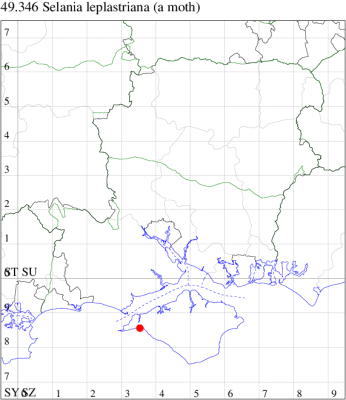
Records by year
Records by week (adult)
Records by week (larval)
Record Details
VC10: New Vice-county Record: Freshwater Bay*, eight, field observation, 16 Sep; two, field observation, 17 Sep; three, field observation, 20 Sep; one, field observation, 21 Sep; one, to actinic, 15 Sep (PBa)
49.347 [B&F: 1241] Grapholita compositella (Fabricius, 1775) - Common
Common in dry grassland and flower meadows throughout much of the British Isles, most frequently in the south. In Hampshire and on the Isle of Wight recorded from all three vice-counties in open country amongst clovers, usually in small numbers but sometimes commonly, chiefly in south-eastern parts of the county, flying late in the afternoon sunshine. Wingspan 8-10 mm. Readily distinguished by its characteristic dorsal blotch which is divided into four white striae [Bradley]. Larva feeds within flowerheads of White Clover and Red Clover, subsequently living within a leaf-fold.
Records prior to 2020
| Vice County | #Records | #Individuals | First Record | Last Record |
|---|---|---|---|---|
| 10 | 12 | 5 | 1856 | 2014 |
| 11 | 108 | 140 | 1972 | 2019 |
| 12 | 15 | 30 | 1976 | 2019 |
2020 records
| Vice County | #Records | #Individuals | Max Quantity |
|---|---|---|---|
| 11 | 2 | 2 | 1 |
| 12 | 1 | 1 | 1 |
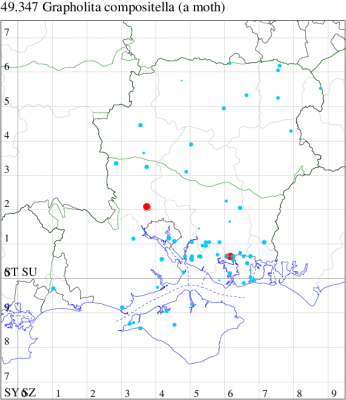
Records by year
Records by week (adult)
Records by week (larval)
Record Details
VC11: Romsey*, one, field observation, seen on Borage, netted and examined, 08 May (MB); Portsdown, one, attracted to blossom, on wild carrot blossom, 20 Jul (RJD)
49.349 [B&F: 1242] Grapholita internana (Guenée, 1845) - Local
Local on heathland and moorland throughout much of Britain, more frequently in the south, and in southern Ireland. In Hampshire and on the Isle of Wight very locally common to abundant amongst gorse, but only recorded for the first time on the Island in 1992. Wingspan 9-10 mm. In both sexes the forewing markings are similar to those of G. pallifrontana, but the black subbasal line in the cilia is interrupted subapically and the general coloration of the wing is lighter than in G. pallifrontana and is irrorate with yellow distally; the male of G. internana is readily distinguished by its white hindwings [Bradley]. Larva feeds within seedpods of Gorse.
Records prior to 2020
| Vice County | #Records | #Individuals | First Record | Last Record |
|---|---|---|---|---|
| 10 | 6 | 5 | 1992 | 2017 |
| 11 | 31 | 273 | 1980 | 2019 |
| 12 | 4 | 2 | 1971 | 2017 |
2020 records
| Vice County | #Records | #Individuals | Max Quantity |
|---|
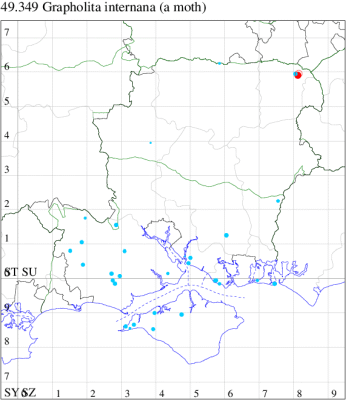
Records by year
Records by week (adult)
Records by week (larval)
Record Details
VC12: Yateley Common, two, netted, ♀, gen det, 08 Jun (JHH det. AMD)
49.350 [B&F: 1240] Grapholita caecana Schläger, 1847 - pRDB3
Rare (proposed as a future Red Data Book species) on chalk downland in parts of southern England. In Hampshire recorded just twice to date, at Leaden Hall in June 2004, and Southsea in June 2005. Not recorded from the Isle of Wight to date. Wingspan 12-16 mm. Distinguished from G. gemmiferana by its comparatively narrow wings and the generally greyer coloration and poorly developed ocellus of the forewing [Bradley]. Larva feeds within stems of Sainfoin, over-wintering in a cocoon.
Records prior to 2020
| Vice County | #Records | #Individuals | First Record | Last Record |
|---|---|---|---|---|
| 11 | 5 | 5 | 1992 | 2015 |
| 12 | 10 | 50 | 2010 | 2019 |
2020 records
| Vice County | #Records | #Individuals | Max Quantity |
|---|---|---|---|
| 11 | 1 | 1 | 1 |

Records by year
Records by week (adult)
Records by week (larval)
Record Details
VC11: Romsey*, one, 16 May (MB)
49.354 [B&F: 1251] Grapholita jungiella (Clerck, 1759) - Common
Common in woodland, downland and scrub throughout much of the British Isles. In Hampshire and on the Isle of Wight widespread and relatively common, although on the Island, restricted to the extreme western end. Wingspan 10-13 mm. Distinguished from G. internana and G. compositella by the paler general coloration of the forewing, the narrow, larger and more strongly curved medio-dorsal blotch and the well-developed ocellus [Bradley]. Larva feeds within seedpods of Bitter Vetchling, Bush Vetch and similar, living between leaves spun together with silk, over-wintering in a cocoon.
Records prior to 2020
| Vice County | #Records | #Individuals | First Record | Last Record |
|---|---|---|---|---|
| 10 | 18 | 8 | 1856 | 2014 |
| 11 | 70 | 96 | 1972 | 2018 |
| 12 | 77 | 393 | 1971 | 2019 |
2020 records
| Vice County | #Records | #Individuals | Max Quantity |
|---|
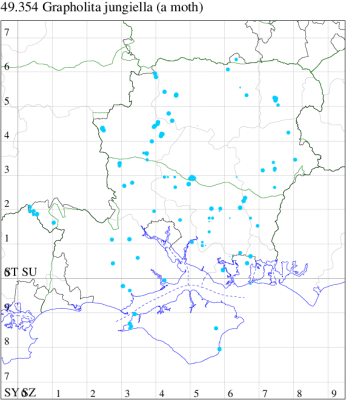
Records by year
Records by week (adult)
Records by week (larval)
Record Details
VC12: Cholderton, 40, field observation, 02 May; seven, field observation, 02 May (TJN)
49.356 [B&F: 1249] Grapholita lobarzewskii (Nowicki, 1860) - Nationally Scarce A
Nationally scarce (Na) in orchards in south-eastern England, where formerly known from only a few sites in Kent. In Hampshire first recorded from Waterlooville in 2003, with further records in the south-eastern corner of the county since. Recorded on the Isle of Wight for the first time at Freshwater in 2011. Wingspan 13-14 mm. Reminiscent of G. janthinana in general appearance but larger, with longer and relatively narrower forewings and darker fuscous-brown hindwings with white cilia. The male of G. lobarzewskii lacks the specialised scales present in the tornal area of the hindwing of G. janthinana [Bradley]. Larva feeds within fruit of Apple and Plum.
Records prior to 2020
| Vice County | #Records | #Individuals | First Record | Last Record |
|---|---|---|---|---|
| 10 | 15 | 17 | 2011 | 2019 |
| 11 | 39 | 36 | 1996 | 2019 |
| 12 | 40 | 48 | 2010 | 2019 |
2020 records
| Vice County | #Records | #Individuals | Max Quantity |
|---|---|---|---|
| 11 | 5 | 7 | 3 |
| 12 | 1 | 2 | 2 |
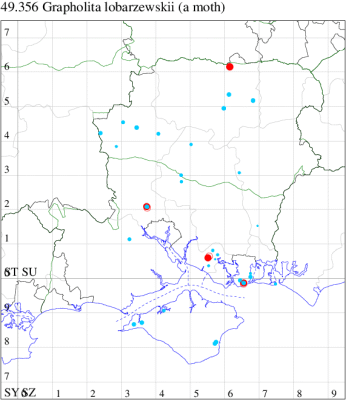
Records by year
Records by week (adult)
Records by week (larval)
Record Details
VC11: Romsey, one, 01 Jun; three, 23 Jun (MB); Catisfield, one, to actinic, 25 Jun (ALR det. RJD); Southsea, one, 21 May; one, 26 May (JRL);
VC12: Pamber Forest*, two, 25 Jun (GJD)
49.357 [B&F: 1247] Plum Fruit Moth Grapholita funebrana Treitschke, 1835 - Local
Local in gardens, orchards and hedgerows throughout much of southern England, southern Wales and southern Ireland. In Hampshire and on the Isle of Wight fairly widespread and not uncommon in gardens where there are plum trees, but apparently largely absent from the New Forest, and on the Island confined to the extreme west. Wingspan 10-15 mm. Similar to G. molesta but generally larger; distinguished from G. tenebrosana by the darker, greyish fuscous labial palpi and frons and the whitish irroration in the distal and medio-dorsal areas of the forewing [Bradley]. Larva feeds within fruit of Plum, Blackthorn, Wild Cherry and similar, over-wintering in a cocoon.
Records prior to 2020
| Vice County | #Records | #Individuals | First Record | Last Record |
|---|---|---|---|---|
| 10 | 7 | 7 | 1980 | 2019 |
| 11 | 124 | 139 | 1986 | 2019 |
| 12 | 67 | 75 | 1995 | 2019 |
2020 records
| Vice County | #Records | #Individuals | Max Quantity |
|---|---|---|---|
| 11 | 12 | 12 | 3 |
| 12 | 1 | 1 | 1 |

Records by year
Records by week (adult)
Records by week (larval)
Record Details
VC11: Woodlands, New Forest, present, 24 Jun (RBW); Fawley By-pass, larva, one, field observation, numerous larvae and feeding damage in fallen fruits of Prunus cerasifera, 28 Jul (PGS); Allbrook, one, 30 May (SI); Fareham, one, 02 Jun; one, 09 Jun; three, 03 Jul; one, 10 Jul; one, 07 Aug (IMcP); Botley, one, to actinic, 03 Jul (SLB); Southsea, one, 01 Jun (JRL);
VC12: Harestock, one, to actinic, 10 Aug; one, to actinic, 15 Aug; one, to actinic, 16 Sep (GRog); Overton, one, 20 May (ACr)
49.359 [B&F: 1245] Grapholita janthinana (Duponchel, 1835) - Common
Common in hedgerows, gardens and woodland edges throughout much of England, Wales and southern Ireland. In Hampshire and on the Isle of Wight perhaps under-recorded away from the south-east of the county. Wingspan 9-11 mm. The comparatively small size, the relatively broad forewing with purplish or pinkish ochreous general coloration and ochreous-yellow admixture along the termen, and in the male the blackish scales and hair-like cilia in the tornal area of the hindwing, are characteristic [Bradley]. Larva feeds within berries of Hawthorn, living between berries spun together with silk, over-wintering in a cocoon.
Records prior to 2020
| Vice County | #Records | #Individuals | First Record | Last Record |
|---|---|---|---|---|
| 10 | 15 | 13 | 1900 | 2019 |
| 11 | 186 | 216 | 1984 | 2019 |
| 12 | 65 | 71 | 1996 | 2019 |
2020 records
| Vice County | #Records | #Individuals | Max Quantity |
|---|---|---|---|
| 10 | 1 | 2 | 2 |
| 11 | 10 | 11 | 2 |
| 12 | 4 | 4 | 1 |
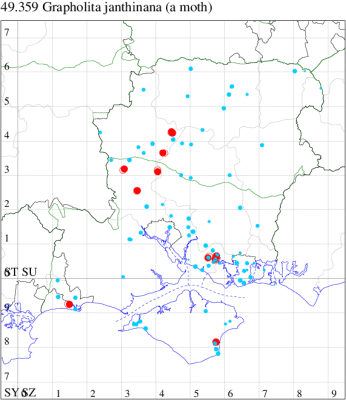
Records by year
Records by week (adult)
Records by week (larval)
Record Details
VC10: Shanklin, two, 25 Jun (IOu);
VC11: Timsbury, one, 19 Jun (TRa det. MJW); Broughton, two, to actinic, 06 Aug; Kings Somborne, one, to actinic, 15 Jul (GCE); Catisfield, one, 24 Jun; one, to actinic, 25 Jun (ALR); Fareham, one, 17 Jul (IMcP); one, to actinic, gen det, 24 Jun; one, to actinic, 30 Jul; one, to actinic, 08 Aug (MLO); Tuckton, Bournemouth, one, 25 Jun (APar); Sway*, one, 25 Jun (SKe);
VC12: Chilbolton, one, to actinic, 14 Jul (GCE); Harestock, three, to actinic, 26 Jun (GRog); Barton Stacey, one, to actinic, 16 Jul; one, to actinic, 25 Jun; one, to actinic, 16 Jul (GCE)
49.363 [B&F: 1228] Pammene argyrana (Hübner, [1799]) - Local
Local in oak woodland throughout much of the British Isles. In south Hampshire, reasonably common in the New Forest and at Botley Wood, with scattered records elsewhere and in the north of the county, where its stronghold is in Pamber Forest; very rare on the Isle of Wight. Wingspan 10-13 mm. Distinguished from P. giganteana by its smaller size, the broader and subquadrate medio-dorsal blotch and in the male by the heavy, sharply demarcated blackish brown border of the hindwing [Bradley]. Larva feeds within the bark of Oak, forming galls.
Records prior to 2020
| Vice County | #Records | #Individuals | First Record | Last Record |
|---|---|---|---|---|
| 10 | 3 | 5 | 1978 | 2019 |
| 11 | 59 | 72 | 1976 | 2019 |
| 12 | 14 | 16 | 1976 | 2019 |
2020 records
| Vice County | #Records | #Individuals | Max Quantity |
|---|---|---|---|
| 10 | 1 | 1 | 1 |

Records by year
Records by week (adult)
Records by week (larval)
Record Details
VC10: West Shanklin*, one, at dusk, gen det, 18 Apr (IOu)
49.365 [B&F: 1229] Pammene albuginana (Guenée, 1845) - Local
Local in oak woodland, broad-leaved woodland and orchards throughout southern England. Widely, but very sparsely, distributed in south Hampshire; very rare in north Hampshire and not recorded in the Isle of Wight until 2016. Wingspan 11-14 mm. Differs from P. argyrana in the darker general coloration and the usually more obscure medio-dorsal blotch of the forewing, and in the male by the more uniformly infuscate hindwing [Bradley]. Larva feeds within bark of Oak, forming galls, and over-wintering as a pupa in a cocoon.
Records prior to 2020
| Vice County | #Records | #Individuals | First Record | Last Record |
|---|---|---|---|---|
| 10 | 3 | 3 | 2016 | 2019 |
| 11 | 44 | 41 | 1983 | 2017 |
| 12 | 10 | 9 | 1980 | 2016 |
2020 records
| Vice County | #Records | #Individuals | Max Quantity |
|---|---|---|---|
| 11 | 2 | 2 | 1 |
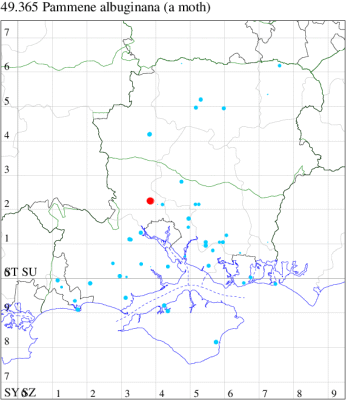
Records by year
Records by week (adult)
Records by week (larval)
Record Details
VC11: Romsey*, one, 18 May (NRJ)
49.367 [B&F: 1236] Pammene fasciana (Linnaeus, 1761) - Common
Local in deciduous, especially oak, woodland, and parkland throughout much of England and Wales, where more widely distributed in the south. In Hampshire common in oak and sweet chestnut woods throughout, but perhaps under-recorded on the Isle of Wight. Wingspan 13-17 mm. The large, subfalcate medio-dorsal blotch, the presence of two or three sometimes contiguous black spots above the pre-tornal marking and the usually extensive series of black dashes in the ocellus are characteristic [Bradley]. Larva feeds within fruit of Sweet Chestnut and Oak, forming spongy galls, and over-wintering in a cocoon.
Records prior to 2020
| Vice County | #Records | #Individuals | First Record | Last Record |
|---|---|---|---|---|
| 10 | 100 | 199 | 1950 | 2019 |
| 11 | 984 | 1678 | 1971 | 2019 |
| 12 | 201 | 382 | 1980 | 2019 |
2020 records
| Vice County | #Records | #Individuals | Max Quantity |
|---|---|---|---|
| 10 | 14 | 54 | 23 |
| 11 | 36 | 41 | 5 |
| 12 | 15 | 21 | 3 |

Records by year
Records by week (adult)
Records by week (larval)
Record Details
VC10: Freshwater Cliffs, one, 09 Aug (SDa); Parkhurst Forest, three, 29 Jun; one, 28 Jul; Haseley Manor, one, 06 Jul; Borthwood Copse, Winford, one, 23 Jun; Shanklin, one, 15 Jun; one, 17 Jun; 23, 24 Jun; 15, 25 Jun; one, 05 Jul; one, 07 Jul; one, 08 Jul; three, 16 Jul; one, 20 Jul (IOu);
VC11: Furze Hill, NF, present, 19 Jul (RBW, MWa); one, 20 Jul (RBW); Godshill, NF, present, 12 Jul (RBW, MWa); Woodlands, New Forest, present, 25 Jun (RBW); Romsey, one, 23 Jun; one, 20 Jul; one, 30 Jul; one, 16 Aug (MB); Dibden Purlieu, one, to actinic, 25 Jun (RAC); Southampton, one, to actinic, 16 Jul (MGP); Eastleigh, one, to actinic, 04 Jul (KArb); Allbrook, one, 24 Jun; one, 04 Jul (SI); Titchfield Haven NNR, one, 17 Jul (F.M.G.); Catisfield, five, to actinic, 25 Jun; one, 01 Jul; one, 16 Jul (ALR); Fareham, one, 24 Jun; two, 03 Jul; one, 10 Jul; one, 17 Jul (IMcP); one, to actinic, 15 Jun; one, to actinic, 09 Jul; one, to actinic, 21 Jul; one, to actinic, 29 Jul; one, to actinic, 30 Jul (MLO); Botley, two, to actinic, 24 Jun; one, to actinic, 13 Jul; one, to actinic, 25 Jun (SLB); Portsmouth, two, 30 Jun; one, 07 Jul (IRT); Burton, nr Christchurch, one, 07 Jul; one, 17 Jul (JSw); Sway, three, 23 Jun; 13, 24 Jun; 13, 25 Jun; one, 29 Jun (SKe); Pennington, two, 24 Jun (RFC); Pilley Bailey, NF, one, 07 Jul (RBW, MWa);
VC12: Anna Valley, Andover, one, 25 Jun (TJN); Wherwell, one, to actinic, 29 Jun; Goodworth Clatford, one, to actinic, 24 Jun; Barton Stacey, one, to actinic, 16 Jul; Wonston, one, to actinic, 17 Jul (GCE); Beech, one, 02 Aug (NDP); Basingstoke, one, 24 Jun; three, 26 Jun (MJW); two, 24 Jun (RHil); Liss Forest, three, 27 Jun; two, 04 Jul; one, 15 Aug; one, 29 Aug (RJM); Hammer Vale, Woolmer, one, 24 Jul; one, 30 Jul; one, 01 Aug (ASw); Farnborough, one, 30 Jun (KBW); Yateley, one, 23 Jun (JHH)
49.375 [B&F: 1234] Pammene regiana (Zeller, 1849) - Common
Common in parks, gardens and woodland throughout the British Isles. Widespread in Hampshire and on the Isle of Wight, but rarely numerous, although cocoons may be found under the bark of old sycamores in numbers during the winter. Wingspan 13-16 mm. Differs from P. trauniana in having the medio-dorsal blotch of the forewing orange-yellow and subfalcate, its outer edge curving to meet the dorsum well before the tornus, the costal strigulae less widely separated by wedges of orange-yellow ground colour and the distinctly metallic bluish striae [Bradley]. Larva feeds within seeds of Sycamore and Norway Maple, over-wintering as a pupa in a cocoon.
Records prior to 2020
| Vice County | #Records | #Individuals | First Record | Last Record |
|---|---|---|---|---|
| 10 | 64 | 90 | 1984 | 2019 |
| 11 | 157 | 170 | 1971 | 2019 |
| 12 | 47 | 48 | 1994 | 2019 |
2020 records
| Vice County | #Records | #Individuals | Max Quantity |
|---|---|---|---|
| 10 | 3 | 11 | 5 |
| 11 | 9 | 10 | 2 |
| 12 | 1 | 1 | 1 |
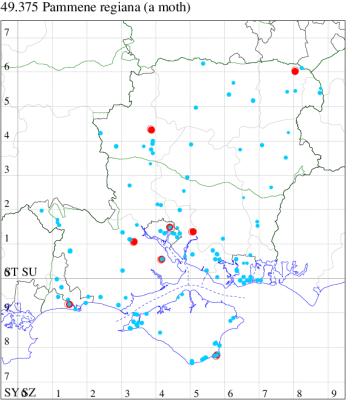
Records by year
Records by week (adult)
Records by week (larval)
Record Details
VC10: Bonchurch, five, 24 Jun; four, 25 Jun; two, 13 Jul (JHa);
VC11: Ashurst, NF, one, 31 Jul (SAB); Dibden Purlieu, one, to actinic, 24 Jun (RAC); Southampton, one, to actinic, 27 May; one, to actinic, 01 Jun; one, to actinic, 23 Jun; two, to actinic, 24 Jun; one, to actinic, 30 Jul (MGP); Botley, one, to actinic, 29 May (SLB); Tuckton, Bournemouth, one, 25 Jun (APar);
VC12: Harewood Forest, one, to actinic, 24 Jun (GCE); Yateley, one, ♂, gen det, 26 May; one, 23 Jun (JHH)
49.376 [B&F: 1233] Pammene aurita Razowski, 1991 - Local
Local in parks, gardens and woodland throughout much of England and Wales, spreading into southern Scotland. In Hampshire and on the Isle of Wight first reported in the county in 1957, this species is now widespread but local. Wingspan 14-15 mm. The ferruginous-orange general coloration and the large pale medio-dorsal blotch are characteristic [Bradley]. The moth comes readily to light. Larva feeds within seeds of Sycamore.
Records prior to 2020
| Vice County | #Records | #Individuals | First Record | Last Record |
|---|---|---|---|---|
| 10 | 66 | 102 | 1977 | 2019 |
| 11 | 172 | 204 | 1978 | 2019 |
| 12 | 64 | 83 | 1994 | 2018 |
2020 records
| Vice County | #Records | #Individuals | Max Quantity |
|---|---|---|---|
| 10 | 7 | 11 | 3 |
| 11 | 25 | 71 | 12 |
| 12 | 4 | 4 | 1 |

Records by year
Records by week (adult)
Records by week (larval)
Record Details
VC10: West High Down Quarry, one, 07 Aug (IOu); Afton Marsh, three, to pheromone lure, to SAL lure, 17 Jul; Potts Plot NT, two, to pheromone lure, to VES lure, 17 Jul (SDa); Wheelers Bay, one, 30 Jul (ABu); Shanklin, two, 01 Aug; Shanklin Upper Chine, one, 31 Jul; one, 08 Aug (IOu);
VC11: Ashurst, NF, one, 12 Aug (SAB); Kings Somborne, one, to actinic, 31 Jul; one, to actinic, 31 Jul; one, to actinic, 07 Aug (GCE); Dibden Purlieu, two, to actinic, 09 Aug; one, to actinic, 10 Aug; one, field observation, 14 Jun; one, to actinic, 25 Jun; two, to actinic, 11 Aug; two, to actinic, 12 Aug (RAC); Southampton, one, to actinic, 24 Jun; one, to actinic, 01 Jul; two, to actinic, 16 Jul; one, to actinic, 17 Jul; two, to actinic, 22 Jul; one, to actinic, 28 Jul; two, to actinic, 30 Jul; two, to actinic, 31 Jul; 11, to actinic, 06 Aug; 10, to actinic, 07 Aug; 12, to actinic, 09 Aug; five, to actinic, 10 Aug; six, to actinic, 11 Aug (MGP); Botley*, one, to actinic, 09 Aug (SLB); Portsmouth, one, 26 Aug (IRT);
VC12: Anna Valley, Andover, one, 30 Jul (TJN); Barton Stacey, one, to actinic, 16 Jul; one, to actinic, 11 Aug; one, to actinic, 14 Aug (GCE); Basingstoke, one, 31 Jul (MJW); Yateley*, one, 31 Jul (JHH)
49.377 [B&F: 1237] Pammene germmana (Hübner, [1799]) - Local
Local in hedgerows and open woodland throughout much of England, in recent years seldom found north of the Midlands. In Hampshire recorded in numbers only in Botley Wood and Pamber Forest, otherwise an uncommon and obscure species. First recorded from the Isle of Wight in 2012. Wingspan 10-14 mm. Day-flying. The satiny black-brown general coloration of the forewing, contrasting with the cream-white ground colour between the costal strigulae, and the bluish metallic striae are characteristic, however confusion with Strophedra weirana is possible [Bradley]. Larva feeds on shoots of Hawthorn, Blackthorn and Oak.
Records prior to 2020
| Vice County | #Records | #Individuals | First Record | Last Record |
|---|---|---|---|---|
| 10 | 9 | 17 | 2012 | 2016 |
| 11 | 56 | 52 | 1974 | 2017 |
| 12 | 41 | 49 | 1993 | 2018 |
2020 records
| Vice County | #Records | #Individuals | Max Quantity |
|---|---|---|---|
| 12 | 2 | 2 | 1 |

Records by year
Records by week (adult)
Records by week (larval)
Record Details
VC12: Basingstoke, one, 26 May; one, 24 Jun (MJW)
49.379 [B&F: 1272] Pammene aurana (Fabricius, 1775) - Common
Common in hedgerows, rough ground and woodland edges throughout the British Isles. In Hampshire and on the Isle of Wight recorded in most years, but not in numbers since the mid 1970s, when numerous in Botley Wood. Wingspan 9-13 mm. Often found resting on flowers of Hogweed on sunny afternoons. The unique forewing pattern readily distinguishes this species [Bradley]. Larva feeds on seeds of Hogweed, living between seeds spun together with silk, and over-wintering in a cocoon.
Records prior to 2020
| Vice County | #Records | #Individuals | First Record | Last Record |
|---|---|---|---|---|
| 10 | 16 | 17 | 1909 | 2018 |
| 11 | 108 | 297 | 1973 | 2019 |
| 12 | 54 | 66 | 1975 | 2018 |
2020 records
| Vice County | #Records | #Individuals | Max Quantity |
|---|---|---|---|
| 10 | 1 | 1 | 1 |
| 11 | 4 | 4 | 1 |
| 12 | 7 | 8 | 2 |

Records by year
Records by week (adult)
Records by week (larval)
Record Details
VC10: Sandown, one, 15 Jun (IOu);
VC11: West Wood, Farley Mount, one, field observation, 01 Jul (CKn); Crab Wood, Winchester, one, 17 Jul (DAS); Twyford, one, attracted to blossom, on hogweed blossom, 15 Jun (RJD); Dundridge, one, 06 Jul (DTr); Old Winchester Hill, one, field observation, 06 Jul (TJN);
VC12: Winchester, present, field observation, 29 Jun (iNat); Ecchinswell*, one, field observation, 22 Jun; one, field observation, 25 Jun; one, field observation, 26 Jun (MJN); Axmansford*, one, field observation, 02 Jun (ACB); Silchester Brook, two, field observation, on hogweed flowers, 13 Jul (GJD); Noar Hill*, one, field observation, 14 Jul (MDu)
49.381 [B&F: 1221] Strophedra weirana (Douglas, 1850) - Local
Local in beech woodland across much of southern England. Fairly widely, but sparsely distributed across much of Hampshire and on the Isle of Wight. Wingspan 10-12 mm. The relatively slender and attenuate forewing and the obscure and poorly defined fasciate markings and costal strigulae distinguish this species from S. nitidana [Bradley]; confusion with Pammene germmana is also possible. Larva feeds on Beech, living between leaves spun together with silk, and over-wintering as a pupa.
Records prior to 2020
| Vice County | #Records | #Individuals | First Record | Last Record |
|---|---|---|---|---|
| 10 | 20 | 41 | 1977 | 2019 |
| 11 | 100 | 157 | 1975 | 2019 |
| 12 | 37 | 53 | 1976 | 2018 |
2020 records
| Vice County | #Records | #Individuals | Max Quantity |
|---|---|---|---|
| 11 | 13 | 18 | 3 |
| 12 | 5 | 7 | 3 |

Records by year
Records by week (adult)
Records by week (larval)
Record Details
VC11: Kings Somborne, one, to actinic, 21 May; three, to actinic, 11 Jun (GCE); Romsey, one, 09 May; one, 18 May (NRJ); Kings Somborne, two, to actinic, 21 May; Hursley, three, to actinic, 21 May; one, to actinic, 11 Jun (GCE); Eastleigh, one, to actinic, 26 May (KArb); Winchester, one, 26 May (THW det. JCl); Kings Somborne, one, to actinic, 26 May; one, to actinic, 26 May (GCE); Hen Wood, one, 24 Jul (F.M.G.);
VC12: Nether Wallop*, one, to actinic, 29 May; Barton Stacey, one, to actinic, 27 May; one, to actinic, 08 Jun; three, to actinic, 08 Jun (GCE); Basingstoke, one, 27 May (MJW)





()(IMG_246).jpg)




()(IMG_5301).jpg)

()().jpg)
()(IMG_5320).jpg)
